Climate Change Impacts
Explore the impacts of climate change with our effects of climate change essay. Learn more about climate change causes, effects, and solutions with the help of our sample. Keep reading to gain inspiration for your essay on climate change and its impact.

Effects of Climate Change: Essay Conclusion
Climate change, climate change impacts, managing climate change, effects of climate change: essay introduction.
It is doubtless that global change has become one the challenges, which encompasses a wide range of human life, including social and economical aspects of human life. Research has indicated that climate change will continue affecting the world as long as proper measures are not taken to protect the environment.
In this line of thought, human activities have been widely blamed for escalating effects of climate change around the world (Hillel & Rosenzweig 2010). Only time will tell whether taming climate change is possible or not.
In this regard, this assessment covers the impact of climate change in our lives today even as world leaders burn midnight oil to develop strategies, aimed at taming the scourge. This proposal topic has an array of benefits, especially in understanding the fatal nature of climate change.
It will mainly focus on the effects of climate change and make proposals on how to counteract the effects of climate together some of the preventive measures being considered by international leaders.
Through literature review, this project will compare different views as argued by different authors in order to synthesize the issue with varying view points. This will be crucial in capturing the main objective of the projects, which revolves around the analysis of the effects of climate change in the world today.
How is climate change defined? Although different environmental experts tend to have different definitions, the Australian Government defines climate change as the weather pattern observed for several years. These changes are mainly caused by human activities, which negatively impact the environment.
With reference to the Intergovernmental Panel on Climate Change (IPCC) report released in the year 2007, climate change is no longer a myth, but a reality, whose impact has continually escalated from 1950s, mainly due to rising levels of greenhouse gases into the atmosphere.
This implies that human activities have significantly contributed this environmental scourge, which continues to affect most parts of the world. The IPCC report was a representation of the world view on climate change, collected from various scientific journals published around the world (Australian Government 2012).
The Australian Department of Climate Change and Energy Efficiency affirms that there is enough evidence to support the fact that the climate system of the earth has continuously been warming. Some of the observations made include the rising level of air in the world and high ocean temperatures. Others are the rising sea level, constant melting of snow and ice in most parts of the world.
One important fact to note about climate change is that it involves the rising temperatures of the climate system holistically, including all the oceans, atmosphere and the cryosphere. These findings concluded that the climate system is in a heating mode.
Even as we review other people’s work, it is important to note that climate change is more than mere global warming as perceived by most people. From scientific revelation, the climate will be varied broadly especially if the warming continues uncontrollably (Australian Government 2012). As a result, the world is likely to experience irregular rainfall patterns, occurrence of severe climatic events like heavy currents and droughts among others.
The impact of climate change has been felt in every part of the world. According to United Nations Framework Convention on Climate Change (UNFCCC), Asia, Africa and Latin America are among the regions of the world, which have severely been affected by the scourge. In a 2010 survey carried out by Climate Change Secretariat, Africa is under the pressure of climate change and remains vulnerable to these effects.
Unlike most parts of the world, Africa experiences varying climatic changes. Common occurrences in Africa are severe droughts and floods, which have had negative implications on the continent’s economy (UNFCCC 2010).
The two events are widely known to predispose famine and overall interference with the socio-well being of the society. According to the UNFCCC’s analysis, close to a third of Africa’s population inhabit drought-prone regions, while more than two million remain vulnerable to drought every year (UNFCCC 2010).
In understanding the implication of climate change in Africa, the survey found out that the issue of climate change is intertwined with several factors, which contribute to its escalation across the continent.
Some of these factors include poverty, weak institutions, illiteracy, lack of information and technology, limited infrastructure, poor accessibility to resources, poor management and conflicts. In addition, there is widespread exploitation of land, which remains a major threat to the climate.
Due to pressure on farming land, most farmers exert pressure through over-cultivation and deforestation. In addition, other factors like dunes and storms continue posing more negative threats to the environment and human beings (UNFCCC 2010).
As a result of these events, the continent experiences drought and overall scarcity of water. Due to this emerging trend, Africa is likely to face shortage of rainfall and overall scarcity of water. With Africa having several trans-boundary river basins, the continent is likely to experience conflicts over these basins. Another important aspect captured in the report is agriculture (UNFCCC 2010).
Since most subsistence farmers in Africa depend on rainfall and irrigation, the sector has been affected by insufficient supply in most Sub-Saharan regions. Besides this, UNFCCC notes that climate change has resulted into loss of agricultural land and a drop in subsistence crop production. With a good percentage of the population under the threat of starvation, climate change has undoubtedly led to escalation of insufficient food supply.
It is amazing to note that climate change has also contributed to the spread of some diseases like malaria, tuberculosis and diarrhea in most parts of Africa. As stated by the UNFCCC, there has been a shift in the distribution of disease vectors.
For instance, migration of mosquitoes to regions of higher altitude is likely to expose people in such regions to the risk of contracting malaria (UNFCCC 2010). Additionally, climate change is likely to result into negative impact on African ecosystems and habitats, which are already threatened by these changes. Due to reduced habitat and changing climatic conditions some species are likely to move to more tolerable regions.
In this line of though Robert Watson, Marufu Zinyowera and Richard Moss found out that climate change can have severe effects on human health. In a research carried out in 1998, the three reiterated that human health may be affected as a result of heat-stress mortality, urban air pollution and vector-borne diseases, which could be favored as a result of change in temperature or rainfall in a given ecosystem (Watson, Zinyowera & Moss 1998, p. 7).
Additionally, Watson, Zinyowera and Moss argued that these effects are commonly felt in developing countries, where lives are lost, communities affected and the cost in medical care rises due to high prevalence of some health complications.
With regard to the impact of climate change on biodiversity, Watson, Zinyowera and Moss, agree with UNFCCC’s findings. In their 1998 survey, the three argued that all ecosystems play a fundamental role in the society (Watson, Zinyowera & Moss 1998).
For instance, they are a source of goods and services to any society. In particular, these goods and services include provision of food, processing and storage of carbon and other nutrients, assimilation of wastes and provision of recreation and tourism opportunities among others.
As a result, they argued that climatic changes are known to alter the geographical local of various ecological systems, including the presence of certain species and their ability to remain productive to support the society. According to their findings, ecological systems are essentially dynamic and are commonly affected by climatic variations of whichever magnitude.
Nevertheless, the extreme to which the climate varies determines the changes, which occur in the ecosystem. In addition, the three authors noted the high level of carbon dioxide in the atmosphere was a major contributing factor towards climate changes taking place in the world today (Watson, Zinyowera & Moss 1998).
Besides influencing the ecosystems, Watson, Zinyowera and Moss noted that climate change may also have secondary effects, say, variations in soil characteristics and interference of regimes. These include diseases, pests and diseases, which are likely to support the existence of some species favorably than others (Watson, Zinyowera & Moss 1998).
This will automatically affect the survival of some species and the overall population of organisms. Similarly, they argued that that climate change has direct impact on food production in most parts of the world. According to the 1998 survey, the type of agricultural systems in place determines the manner in which crop productivity is affected by changes in climatic conditions and patterns.
Like many other scholars, Barrie Pittock spent his life studying the environment and how it is affected by changes in climate. In his 2009, survey, Climate Change: The Science, Impacts and Solutions , Pittock outlined several reasons why there is cause for alarm, regarding climate change in the world today.
According to Pittock, the UNFCCC seeks to reduce the impact of climate change by being on the frontline in the war against global warming (Pittock 2009, p. 107). He further noted that human-induced climate change is a major security threat in the world today. This stance is mainly backed by the well-known effects of climate change described by the UNFCCC and the IPCC.
Moreover, Pittock reiterated that climate change has complex effects in the world today, citing a number of examples. In cases where there is high rainfall resulting from climate change, the world may experience direct or indirect implications.
This could be seen through high or low crop yield, depending on the type of soil or crop. On the other hand, indirect effects may refer to changes in demand and supply, emanating from either low or high yield, depending on other factors. He therefore agreed with several authors and researchers who have enumerated implications of climate change on the environment and human life at large.
For example, Pittock noted that climate change has been a major cause of water shortages in most parts of the world (Pittock 2009, p. 108). He however attributed this to a number of factors, including precipitation decrease in some regions, high rates of evaporation in the world and general loss of glaciers.
Economically, Pittock noted that climate change affects the economic progress of a nation since resources may be diverted to disease control instead of advancing developing projects.
Moreover, it is important to note that most of the countries, which suffer severely as a result of climate change, are poor nations that lack stable economic muscles. As a result, there is a likelihood of richer countries becoming stronger as developing economies weaken further. Lastly, Pittock noted that some of the threats emanating from climate change cause irreversible damages, which end up haunting human beings forever (Pittock 2009, p. 109).
With reference to a number of scholars who have done research on the impact of climate change, it is evident that human activities have a role in the escalation of these effects. In his 2010 survey, Martin Kernan noted that there is a relation between human activities and global warming.
As a result of this global relationship, the world has registered an increase in the concentration of carbon dioxide in the atmosphere. In this survey, he noted that the increase in green house gases is rampant in the northern hemisphere than any other part of the world.
As a result of high temperatures, Martin underscore that the changes have impact on the composition of natural ecosystems, regarding species population and their ability to survive (Kernan 2010, p. 15). What is most evident in Martin’s research is his comparison of the current state of the climate, to what was known hundreds of years ago.
Climate change also affects the quality of water in the United States. According to a research carried out by Robert Mendelsohn and James Neumann, water plays an important role in the life of a human being. Some of these functions include but not limited to power generation, food production, recreation and ecological processes (Mendelsohn & Mendelsohn 2004, p. 133).
However, this is only possible if the water is available and of good quality. Thus, changes in spatial distribution and quality can have direct social and economic effects on the society.
This alteration may occur as a result of increased concentration in greenhouse gases. Climate change can be detected by observing variation in temperatures, frequent and intense droughts and altered precipitation patterns among other factors (Mendelsohn & Mendelsohn 2004, p. 133).
The findings on the impact of climate change on the quality of water have also been pursued by Jan Dam, who argued that natural systems are usually sensitive to changes in climate variation. Hydrological quality is mainly affected by the temperature or concentration of water (Dam 2003, p. 95).
When oceans and other water bodies overheat because of high temperatures, this may result into negative impact on aquatic animals, which adapt to certain hydrological temperatures. Similarly, the quality of water is always altered when gases like carbon dioxide are dissolved in water basins. This may affect the mix of species present in a given ecosystem.
Based on the impact of climate change, it is doubtless that management of the risks has to be effected promptly before they become fatal and irreversible. One of the ways of controlling climate change is through reduction of greenhouse gases in the atmosphere.
This can be achieved through several ways, which minimize the emission of carbon dioxide into the atmosphere (McCarthy 2001, p. 222). According to James McCarthy, this can be realized by adopting alternative sources of energy unlike how most economies rely of oil and petroleum products as the main source of energy. Additionally, good methods of farming are important to maintain the value of the environment for sustainable support.
Use of international legislations is also necessary in ensuring that rich countries do not exploit developing nations as they are major contributors of effluents into the atmosphere (Hillel & Rosenzweig 2010). Above all, the fight against climate change calls for environmental campaign, which requires the efforts of everybody in the world.
From the above review of literature, it is clear that climate change is a major socio and environmental issue affecting the world today. Mainly caused by human activities, climate change poses a chain of challenges and threats to the environment.
For instance, there are several diseases, which affect human beings as a result of climate change (Rosenberg & Edmonds 2005). Of importance is also the alteration of the quality of the natural environment, which affects biodiversity. This has led to the extinction of some species, while others have increased exponentially in numbers.
Moreover, it is imperative to note that some of the occurrences, which are considered to be natural, are caused by climate change. Common ones include floods and draughts (Faure, Gupta & Nentjes 2003, p. 340).
Most of these calamities continue to be recognized as natural disasters yet they can be controlled using simple mitigation measures. In most cases, adoption of renewable sources of energy has always been considered to be the most important way of saving the world from climate change. Although it is a complex issue to handle, joint global efforts are important in making progress.
Australian Government 2012, Impacts of climate change .
Dam, J 2003, Impacts of Climate Change and Climate Variability on Hydrological Regimes , Cambridge University Press, Cambridge, England.
Faure, M, Gupta, J & Nentjes, A 2003, Climate Change and the Kyoto Protocol: The Role of Institutions and Instruments to Control Global Change , Edward Elgar Publishing, United Kingdom.
Hillel, D & Rosenzweig, C 2010, Handbook of Climate Change and Agroecosystems: Impacts, Adaptation, and Mitigation , World Scientific, Singapore.
Kernan, M 2010, Climate Change Impacts on Freshwater Ecosystems , John Wiley & Sons, New Jersey.
Mendelsohn, R & Neumann, J 2004, The Impact Of Climate Change On The United States Economy , Cambridge University Press, Cambridge, England.
Pittock, B 2009, Climate Change: The Science, Impacts and Solutions , Csiro Publishing, Sydney.
Rosenberg, N, & Edmonds, J 2005, Climate Change Impacts for the Conterminous USA: An Integrated Assessment , Springer, New York.
UNFCCC 2010, Climate Change: Impacts, Vulnerabilities and Adaptation In Developing Countries.
Watson, R, Zinyowera, M & Moss, R 1998, The Regional Impacts of Climate Change: An Assessment of Vulnerability , Cambridge University Press, Cambridge, England.
Cite this paper
- Chicago (N-B)
- Chicago (A-D)
StudyCorgi. (2020, January 8). Climate Change Impacts. https://studycorgi.com/climate-change-impacts/
"Climate Change Impacts." StudyCorgi , 8 Jan. 2020, studycorgi.com/climate-change-impacts/.
StudyCorgi . (2020) 'Climate Change Impacts'. 8 January.
1. StudyCorgi . "Climate Change Impacts." January 8, 2020. https://studycorgi.com/climate-change-impacts/.
Bibliography
StudyCorgi . "Climate Change Impacts." January 8, 2020. https://studycorgi.com/climate-change-impacts/.
StudyCorgi . 2020. "Climate Change Impacts." January 8, 2020. https://studycorgi.com/climate-change-impacts/.
This paper, “Climate Change Impacts”, was written and voluntary submitted to our free essay database by a straight-A student. Please ensure you properly reference the paper if you're using it to write your assignment.
Before publication, the StudyCorgi editorial team proofread and checked the paper to make sure it meets the highest standards in terms of grammar, punctuation, style, fact accuracy, copyright issues, and inclusive language. Last updated: October 7, 2022 .
If you are the author of this paper and no longer wish to have it published on StudyCorgi, request the removal . Please use the “ Donate your paper ” form to submit an essay.
What Are the Effects of Climate Change?
A rapidly warming planet poses an existential threat to all life on earth. Just how bad it gets depends on how quickly we act.

An area flooded by Super Typhoon Noru in the Bulacan Province of the Philippines, September 26, 2022
Rouelle Umali/Xinhua via Getty Images

- Share this page block
Climate change is our planet’s greatest existential threat . If we don’t limit greenhouse gas emissions from the burning of fossil fuels, the consequences of rising global temperatures include massive crop and fishery collapse, the disappearance of hundreds of thousands of species, and entire communities becoming uninhabitable. While these outcomes may still be avoidable, climate change is already causing suffering and death. From raging wildfires and supercharged storms, its compounding effects can be felt today, outside our own windows.
Understanding these impacts can help us prepare for what’s here, what’s avoidable, and what’s yet to come, and to better prepare and protect all communities. Even though everyone is or will be affected by climate change, those living in the world’s poorest countries—which have contributed least to the problem—are the most climate-vulnerable. They have the fewest financial resources to respond to crises or adapt, and they’re closely dependent on a healthy, thriving natural world for food and income. Similarly, in the United States, it is most often low-income communities and communities of color that are on the frontlines of climate impacts. And because climate change and rising inequality are interconnected crises, decision makers must take action to combat both—and all of us must fight for climate justice. Here’s what you need to know about what we’re up against.
Effects of climate change on weather
Effects of climate change on the environment, effects of climate change on agriculture, effects of climate change on animals, effects of climate change on humans, future effects of climate change.
As global temperatures climb, widespread shifts in weather systems occur, making events like droughts , hurricanes , and floods more intense and unpredictable. Extreme weather events that may have hit just once in our grandparents’ lifetimes are becoming more common in ours. However, not every place will experience the same effects: Climate change may cause severe drought in one region while making floods more likely in another.
Already, the planet has warmed 1.1 degrees Celsius (1.9 degrees Fahrenheit) since the preindustrial era began 250 years ago, according to the Intergovernmental Panel on Climate Change (IPCC) . And scientists warn it could reach a worst-case scenario of 4 degrees Celsius (7.2 degrees Fahrenheit) by 2100 if we fail to tackle the causes of climate change —namely, the burning of fossil fuels (coal, oil, and gas) .
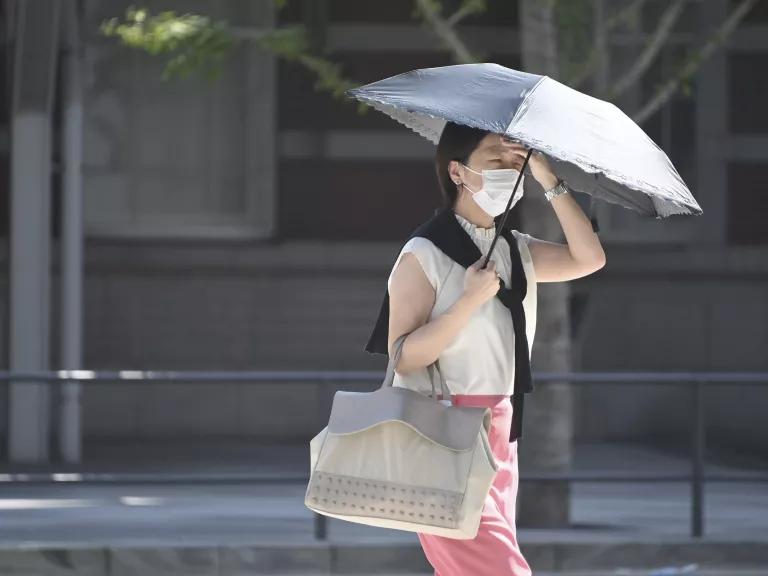
Tokyo during a record-breaking heat wave, August 13, 2020
The Yomiuri Shimbun via AP Images
Higher average temperatures
This change in global average temperature—seemingly small but consequential and climbing—means that, each summer, we are likely to experience increasingly sweltering heat waves. Even local news meteorologists are starting to connect strings of record-breaking days to new long-term trends, which are especially problematic in regions where infrastructure and housing have not been built with intensifying heat in mind. And heat waves aren’t just uncomfortable—they’re the leading cause of weather-related fatalities in the United States.
Longer-lasting droughts
Hotter temperatures increase the rate at which water evaporates from the air, leading to more severe and pervasive droughts . Already, climate change has pushed the American West into a severe “megadrought”—the driest 22-year stretch recorded in at least 1,200 years—shrinking drinking water supplies, withering crops , and making forests more susceptible to insect infestations. Drought can also create a positive feedback loop in which drier soil and less plant cover cause even faster evaporation.
More intense wildfires
This drier, hotter climate also creates conditions that fuel more vicious wildfire seasons—with fires that spread faster and burn longer—putting millions of additional lives and homes at risk. The number of large wildfires doubled between 1984 and 2015 in the western United States. And in California alone, the annual area burned by wildfires increased 500 percent between 1972 and 2018.
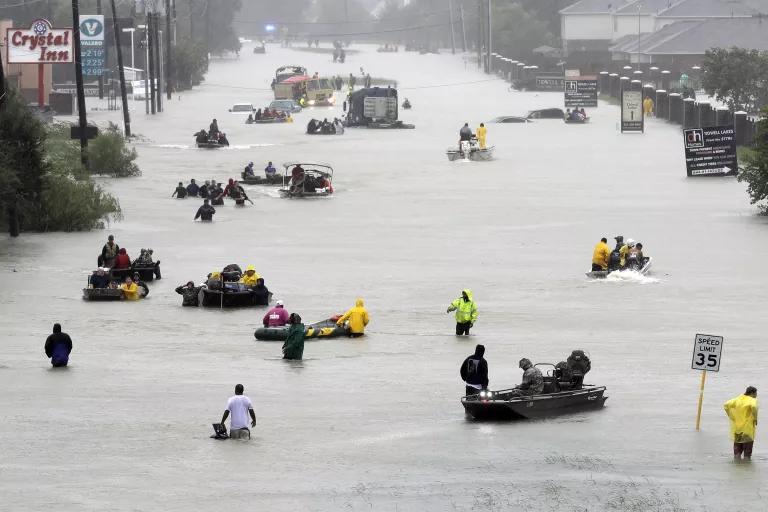
Evacuation after Hurricane Harvey in Houston, August 28, 2017
David J. Phillip/AP Photo
Stronger storms
Warmer air also holds more moisture, making tropical cyclones wetter, stronger, and more capable of rapidly intensifying. In the latest report from the IPCC , scientists found that daily rainfall during extreme precipitation events would increase by about 7 percent for each degree Celsius of global warming, increasing the dangers of flooding . The frequency of severe Category 4 and 5 hurricanes is also expected to increase. In 2017, Hurricane Harvey, a devastating Category 4 storm, dumped a record 275 trillion pounds of rain and resulted in dozens of deaths in the Houston area.
From the poles to the tropics, climate change is disrupting ecosystems. Even a seemingly slight shift in temperature can cause dramatic changes that ripple through food webs and the environment.
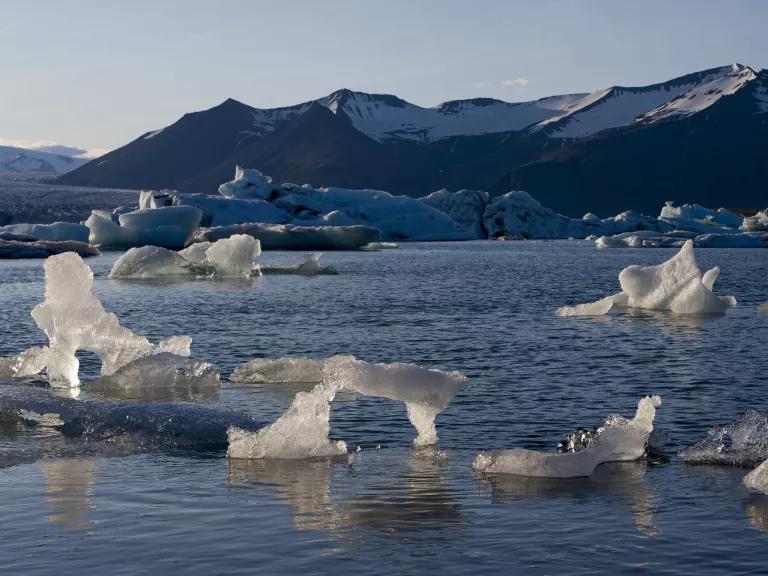
The lake at Jökulsárlón, a glacial lagoon in Iceland, which has grown because of continued glacial melting
Eskinder Debebe/UN Photo
Melting sea ice
The effects of climate change are most apparent in the world’s coldest regions—the poles. The Arctic is heating up twice as fast as anywhere else on earth, leading to the rapid melting of glaciers and polar ice sheets, where a massive amount of water is stored. As sea ice melts, darker ocean waters that absorb more sunlight become exposed, creating a positive feedback loop that speeds up the melting process. In just 15 years, the Arctic could be entirely ice-free in the summer.
Sea level rise
Scientists predict that melting sea ice and glaciers, as well as the fact that warmer water expands in volume, could cause sea levels to rise as much as 3.61 feet by the end of the century, should we fail to curb emissions. The extent (and pace) of this change would devastate low-lying regions, including island nations and densely populated coastal cities like New York City and Mumbai.
But sea level rise at far lower levels is still costly, dangerous, and disruptive. According to the 2022 Sea Level Rise Technical Report from the National Ocean Service, the United States will see a foot of sea level rise by 2050, which will regularly damage infrastructure, like roads, sewage treatment plants, and even power plants . Beaches that families have grown up visiting may be gone by the end of the century. Sea level rise also harms the environment, as encroaching seawater can both erode coastal ecosystems and invade freshwater inland aquifers, which we rely on for agriculture and drinking water. Saltwater incursion is already reshaping life in nations like Bangladesh , where one-quarter of the lands lie less than 7 feet above sea level.
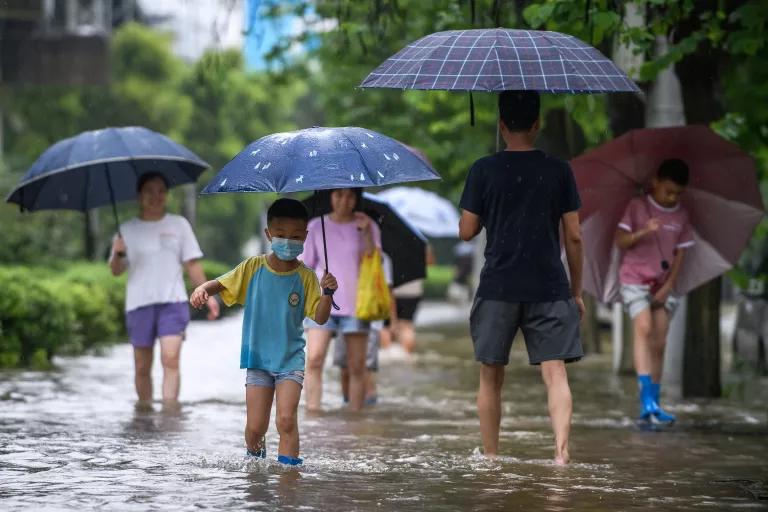
A waterlogged road, caused by rainstorm and upstream flood discharge, in the Shaoguan, Guangdong Province of China, June 21, 2022
Stringer/Anadolu Agency via Getty Images
In addition to coastal flooding caused by sea level rise, climate change influences the factors that result in inland and urban flooding: snowmelt and heavy rain. As global warming continues to both exacerbate sea level rise and extreme weather, our nation’s floodplains are expected to grow by approximately 45 percent by 2100. In 2022, deadly flooding in Pakistan—which inundated as much as a third of the country—resulted from torrential rains mixed with melting glaciers and snow.
Warmer ocean waters and marine heat waves
Oceans are taking the brunt of our climate crisis. Covering more than 70 percent of the planet’s surface, oceans absorb 93 percent of all the heat that’s trapped by greenhouse gases and up to 30 percent of all the carbon dioxide emitted from burning fossil fuels.
Temperature-sensitive fish and other marine life are already changing migration patterns toward cooler and deeper waters to survive, sending food webs and important commercial fisheries into disarray. And the frequency of marine heat waves has increased by more than a third . These spikes have led to mass die-offs of plankton and marine mammals.
To make matters worse, the elevated absorption of carbon dioxide by the ocean leads to its gradual acidification , which alters the fundamental chemical makeup of the water and threatens marine life that has evolved to live in a narrow pH band. Animals like corals, oysters, and mussels will likely feel these effects first, as acidification disrupts the calcification process required to build their shells.
Ecosystem stressors
Land-based ecosystems—from old-growth forests to savannahs to tropical rainforests—are faring no better. Climate change is likely to increase outbreaks of pests, invasive species, and pathogen infections in forests. It’s changing the kinds of vegetation that can thrive in a given region and disrupting the life cycles of wildlife, all of which is changing the composition of ecosystems and making them less resilient to stressors. While ecosystems have the capacity to adapt, many are reaching the hard limits of that natural capacity . More repercussions will follow as temperatures rise.
Climate change appears to be triggering a series of cascading ecological changes that we can neither fully predict nor, once they have enough momentum, fully stop. This ecosystem destabilization may be most apparent when it comes to keystone species that have an outsize- role in holding up an ecosystem’s structure.
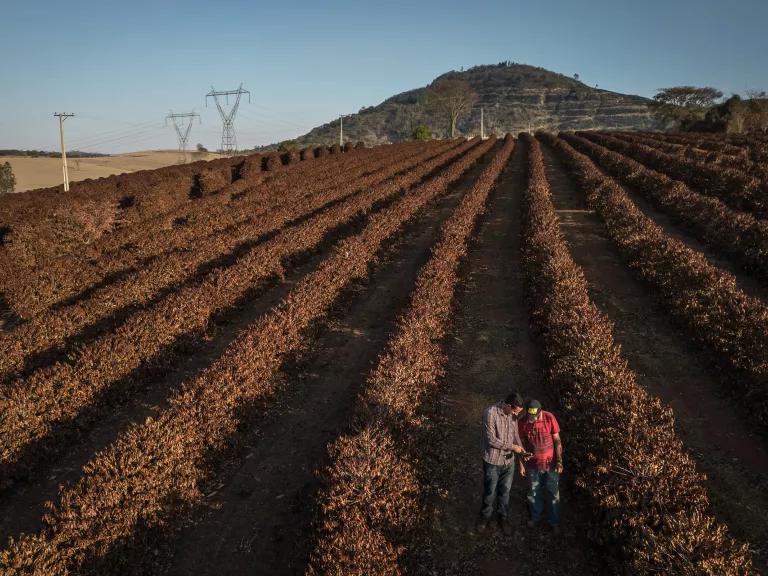
Coffee plants destroyed by frost due to extremely low temperatures near Caconde in the São Paulo state of Brazil, August 25, 2021
Jonne Roriz/Bloomberg via Getty Images
Less predictable growing seasons
In a warming world, farming crops is more unpredictable—and livestock, which are sensitive to extreme weather, become harder to raise. Climate change shifts precipitation patterns, causing unpredictable floods and longer-lasting droughts. More frequent and severe hurricanes can devastate an entire season’s worth of crops. Meanwhile, the dynamics of pests, pathogens, and invasive species—all of which are costly for farmers to manage—are also expected to become harder to predict. This is bad news, given that most of the world’s farms are small and family-run. One bad drought or flood could decimate an entire season’s crop or herd. For example, in June 2022, a triple-digit heat wave in Kansas wiped out thousands of cows. While the regenerative agriculture movement is empowering rural communities to make their lands more resilient to climate change, unfortunately, not all communities can equitably access the support services that can help them embrace these more sustainable farming tactics.
Reduced soil health
Healthy soil has good moisture and mineral content and is teeming with bugs, bacteria, fungi, and microbes that in turn contribute to healthy crops. But climate change, particularly extreme heat and changes in precipitation, can degrade soil quality. These impacts are exacerbated in areas where industrial, chemical-dependent monoculture farming has made soil and crops less able to withstand environmental changes.
Food shortages
Ultimately, impacts to our agricultural systems pose a direct threat to the global food supply. And food shortages and price hikes driven by climate change will not affect everyone equally: Wealthier people will continue to have more options for accessing food, while potentially billions of others will be plummeted into food insecurity—adding to the billions that already have moderate or severe difficulty getting enough to eat.
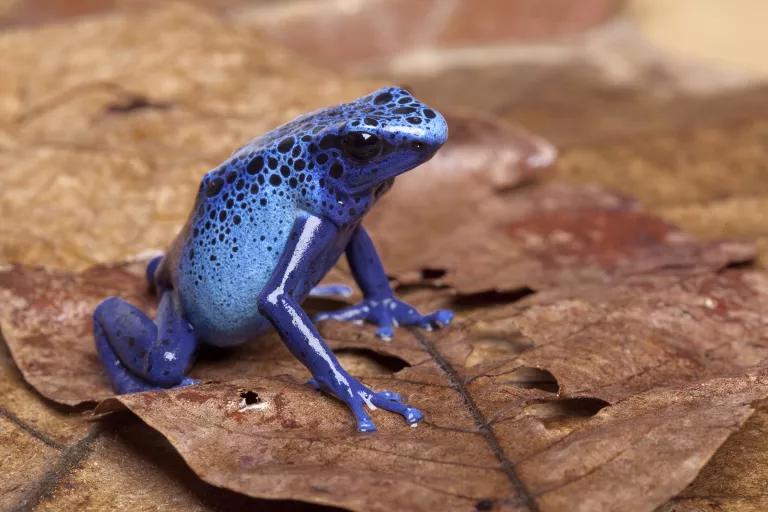
The poison dart frog’s survival is currently threatened by habitat loss and climate change.
Chris Mattison/Minden Pictures
It’s about far more than just the polar bears: Half of all animal species in the world’s most biodiverse places, like the Amazon rainforest and the Galapagos Islands, are at risk of extinction from climate change. And climate change is threatening species that are already suffering from the biodiversity crisis, which is driven primarily by changes in land and ocean use (like converting wild places to farmland) and direct exploitation of species (like overfishing and wildlife trade). With species already in rough shape—more than 500,000 species have insufficient habitat for long-term survival—unchecked climate change is poised to push millions over the edge.
Climate change rapidly and fundamentally alters (or in some cases, destroys) the habitat that wildlife have incrementally adapted to over millennia. This is especially harmful for species’ habitats that are currently under threat from other causes. Ice-dependent mammals like walruses and penguins, for example, won’t fare well as ice sheets shrink. Rapid shifts in ocean temperatures stress the algae that nourishes coral reefs, causing reefs to starve—an increasingly common phenomenon known as coral bleaching . Disappearing wetlands in the Midwest’s Prairie Pothole Region means the loss of watering holes and breeding grounds for millions of migratory birds. (Many species are now struggling to survive, as more than 85 percent of wetlands have been lost since 1700). And sea level rise will inundate or erode away many coastal habitats, where hundreds of species of birds, invertebrates, and other marine species live.
Many species’ behaviors—mating, feeding, migration—are closely tied to subtle seasonal shifts, as in temperature , precipitation level, and foliage. In some cases, changes to the environment are happening quicker than species are able to adapt. When the types and quantity of plant life change across a region, or when certain species bloom or hatch earlier or later than in the past, it impacts food and water supplies and reverberates up food chains.
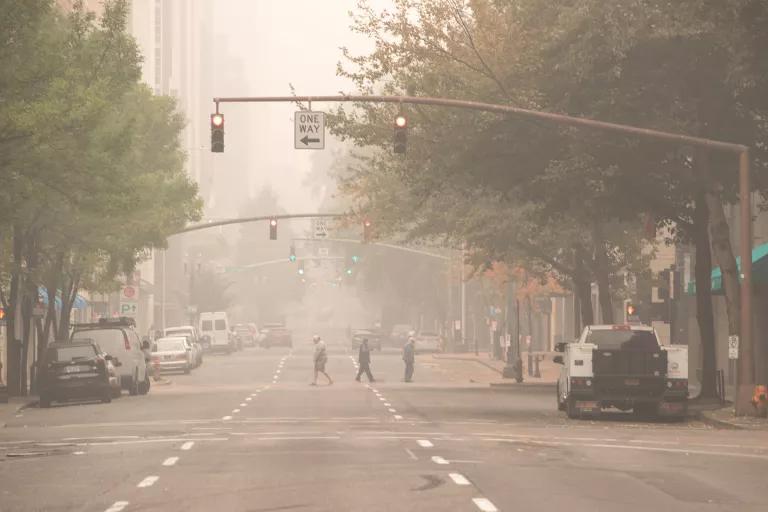
Wildfire smoke–filled air in Multnomah County, Oregon, September 16, 2020
Motoya Nakamura/Multnomah County Communications, CC BY NC-ND 4.0
Ultimately, the way climate change impacts weather, the environment, animals, and agriculture affects humanity as well. But there’s more. Around the world, our ways of life—from how we get our food to the industries around which our economies are based—have all developed in the context of relatively stable climates. As global warming shakes this foundation, it promises to alter the very fabric of society. At worst, this could lead to widespread famine, disease, war, displacement , injury, and death. For many around the world, this grim forecast is already their reality. In this way, climate change poses an existential threat to all human life.
Human health
Climate change worsens air quality . It increases exposure to hazardous wildfire smoke and ozone smog triggered by warmer conditions, both of which harm our health, particularly for those with pre-existing illnesses like asthma or heart disease.
Insect-borne diseases like malaria and Zika become more prevalent in a warming world as their carriers are able to exist in more regions or thrive for longer seasons. In the past 30 years, the incidence of Lyme disease from ticks has nearly doubled in the United States, according to the U.S. Environmental Protection Agency (EPA). Thousands of people face injury, illness , and death every year from more frequent or more intense extreme weather events. At a 2-degree Celsius rise in global average temperature, an estimated one billion people will face heat stress risk. In the summer of 2022 alone, thousands died in record-shattering heat waves across Europe. Weeks later, dozens were killed by record-breaking urban flooding in the United States and South Korea—and more than 1,500 people perished in the flooding in Pakistan , where resulting stagnant water and unsanitary conditions threaten even more.
The effects of climate change—and the looming threat of what’s yet to come—take a significant toll on mental health too. One 2021 study on climate anxiety, published in the journal Nature , surveyed 10,000 young people from 10 different countries. Forty-five percent of respondents said that their feelings about climate change, varying from anxiety to powerlessness to anger, impacted their daily lives.
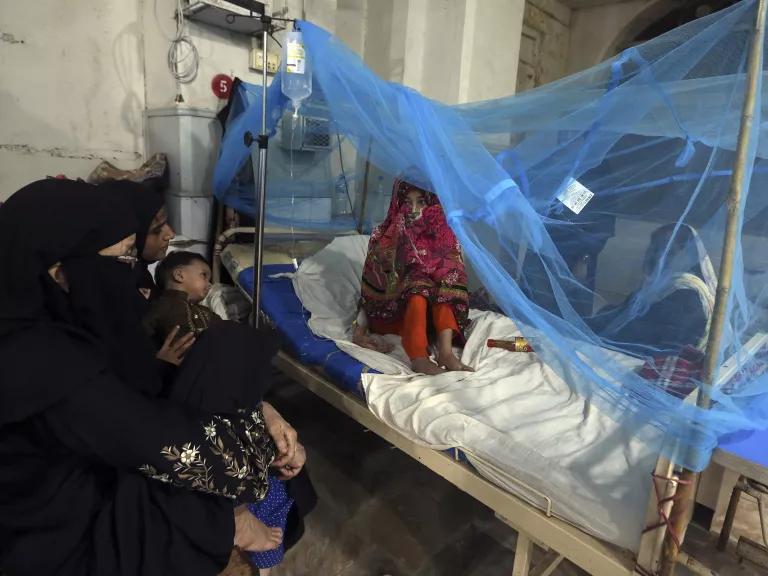
A patient with dengue fever, a mosquito-borne disease, in Karachi, Pakistan, where the spread of diseases worsened due to flooding, September 2022
Fareed Khan/AP Photo
Worsening inequity
The climate crisis exacerbates existing inequities. Though wealthy nations, such as the United States, have emitted the lion’s share of historical greenhouse gas emissions, it’s developing countries that may lack the resources to adapt and will now bear the brunt of the climate crisis. In some cases, low-lying island nations—like many in the Pacific —may cease to exist before developed economies make meaningful reductions to their carbon emissions.
Even within wealthier nations, disparities will continue to grow between those rich enough to shield themselves from the realities of climate change and those who cannot. Those with ample resources will not be displaced from their homes by wars over food or water—at least not right away. They will have homes with cool air during heat waves and be able to easily evacuate when a hurricane is headed their way. They will be able to buy increasingly expensive food and access treatment for respiratory illness caused by wildfire smoke. Billions of others can’t—and are paying the highest price for climate pollution they did not produce.
Hurricane Katrina, for example, displaced more than one million people around the Gulf Coast. But in New Orleans , where redlining practices promoted racial and economic segregation, the city’s more affluent areas tended to be located on higher ground—and those residents were able to return and rebuild much faster than others.
Displacement
Climate change will drive displacement due to impacts like food and water scarcities, sea level rise, and economic instability. It’s already happening. The United Nations Global Compact on Refugees recognizes that “climate, environmental degradation and disasters increasingly interact with the drivers of refugee movements.” Again, communities with the fewest resources—including those facing political instability and poverty—will feel the effects first and most devastatingly.

A flood-damaged home in Queens, New York, December 1, 2021
K.C. Wilsey/FEMA
Economic impacts
According to the 2018 National Climate Assessment, unless action is taken, climate change will cost the U.S. economy as much as $500 billion per year by the end of the century. And that doesn’t even include its enormous impacts on human health . Entire local industries—from commercial fishing to tourism to husbandry—are at risk of collapsing, along with the economic support they provide.
Recovering from the destruction wrought by extreme weather like hurricanes, flash floods, and wildfires is also getting more expensive every year. In 2021, the price tag of weather disasters in the United States totaled $145 billion —the third-costliest year on record, including a number of billion-dollar weather events.
The first wave of impacts can already be felt in our communities and seen on the nightly news. The World Health Organization says that in the near future, between 2030 and 2050, climate change is expected to cause an additional 250,000 deaths per year from things like malnutrition, insect-borne diseases, and heat stress. And the World Bank estimates that climate change could displace more than 140 million people within their home countries in sub-Saharan Africa, South Asia, and Latin America by 2050.
But the degree to which the climate crisis upends our lives depends on whether global leaders decide to chart a different course. If we fail to curb greenhouse gas emissions, scientists predict a catastrophic 4.3 degrees Celsius , (or around 8 degrees Fahrenheit) of warming by the end of the century. What would a world that warm look like? Wars over water. Crowded hospitals to contend with spreading disease. Collapsed fisheries. Dead coral reefs. Even more lethal heat waves. These are just some of the impacts predicted by climate scientists .
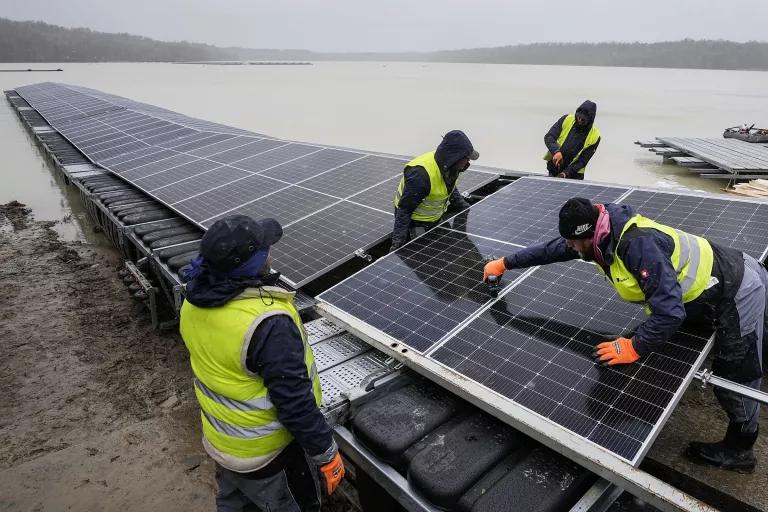
Solar panel installation at a floating photovoltaic plant on a lake in Haltern am See, Germany, April 2022
Martin Meissner/AP Photo
Climate mitigation, or our ability to reverse climate change and undo its widespread effects, hinges on the successful enactment of policies that yield deep cuts to carbon pollution, end our dependence on dangerous fossil fuels and the deadly air pollution they generate, and prioritize the people and ecosystems on the frontlines. And these actions must be taken quickly in order to ensure a healthier present day and future. In one of its latest reports, the IPCC presented its most optimistic emissions scenario, in which the world only briefly surpasses 1.5 degrees of warming but sequestration measures cause it to dip back below by 2100. Climate adaptation , a term that refers to coping with climate impacts, is no longer optional ; it’s necessary, particularly for the world’s most vulnerable populations.
By following the urgent warnings of the IPCC and limiting warming, we may be able to avoid passing some of the critical thresholds that, once crossed, can lead to potentially irreversible, catastrophic impacts for the planet, including more warming. These thresholds are known as climate tipping points and refer to when a natural system "tips" into an entirely different state. One example would be Arctic permafrost, which stores carbon like a freezer: As the permafrost melts from warming temperatures, it releases carbon dioxide into the atmosphere.
Importantly, climate action is not a binary pass-fail test. Every fraction of a degree of warming that we prevent will reduce human suffering and death, and keep more of the planet’s natural systems intact. The good news is that a wide range of solutions exist to sharply reduce emissions, slow the pace of warming, and protect communities on the frontlines of climate impacts. Climate leaders the world over—those on major political stages as well as grassroots community activists—are offering up alternative models to systems that prioritize polluters over people. Many of these solutions are rooted in ancestral and Indigenous understandings of the natural world and have existed for millennia. Some solutions require major investments into clean, renewable energy and sustainable technologies. To be successful, climate solutions must also address intersecting crises—like poverty, racism, and gender inequality —that compound and drive the causes and impacts of the climate crisis. A combination of human ingenuity and immense political will can help us get there.
This NRDC.org story is available for online republication by news media outlets or nonprofits under these conditions: The writer(s) must be credited with a byline; you must note prominently that the story was originally published by NRDC.org and link to the original; the story cannot be edited (beyond simple things such as grammar); you can’t resell the story in any form or grant republishing rights to other outlets; you can’t republish our material wholesale or automatically—you need to select stories individually; you can’t republish the photos or graphics on our site without specific permission; you should drop us a note to let us know when you’ve used one of our stories.
We need climate action to be a top priority in Washington.
Tell President Biden and Congress to slash climate pollution and reduce our dependence on fossil fuels.

Urge President Biden and Congress to make equitable climate action a top priority in 2024
Related stories.
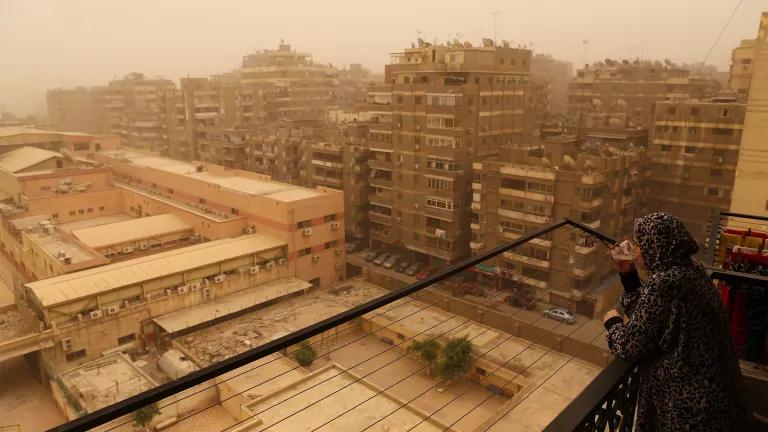
COP27: The Issues, the Tensions, and the Urgent Need for Unity on Climate
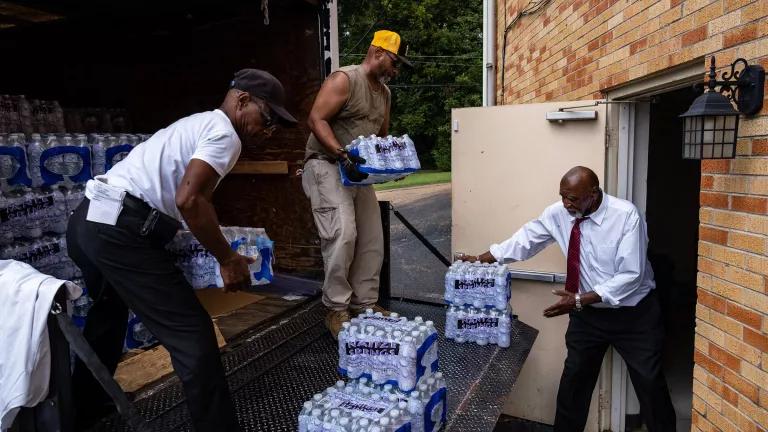
Mutual Aid and Disaster Justice: “We Keep Us Safe”

Climate Change at the Doctor’s Office
When you sign up, you’ll become a member of NRDC’s Activist Network. We will keep you informed with the latest alerts and progress reports.
- CBSE Class 10th
- CBSE Class 12th
- UP Board 10th
- UP Board 12th
- Bihar Board 10th
- Bihar Board 12th
- Top Schools in India
- Top Schools in Delhi
- Top Schools in Mumbai
- Top Schools in Chennai
- Top Schools in Hyderabad
- Top Schools in Kolkata
- Top Schools in Pune
- Top Schools in Bangalore
Products & Resources
- JEE Main Knockout April
- Free Sample Papers
- Free Ebooks
- NCERT Notes
- NCERT Syllabus
- NCERT Books
- RD Sharma Solutions
- Navodaya Vidyalaya Admission 2024-25
- NCERT Solutions
- NCERT Solutions for Class 12
- NCERT Solutions for Class 11
- NCERT solutions for Class 10
- NCERT solutions for Class 9
- NCERT solutions for Class 8
- NCERT Solutions for Class 7
- JEE Main 2024
- JEE Advanced 2024
- BITSAT 2024
- View All Engineering Exams
- Colleges Accepting B.Tech Applications
- Top Engineering Colleges in India
- Engineering Colleges in India
- Engineering Colleges in Tamil Nadu
- Engineering Colleges Accepting JEE Main
- Top IITs in India
- Top NITs in India
- Top IIITs in India
- JEE Main College Predictor
- JEE Main Rank Predictor
- MHT CET College Predictor
- AP EAMCET College Predictor
- GATE College Predictor
- KCET College Predictor
- JEE Advanced College Predictor
- View All College Predictors
- JEE Main Question Paper
- JEE Main Mock Test
- JEE Main Registration
- JEE Main Syllabus
- Download E-Books and Sample Papers
- Compare Colleges
- B.Tech College Applications
- GATE 2024 Result
- MAH MBA CET Exam
- View All Management Exams
Colleges & Courses
- MBA College Admissions
- MBA Colleges in India
- Top IIMs Colleges in India
- Top Online MBA Colleges in India
- MBA Colleges Accepting XAT Score
- BBA Colleges in India
- XAT College Predictor 2024
- SNAP College Predictor
- NMAT College Predictor
- MAT College Predictor 2024
- CMAT College Predictor 2024
- CAT Percentile Predictor 2023
- CAT 2023 College Predictor
- CMAT 2024 Registration
- TS ICET 2024 Registration
- CMAT Exam Date 2024
- MAH MBA CET Cutoff 2024
- Download Helpful Ebooks
- List of Popular Branches
- QnA - Get answers to your doubts
- IIM Fees Structure
- AIIMS Nursing
- Top Medical Colleges in India
- Top Medical Colleges in India accepting NEET Score
- Medical Colleges accepting NEET
- List of Medical Colleges in India
- List of AIIMS Colleges In India
- Medical Colleges in Maharashtra
- Medical Colleges in India Accepting NEET PG
- NEET College Predictor
- NEET PG College Predictor
- NEET MDS College Predictor
- DNB CET College Predictor
- DNB PDCET College Predictor
- NEET Application Form 2024
- NEET PG Application Form 2024
- NEET Cut off
- NEET Online Preparation
- Download Helpful E-books
- LSAT India 2024
- Colleges Accepting Admissions
- Top Law Colleges in India
- Law College Accepting CLAT Score
- List of Law Colleges in India
- Top Law Colleges in Delhi
- Top Law Collages in Indore
- Top Law Colleges in Chandigarh
- Top Law Collages in Lucknow
Predictors & E-Books
- CLAT College Predictor
- MHCET Law ( 5 Year L.L.B) College Predictor
- AILET College Predictor
- Sample Papers
- Compare Law Collages
- Careers360 Youtube Channel
- CLAT Syllabus 2025
- CLAT Previous Year Question Paper
- AIBE 18 Result 2023
- NID DAT Exam
- Pearl Academy Exam
Animation Courses
- Animation Courses in India
- Animation Courses in Bangalore
- Animation Courses in Mumbai
- Animation Courses in Pune
- Animation Courses in Chennai
- Animation Courses in Hyderabad
- Design Colleges in India
- Fashion Design Colleges in Bangalore
- Fashion Design Colleges in Mumbai
- Fashion Design Colleges in Pune
- Fashion Design Colleges in Delhi
- Fashion Design Colleges in Hyderabad
- Fashion Design Colleges in India
- Top Design Colleges in India
- Free Design E-books
- List of Branches
- Careers360 Youtube channel
- NIFT College Predictor
- UCEED College Predictor
- NID DAT College Predictor
- IPU CET BJMC
- JMI Mass Communication Entrance Exam
- IIMC Entrance Exam
- Media & Journalism colleges in Delhi
- Media & Journalism colleges in Bangalore
- Media & Journalism colleges in Mumbai
- List of Media & Journalism Colleges in India
- CA Intermediate
- CA Foundation
- CS Executive
- CS Professional
- Difference between CA and CS
- Difference between CA and CMA
- CA Full form
- CMA Full form
- CS Full form
- CA Salary In India
Top Courses & Careers
- Bachelor of Commerce (B.Com)
- Master of Commerce (M.Com)
- Company Secretary
- Cost Accountant
- Charted Accountant
- Credit Manager
- Financial Advisor
- Top Commerce Colleges in India
- Top Government Commerce Colleges in India
- Top Private Commerce Colleges in India
- Top M.Com Colleges in Mumbai
- Top B.Com Colleges in India
- IT Colleges in Tamil Nadu
- IT Colleges in Uttar Pradesh
- MCA Colleges in India
- BCA Colleges in India
Quick Links
- Information Technology Courses
- Programming Courses
- Web Development Courses
- Data Analytics Courses
- Big Data Analytics Courses
- RUHS Pharmacy Admission Test
- Top Pharmacy Colleges in India
- Pharmacy Colleges in Pune
- Pharmacy Colleges in Mumbai
- Colleges Accepting GPAT Score
- Pharmacy Colleges in Lucknow
- List of Pharmacy Colleges in Nagpur
- GPAT Result
- GPAT 2024 Admit Card
- GPAT Question Papers
- NCHMCT JEE 2024
- Mah BHMCT CET
- Top Hotel Management Colleges in Delhi
- Top Hotel Management Colleges in Hyderabad
- Top Hotel Management Colleges in Mumbai
- Top Hotel Management Colleges in Tamil Nadu
- Top Hotel Management Colleges in Maharashtra
- B.Sc Hotel Management
- Hotel Management
- Diploma in Hotel Management and Catering Technology
Diploma Colleges
- Top Diploma Colleges in Maharashtra
- UPSC IAS 2024
- SSC CGL 2024
- IBPS RRB 2024
- Previous Year Sample Papers
- Free Competition E-books
- Sarkari Result
- QnA- Get your doubts answered
- UPSC Previous Year Sample Papers
- CTET Previous Year Sample Papers
- SBI Clerk Previous Year Sample Papers
- NDA Previous Year Sample Papers
Upcoming Events
- NDA Application Form 2024
- UPSC IAS Application Form 2024
- CDS Application Form 2024
- CTET Admit card 2024
- HP TET Result 2023
- SSC GD Constable Admit Card 2024
- UPTET Notification 2024
- SBI Clerk Result 2024
Other Exams
- SSC CHSL 2024
- UP PCS 2024
- UGC NET 2024
- RRB NTPC 2024
- IBPS PO 2024
- IBPS Clerk 2024
- IBPS SO 2024
- Top University in USA
- Top University in Canada
- Top University in Ireland
- Top Universities in UK
- Top Universities in Australia
- Best MBA Colleges in Abroad
- Business Management Studies Colleges
Top Countries
- Study in USA
- Study in UK
- Study in Canada
- Study in Australia
- Study in Ireland
- Study in Germany
- Study in China
- Study in Europe
Student Visas
- Student Visa Canada
- Student Visa UK
- Student Visa USA
- Student Visa Australia
- Student Visa Germany
- Student Visa New Zealand
- Student Visa Ireland
- CUET PG 2024
- IGNOU B.Ed Admission 2024
- DU Admission
- UP B.Ed JEE 2024
- DDU Entrance Exam
- IIT JAM 2024
- IGNOU Online Admission 2024
- Universities in India
- Top Universities in India 2024
- Top Colleges in India
- Top Universities in Uttar Pradesh 2024
- Top Universities in Bihar
- Top Universities in Madhya Pradesh 2024
- Top Universities in Tamil Nadu 2024
- Central Universities in India
- CUET PG Admit Card 2024
- IGNOU Date Sheet
- CUET Mock Test 2024
- CUET Application Form 2024
- CUET PG Syllabus 2024
- CUET Participating Universities 2024
- CUET Previous Year Question Paper
- CUET Syllabus 2024 for Science Students
- E-Books and Sample Papers
- CUET Exam Pattern 2024
- CUET Exam Date 2024
- CUET Syllabus 2024
- IGNOU Exam Form 2024
- IGNOU Result
- CUET PG Courses 2024
Engineering Preparation
- Knockout JEE Main 2024
- Test Series JEE Main 2024
- JEE Main 2024 Rank Booster
Medical Preparation
- Knockout NEET 2024
- Test Series NEET 2024
- Rank Booster NEET 2024
Online Courses
- JEE Main One Month Course
- NEET One Month Course
- IBSAT Free Mock Tests
- IIT JEE Foundation Course
- Knockout BITSAT 2024
- Career Guidance Tool
Top Streams
- IT & Software Certification Courses
- Engineering and Architecture Certification Courses
- Programming And Development Certification Courses
- Business and Management Certification Courses
- Marketing Certification Courses
- Health and Fitness Certification Courses
- Design Certification Courses
Specializations
- Digital Marketing Certification Courses
- Cyber Security Certification Courses
- Artificial Intelligence Certification Courses
- Business Analytics Certification Courses
- Data Science Certification Courses
- Cloud Computing Certification Courses
- Machine Learning Certification Courses
- View All Certification Courses
- UG Degree Courses
- PG Degree Courses
- Short Term Courses
- Free Courses
- Online Degrees and Diplomas
- Compare Courses
Top Providers
- Coursera Courses
- Udemy Courses
- Edx Courses
- Swayam Courses
- upGrad Courses
- Simplilearn Courses
- Great Learning Courses
Access premium articles, webinars, resources to make the best decisions for career, course, exams, scholarships, study abroad and much more with
Plan, Prepare & Make the Best Career Choices
Essay on Climate Change
Climate Change Essay - The globe is growing increasingly sensitive to climate change. It is currently a serious worldwide concern. The term "Climate Change" describes changes to the earth's climate. It explains the atmospheric changes that have occurred across time, spanning from decades to millions of years. Here are some sample essays on climate change.
100 Words Essay on Climate Change
200 words essay on climate change, 500 words essay on climate change.

The climatic conditions on Earth are changing due to climate change. Several internal and external variables, such as solar radiation, variations in the Earth's orbit, volcanic eruptions, plate tectonics, etc., are to blame for this.
There are strategies for climate change reduction. If not implemented, the weather might get worse, there might be water scarcity, there could be lower agricultural output, and it might affect people's ability to make a living. In order to breathe clean air and drink pure water, you must concentrate on limiting human activity. These are the simple measures that may be taken to safeguard the environment and its resources.
The climate of the Earth has changed significantly over time. While some of these changes were brought on by natural events like volcanic eruptions, floods, forest fires, etc., many of the changes were brought on by human activity. The burning of fossil fuels, domesticating livestock, and other human activities produce a significant quantity of greenhouse gases. This results in an increase of greenhouse effect and global warming which are the major causes for climate change.
Reasons of Climate Change
Some of the reasons of climate change are:
Deforestation
Excessive use of fossil fuels
Water and soil pollution
Plastic and other non biodegradable waste
Wildlife and nature extinction
Consequences of Climate Change
All kinds of life on earth will be affected by climate change if it continues to change at the same pace. The earth's temperature will increase, the monsoon patterns will shift, the sea level will rise, and there will be more frequent storms, volcano eruptions, and other natural calamities. The earth's biological and ecological equilibrium will be disturbed. Humans won't be able to access clean water or air to breathe when the environment becomes contaminated. The end of life on this earth is imminent. To reduce the issue of climate change, we need to bring social awareness along with strict measures to protect and preserve the natural environment.
A shift in the world's climatic pattern is referred to as climate change. Over the centuries, the climate pattern of our planet has undergone modifications. The amount of carbon dioxide in the atmosphere has significantly grown.
When Did Climate Change Begin
It is possible to see signs of climate change as early as the beginning of the industrial revolution. The pace at which the manufacturers produced things on a large scale required a significant amount of raw materials. Since the raw materials being transformed into finished products now have such huge potential for profit, these business models have spread quickly over the world. Hazardous substances and chemicals build up in the environment as a result of company emissions and waste disposal.
Although climate change is a natural occurrence, it is evident that human activity is turning into the primary cause of the current climate change situation. The major cause is the growing population. Natural resources are utilised more and more as a result of the population's fast growth placing a heavy burden on the available resources. Over time, as more and more products and services are created, pollution will eventually increase.
Causes of Climate Change
There are a number of factors that have contributed towards weather change in the past and continue to do so. Let us look at a few:
Solar Radiation |The climate of earth is determined by how quickly the sun's energy is absorbed and distributed throughout space. This energy is transmitted throughout the world by the winds, ocean currents etc which affects the climatic conditions of the world. Changes in solar intensity have an effect on the world's climate.
Deforestation | The atmosphere's carbon dioxide is stored by trees. As a result of their destruction, carbon dioxide builds up more quickly since there are no trees to absorb it. Additionally, trees release the carbon they stored when we burn them.
Agriculture | Many kinds of greenhouse gases are released into the atmosphere by growing crops and raising livestock. Animals, for instance, create methane, a greenhouse gas that is 30 times more potent than carbon dioxide. The nitrous oxide used in fertilisers is roughly 300 times more strong than carbon dioxide.
How to Prevent Climate Change
We need to look out for drastic steps to stop climate change since it is affecting the resources and life on our planet. We can stop climate change if the right solutions are put in place. Here are some strategies for reducing climate change:
Raising public awareness of climate change
Prohibiting tree-cutting and deforestation.
Ensure the surroundings are clean.
Refrain from using chemical fertilisers.
Water and other natural resource waste should be reduced.
Protect the animals and plants.
Purchase energy-efficient goods and equipment.
Increase the number of trees in the neighbourhood and its surroundings.
Follow the law and safeguard the environment's resources.
Reduce the amount of energy you use.
During the last few decades especially, climate change has grown to be of concern. Global concern has been raised over changes in the Earth's climatic pattern. The causes of climate change are numerous, as well as the effects of it and it is our responsibility as inhabitants of this planet to look after its well being and leave it in a better condition for future generations.
Explore Career Options (By Industry)
- Construction
- Entertainment
- Manufacturing
- Information Technology
Bio Medical Engineer
The field of biomedical engineering opens up a universe of expert chances. An Individual in the biomedical engineering career path work in the field of engineering as well as medicine, in order to find out solutions to common problems of the two fields. The biomedical engineering job opportunities are to collaborate with doctors and researchers to develop medical systems, equipment, or devices that can solve clinical problems. Here we will be discussing jobs after biomedical engineering, how to get a job in biomedical engineering, biomedical engineering scope, and salary.
Data Administrator
Database professionals use software to store and organise data such as financial information, and customer shipping records. Individuals who opt for a career as data administrators ensure that data is available for users and secured from unauthorised sales. DB administrators may work in various types of industries. It may involve computer systems design, service firms, insurance companies, banks and hospitals.
Ethical Hacker
A career as ethical hacker involves various challenges and provides lucrative opportunities in the digital era where every giant business and startup owns its cyberspace on the world wide web. Individuals in the ethical hacker career path try to find the vulnerabilities in the cyber system to get its authority. If he or she succeeds in it then he or she gets its illegal authority. Individuals in the ethical hacker career path then steal information or delete the file that could affect the business, functioning, or services of the organization.
Data Analyst
The invention of the database has given fresh breath to the people involved in the data analytics career path. Analysis refers to splitting up a whole into its individual components for individual analysis. Data analysis is a method through which raw data are processed and transformed into information that would be beneficial for user strategic thinking.
Data are collected and examined to respond to questions, evaluate hypotheses or contradict theories. It is a tool for analyzing, transforming, modeling, and arranging data with useful knowledge, to assist in decision-making and methods, encompassing various strategies, and is used in different fields of business, research, and social science.
Geothermal Engineer
Individuals who opt for a career as geothermal engineers are the professionals involved in the processing of geothermal energy. The responsibilities of geothermal engineers may vary depending on the workplace location. Those who work in fields design facilities to process and distribute geothermal energy. They oversee the functioning of machinery used in the field.
Remote Sensing Technician
Individuals who opt for a career as a remote sensing technician possess unique personalities. Remote sensing analysts seem to be rational human beings, they are strong, independent, persistent, sincere, realistic and resourceful. Some of them are analytical as well, which means they are intelligent, introspective and inquisitive.
Remote sensing scientists use remote sensing technology to support scientists in fields such as community planning, flight planning or the management of natural resources. Analysing data collected from aircraft, satellites or ground-based platforms using statistical analysis software, image analysis software or Geographic Information Systems (GIS) is a significant part of their work. Do you want to learn how to become remote sensing technician? There's no need to be concerned; we've devised a simple remote sensing technician career path for you. Scroll through the pages and read.
Geotechnical engineer
The role of geotechnical engineer starts with reviewing the projects needed to define the required material properties. The work responsibilities are followed by a site investigation of rock, soil, fault distribution and bedrock properties on and below an area of interest. The investigation is aimed to improve the ground engineering design and determine their engineering properties that include how they will interact with, on or in a proposed construction.
The role of geotechnical engineer in mining includes designing and determining the type of foundations, earthworks, and or pavement subgrades required for the intended man-made structures to be made. Geotechnical engineering jobs are involved in earthen and concrete dam construction projects, working under a range of normal and extreme loading conditions.
Cartographer
How fascinating it is to represent the whole world on just a piece of paper or a sphere. With the help of maps, we are able to represent the real world on a much smaller scale. Individuals who opt for a career as a cartographer are those who make maps. But, cartography is not just limited to maps, it is about a mixture of art , science , and technology. As a cartographer, not only you will create maps but use various geodetic surveys and remote sensing systems to measure, analyse, and create different maps for political, cultural or educational purposes.
Budget Analyst
Budget analysis, in a nutshell, entails thoroughly analyzing the details of a financial budget. The budget analysis aims to better understand and manage revenue. Budget analysts assist in the achievement of financial targets, the preservation of profitability, and the pursuit of long-term growth for a business. Budget analysts generally have a bachelor's degree in accounting, finance, economics, or a closely related field. Knowledge of Financial Management is of prime importance in this career.
Product Manager
A Product Manager is a professional responsible for product planning and marketing. He or she manages the product throughout the Product Life Cycle, gathering and prioritising the product. A product manager job description includes defining the product vision and working closely with team members of other departments to deliver winning products.
Underwriter
An underwriter is a person who assesses and evaluates the risk of insurance in his or her field like mortgage, loan, health policy, investment, and so on and so forth. The underwriter career path does involve risks as analysing the risks means finding out if there is a way for the insurance underwriter jobs to recover the money from its clients. If the risk turns out to be too much for the company then in the future it is an underwriter who will be held accountable for it. Therefore, one must carry out his or her job with a lot of attention and diligence.
Finance Executive
Operations manager.
Individuals in the operations manager jobs are responsible for ensuring the efficiency of each department to acquire its optimal goal. They plan the use of resources and distribution of materials. The operations manager's job description includes managing budgets, negotiating contracts, and performing administrative tasks.
Bank Probationary Officer (PO)
Investment director.
An investment director is a person who helps corporations and individuals manage their finances. They can help them develop a strategy to achieve their goals, including paying off debts and investing in the future. In addition, he or she can help individuals make informed decisions.
Welding Engineer
Welding Engineer Job Description: A Welding Engineer work involves managing welding projects and supervising welding teams. He or she is responsible for reviewing welding procedures, processes and documentation. A career as Welding Engineer involves conducting failure analyses and causes on welding issues.
Transportation Planner
A career as Transportation Planner requires technical application of science and technology in engineering, particularly the concepts, equipment and technologies involved in the production of products and services. In fields like land use, infrastructure review, ecological standards and street design, he or she considers issues of health, environment and performance. A Transportation Planner assigns resources for implementing and designing programmes. He or she is responsible for assessing needs, preparing plans and forecasts and compliance with regulations.
An expert in plumbing is aware of building regulations and safety standards and works to make sure these standards are upheld. Testing pipes for leakage using air pressure and other gauges, and also the ability to construct new pipe systems by cutting, fitting, measuring and threading pipes are some of the other more involved aspects of plumbing. Individuals in the plumber career path are self-employed or work for a small business employing less than ten people, though some might find working for larger entities or the government more desirable.
Construction Manager
Individuals who opt for a career as construction managers have a senior-level management role offered in construction firms. Responsibilities in the construction management career path are assigning tasks to workers, inspecting their work, and coordinating with other professionals including architects, subcontractors, and building services engineers.
Urban Planner
Urban Planning careers revolve around the idea of developing a plan to use the land optimally, without affecting the environment. Urban planning jobs are offered to those candidates who are skilled in making the right use of land to distribute the growing population, to create various communities.
Urban planning careers come with the opportunity to make changes to the existing cities and towns. They identify various community needs and make short and long-term plans accordingly.
Highway Engineer
Highway Engineer Job Description: A Highway Engineer is a civil engineer who specialises in planning and building thousands of miles of roads that support connectivity and allow transportation across the country. He or she ensures that traffic management schemes are effectively planned concerning economic sustainability and successful implementation.
Environmental Engineer
Individuals who opt for a career as an environmental engineer are construction professionals who utilise the skills and knowledge of biology, soil science, chemistry and the concept of engineering to design and develop projects that serve as solutions to various environmental problems.
Naval Architect
A Naval Architect is a professional who designs, produces and repairs safe and sea-worthy surfaces or underwater structures. A Naval Architect stays involved in creating and designing ships, ferries, submarines and yachts with implementation of various principles such as gravity, ideal hull form, buoyancy and stability.
Orthotist and Prosthetist
Orthotists and Prosthetists are professionals who provide aid to patients with disabilities. They fix them to artificial limbs (prosthetics) and help them to regain stability. There are times when people lose their limbs in an accident. In some other occasions, they are born without a limb or orthopaedic impairment. Orthotists and prosthetists play a crucial role in their lives with fixing them to assistive devices and provide mobility.
Veterinary Doctor
Pathologist.
A career in pathology in India is filled with several responsibilities as it is a medical branch and affects human lives. The demand for pathologists has been increasing over the past few years as people are getting more aware of different diseases. Not only that, but an increase in population and lifestyle changes have also contributed to the increase in a pathologist’s demand. The pathology careers provide an extremely huge number of opportunities and if you want to be a part of the medical field you can consider being a pathologist. If you want to know more about a career in pathology in India then continue reading this article.
Speech Therapist
Gynaecologist.
Gynaecology can be defined as the study of the female body. The job outlook for gynaecology is excellent since there is evergreen demand for one because of their responsibility of dealing with not only women’s health but also fertility and pregnancy issues. Although most women prefer to have a women obstetrician gynaecologist as their doctor, men also explore a career as a gynaecologist and there are ample amounts of male doctors in the field who are gynaecologists and aid women during delivery and childbirth.
An oncologist is a specialised doctor responsible for providing medical care to patients diagnosed with cancer. He or she uses several therapies to control the cancer and its effect on the human body such as chemotherapy, immunotherapy, radiation therapy and biopsy. An oncologist designs a treatment plan based on a pathology report after diagnosing the type of cancer and where it is spreading inside the body.
Audiologist
The audiologist career involves audiology professionals who are responsible to treat hearing loss and proactively preventing the relevant damage. Individuals who opt for a career as an audiologist use various testing strategies with the aim to determine if someone has a normal sensitivity to sounds or not. After the identification of hearing loss, a hearing doctor is required to determine which sections of the hearing are affected, to what extent they are affected, and where the wound causing the hearing loss is found. As soon as the hearing loss is identified, the patients are provided with recommendations for interventions and rehabilitation such as hearing aids, cochlear implants, and appropriate medical referrals. While audiology is a branch of science that studies and researches hearing, balance, and related disorders.
Hospital Administrator
The hospital Administrator is in charge of organising and supervising the daily operations of medical services and facilities. This organising includes managing of organisation’s staff and its members in service, budgets, service reports, departmental reporting and taking reminders of patient care and services.
For an individual who opts for a career as an actor, the primary responsibility is to completely speak to the character he or she is playing and to persuade the crowd that the character is genuine by connecting with them and bringing them into the story. This applies to significant roles and littler parts, as all roles join to make an effective creation. Here in this article, we will discuss how to become an actor in India, actor exams, actor salary in India, and actor jobs.
Individuals who opt for a career as acrobats create and direct original routines for themselves, in addition to developing interpretations of existing routines. The work of circus acrobats can be seen in a variety of performance settings, including circus, reality shows, sports events like the Olympics, movies and commercials. Individuals who opt for a career as acrobats must be prepared to face rejections and intermittent periods of work. The creativity of acrobats may extend to other aspects of the performance. For example, acrobats in the circus may work with gym trainers, celebrities or collaborate with other professionals to enhance such performance elements as costume and or maybe at the teaching end of the career.
Video Game Designer
Career as a video game designer is filled with excitement as well as responsibilities. A video game designer is someone who is involved in the process of creating a game from day one. He or she is responsible for fulfilling duties like designing the character of the game, the several levels involved, plot, art and similar other elements. Individuals who opt for a career as a video game designer may also write the codes for the game using different programming languages.
Depending on the video game designer job description and experience they may also have to lead a team and do the early testing of the game in order to suggest changes and find loopholes.
Radio Jockey
Radio Jockey is an exciting, promising career and a great challenge for music lovers. If you are really interested in a career as radio jockey, then it is very important for an RJ to have an automatic, fun, and friendly personality. If you want to get a job done in this field, a strong command of the language and a good voice are always good things. Apart from this, in order to be a good radio jockey, you will also listen to good radio jockeys so that you can understand their style and later make your own by practicing.
A career as radio jockey has a lot to offer to deserving candidates. If you want to know more about a career as radio jockey, and how to become a radio jockey then continue reading the article.
Choreographer
The word “choreography" actually comes from Greek words that mean “dance writing." Individuals who opt for a career as a choreographer create and direct original dances, in addition to developing interpretations of existing dances. A Choreographer dances and utilises his or her creativity in other aspects of dance performance. For example, he or she may work with the music director to select music or collaborate with other famous choreographers to enhance such performance elements as lighting, costume and set design.
Videographer
Multimedia specialist.
A multimedia specialist is a media professional who creates, audio, videos, graphic image files, computer animations for multimedia applications. He or she is responsible for planning, producing, and maintaining websites and applications.
Social Media Manager
A career as social media manager involves implementing the company’s or brand’s marketing plan across all social media channels. Social media managers help in building or improving a brand’s or a company’s website traffic, build brand awareness, create and implement marketing and brand strategy. Social media managers are key to important social communication as well.
Copy Writer
In a career as a copywriter, one has to consult with the client and understand the brief well. A career as a copywriter has a lot to offer to deserving candidates. Several new mediums of advertising are opening therefore making it a lucrative career choice. Students can pursue various copywriter courses such as Journalism , Advertising , Marketing Management . Here, we have discussed how to become a freelance copywriter, copywriter career path, how to become a copywriter in India, and copywriting career outlook.
Careers in journalism are filled with excitement as well as responsibilities. One cannot afford to miss out on the details. As it is the small details that provide insights into a story. Depending on those insights a journalist goes about writing a news article. A journalism career can be stressful at times but if you are someone who is passionate about it then it is the right choice for you. If you want to know more about the media field and journalist career then continue reading this article.
For publishing books, newspapers, magazines and digital material, editorial and commercial strategies are set by publishers. Individuals in publishing career paths make choices about the markets their businesses will reach and the type of content that their audience will be served. Individuals in book publisher careers collaborate with editorial staff, designers, authors, and freelance contributors who develop and manage the creation of content.
In a career as a vlogger, one generally works for himself or herself. However, once an individual has gained viewership there are several brands and companies that approach them for paid collaboration. It is one of those fields where an individual can earn well while following his or her passion.
Ever since internet costs got reduced the viewership for these types of content has increased on a large scale. Therefore, a career as a vlogger has a lot to offer. If you want to know more about the Vlogger eligibility, roles and responsibilities then continue reading the article.
Individuals in the editor career path is an unsung hero of the news industry who polishes the language of the news stories provided by stringers, reporters, copywriters and content writers and also news agencies. Individuals who opt for a career as an editor make it more persuasive, concise and clear for readers. In this article, we will discuss the details of the editor's career path such as how to become an editor in India, editor salary in India and editor skills and qualities.
Linguistic meaning is related to language or Linguistics which is the study of languages. A career as a linguistic meaning, a profession that is based on the scientific study of language, and it's a very broad field with many specialities. Famous linguists work in academia, researching and teaching different areas of language, such as phonetics (sounds), syntax (word order) and semantics (meaning).
Other researchers focus on specialities like computational linguistics, which seeks to better match human and computer language capacities, or applied linguistics, which is concerned with improving language education. Still, others work as language experts for the government, advertising companies, dictionary publishers and various other private enterprises. Some might work from home as freelance linguists. Philologist, phonologist, and dialectician are some of Linguist synonym. Linguists can study French , German , Italian .
Public Relation Executive
Travel journalist.
The career of a travel journalist is full of passion, excitement and responsibility. Journalism as a career could be challenging at times, but if you're someone who has been genuinely enthusiastic about all this, then it is the best decision for you. Travel journalism jobs are all about insightful, artfully written, informative narratives designed to cover the travel industry. Travel Journalist is someone who explores, gathers and presents information as a news article.
Quality Controller
A quality controller plays a crucial role in an organisation. He or she is responsible for performing quality checks on manufactured products. He or she identifies the defects in a product and rejects the product.
A quality controller records detailed information about products with defects and sends it to the supervisor or plant manager to take necessary actions to improve the production process.
Production Manager
Merchandiser.
A QA Lead is in charge of the QA Team. The role of QA Lead comes with the responsibility of assessing services and products in order to determine that he or she meets the quality standards. He or she develops, implements and manages test plans.
Metallurgical Engineer
A metallurgical engineer is a professional who studies and produces materials that bring power to our world. He or she extracts metals from ores and rocks and transforms them into alloys, high-purity metals and other materials used in developing infrastructure, transportation and healthcare equipment.
Azure Administrator
An Azure Administrator is a professional responsible for implementing, monitoring, and maintaining Azure Solutions. He or she manages cloud infrastructure service instances and various cloud servers as well as sets up public and private cloud systems.
AWS Solution Architect
An AWS Solution Architect is someone who specializes in developing and implementing cloud computing systems. He or she has a good understanding of the various aspects of cloud computing and can confidently deploy and manage their systems. He or she troubleshoots the issues and evaluates the risk from the third party.
Computer Programmer
Careers in computer programming primarily refer to the systematic act of writing code and moreover include wider computer science areas. The word 'programmer' or 'coder' has entered into practice with the growing number of newly self-taught tech enthusiasts. Computer programming careers involve the use of designs created by software developers and engineers and transforming them into commands that can be implemented by computers. These commands result in regular usage of social media sites, word-processing applications and browsers.
ITSM Manager
Information security manager.
Individuals in the information security manager career path involves in overseeing and controlling all aspects of computer security. The IT security manager job description includes planning and carrying out security measures to protect the business data and information from corruption, theft, unauthorised access, and deliberate attack
Business Intelligence Developer
Applications for admissions are open..

JEE Main Important Chemistry formulas
As per latest 2024 syllabus. Chemistry formulas, equations, & laws of class 11 & 12th chapters

Aakash iACST Scholarship Test 2024
Get up to 90% scholarship on NEET, JEE & Foundation courses

Resonance Coaching
Enroll in Resonance Coaching for success in JEE/NEET exams

TOEFL ® Registrations 2024
Thinking of Studying Abroad? Think the TOEFL® test. Register now & Save 10% on English Proficiency Tests with Gift Cards

ALLEN JEE Exam Prep
Start your JEE preparation with ALLEN

NEET 2024 Most scoring concepts
Just Study 32% of the NEET syllabus and Score upto 100% marks
Everything about Education
Latest updates, Exclusive Content, Webinars and more.
Download Careers360 App's
Regular exam updates, QnA, Predictors, College Applications & E-books now on your Mobile
Cetifications
We Appeared in
Climate Change Essay for Students and Children
500+ words climate change essay.
Climate change refers to the change in the environmental conditions of the earth. This happens due to many internal and external factors. The climatic change has become a global concern over the last few decades. Besides, these climatic changes affect life on the earth in various ways. These climatic changes are having various impacts on the ecosystem and ecology. Due to these changes, a number of species of plants and animals have gone extinct.

When Did it Start?
The climate started changing a long time ago due to human activities but we came to know about it in the last century. During the last century, we started noticing the climatic change and its effect on human life. We started researching on climate change and came to know that the earth temperature is rising due to a phenomenon called the greenhouse effect. The warming up of earth surface causes many ozone depletion, affect our agriculture , water supply, transportation, and several other problems.
Reason Of Climate Change
Although there are hundreds of reason for the climatic change we are only going to discuss the natural and manmade (human) reasons.
Get the huge list of more than 500 Essay Topics and Ideas
Natural Reasons
These include volcanic eruption , solar radiation, tectonic plate movement, orbital variations. Due to these activities, the geographical condition of an area become quite harmful for life to survive. Also, these activities raise the temperature of the earth to a great extent causing an imbalance in nature.
Human Reasons
Man due to his need and greed has done many activities that not only harm the environment but himself too. Many plant and animal species go extinct due to human activity. Human activities that harm the climate include deforestation, using fossil fuel , industrial waste , a different type of pollution and many more. All these things damage the climate and ecosystem very badly. And many species of animals and birds got extinct or on a verge of extinction due to hunting.
Effects Of Climatic Change
These climatic changes have a negative impact on the environment. The ocean level is rising, glaciers are melting, CO2 in the air is increasing, forest and wildlife are declining, and water life is also getting disturbed due to climatic changes. Apart from that, it is calculated that if this change keeps on going then many species of plants and animals will get extinct. And there will be a heavy loss to the environment.
What will be Future?
If we do not do anything and things continue to go on like right now then a day in future will come when humans will become extinct from the surface of the earth. But instead of neglecting these problems we start acting on then we can save the earth and our future.

Although humans mistake has caused great damage to the climate and ecosystem. But, it is not late to start again and try to undo what we have done until now to damage the environment. And if every human start contributing to the environment then we can be sure of our existence in the future.
{ “@context”: “https://schema.org”, “@type”: “FAQPage”, “mainEntity”: [ { “@type”: “Question”, “name”: “What is climate change and how it affects humans?”, “acceptedAnswer”: { “@type”: “Answer”, “text”: “Climate change is a phenomenon that happens because of human and natural reasons. And it is one of the most serious problems that not only affect the environment but also human beings. It affects human in several ways but in simple language, we can say that it causes many diseases and disasters that destroy life on earth.” } }, { “@type”: “Question”, “name”: “Can we stop these climatic changes?”, “acceptedAnswer”: { “@type”: “Answer”, “text”: “Yes, we can stop these climatic changes but for that, every one of us has to come forward and has to adapt ways that can reduce and control our bad habits that affect the environment. We have to the initiative and make everyone aware of the climatic changes.” } } ] }
Customize your course in 30 seconds
Which class are you in.

- Travelling Essay
- Picnic Essay
- Our Country Essay
- My Parents Essay
- Essay on Favourite Personality
- Essay on Memorable Day of My Life
- Essay on Knowledge is Power
- Essay on Gurpurab
- Essay on My Favourite Season
- Essay on Types of Sports

Leave a Reply Cancel reply
Your email address will not be published. Required fields are marked *
Download the App

- Make a Gift
- Natural and Applied Sciences
- About Our Division
- The Art of Stem Blog
- 2021 Natural and Applied Sciences Updates
Our Future Is Now - A Climate Change Essay by Francesca Minicozzi, '21
Francesca Minicozzi (class of 2021) is a Writing/Biology major who plans to study medicine after graduation. She wrote this essay on climate change for WR 355/Travel Writing, which she took while studying abroad in Newcastle in spring 2020. Although the coronavirus pandemic curtailed Francesca’s time abroad, her months in Newcastle prompted her to learn more about climate change. Terre Ryan Associate Professor, Writing Department
Our Future Is Now
By Francesca Minicozzi, '21 Writing and Biology Major
“If you don’t mind me asking, how is the United States preparing for climate change?” my flat mate, Zac, asked me back in March, when we were both still in Newcastle. He and I were accustomed to asking each other about the differences between our home countries; he came from Cambridge, while I originated in Long Island, New York. This was one of our numerous conversations about issues that impact our generation, which we usually discussed while cooking dinner in our communal kitchen. In the moment of our conversation, I did not have as strong an answer for him as I would have liked. Instead, I informed him of the few changes I had witnessed within my home state of New York.

Zac’s response was consistent with his normal, diplomatic self. “I have been following the BBC news in terms of the climate crisis for the past few years. The U.K. has been working hard to transition to renewable energy sources. Similar to the United States, here in the United Kingdom we have converted over to solar panels too. My home does not have solar panels, but a lot of our neighbors have switched to solar energy in the past few years.”
“Our two countries are similar, yet so different,” I thought. Our conversation continued as we prepared our meals, with topics ranging from climate change to the upcoming presidential election to Britain’s exit from the European Union. However, I could not shake the fact that I knew so little about a topic so crucial to my generation.
After I abruptly returned home from the United Kingdom because of the global pandemic, my conversation with my flat mate lingered in my mind. Before the coronavirus surpassed climate change headlines, I had seen the number of internet postings regarding protests to protect the planet dramatically increase. Yet the idea of our planet becoming barren and unlivable in a not-so-distant future had previously upset me to the point where a part of me refused to deal with it. After I returned from studying abroad, I decided to educate myself on the climate crisis.
My quest for climate change knowledge required a thorough understanding of the difference between “climate change” and “global warming.” Climate change is defined as “a pattern of change affecting global or regional climate,” based on “average temperature and rainfall measurements” as well as the frequency of extreme weather events. 1 These varied temperature and weather events link back to both natural incidents and human activity. 2 Likewise, the term global warming was coined “to describe climate change caused by humans.” 3 Not only that, but global warming is most recently attributed to an increase in “global average temperature,” mainly due to greenhouse gas emissions produced by humans. 4
I next questioned why the term “climate change” seemed to take over the term “global warming” in the United States. According to Frank Luntz, a leading Republican consultant, the term “global warming” functions as a rather intimidating phrase. During George W. Bush’s first presidential term, Luntz argued in favor of using the less daunting phrase “climate change” in an attempt to overcome the environmental battle amongst Democrats and Republicans. 5 Since President Bush’s term, Luntz remains just one political consultant out of many politicians who has recognized the need to address climate change. In an article from 2019, Luntz proclaimed that political parties aside, the climate crisis affects everyone. Luntz argued that politicians should steer clear of trying to communicate “the complicated science of climate change,” and instead engage voters by explaining how climate change personally impacts citizens with natural disasters such as hurricanes, tornadoes, and forest fires. 6 He even suggested that a shift away from words like “sustainability” would gear Americans towards what they really want: a “cleaner, safer, healthier” environment. 7
The idea of a cleaner and heathier environment remains easier said than done. The Paris Climate Agreement, introduced in 2015, began the United Nations’ “effort to combat global climate change.” 8 This agreement marked a global initiative to “limit global temperature increase in this century to 2 degrees Celsius above preindustrial levels,” while simultaneously “pursuing means to limit the increase to 1.5 degrees.” 9 Every country on earth has joined together in this agreement for the common purpose of saving our planet. 10 So, what could go wrong here? As much as this sounds like a compelling step in the right direction for climate change, President Donald Trump thought otherwise. In June 2017, President Trump announced the withdrawal of the United States from the Paris Agreement with his proclamation of climate change as a “’hoax’ perpetrated by China.” 11 President Trump continued to question the scientific facts behind climate change, remaining an advocate for the expansion of domestic fossil fuel production. 12 He reversed environmental policies implemented by former President Barack Obama to reduce fossil fuel use. 13
Trump’s actions against the Paris Agreement, however, fail to represent the beliefs of Americans as a whole. The majority of American citizens feel passionate about the fight against climate change. To demonstrate their support, some have gone as far as creating initiatives including America’s Pledge and We Are Still In. 14 Although the United States officially exited the Paris Agreement on November 4, 2020, this withdrawal may not survive permanently. 15 According to experts, our new president “could rejoin in as short as a month’s time.” 16 This offers a glimmer of hope.
The Paris Agreement declares that the United States will reduce greenhouse gas emission levels by 26 to 28 percent by the year 2025. 17 As a leader in greenhouse gas emissions, the United States needs to accept the climate crisis for the serious challenge that it presents and work together with other nations. The concept of working coherently with all nations remains rather tricky; however, I remain optimistic. I think we can learn from how other countries have adapted to the increased heating of our planet. During my recent study abroad experience in the United Kingdom, I was struck by Great Britain’s commitment to combating climate change.
Since the United Kingdom joined the Paris Agreement, the country targets a “net-zero” greenhouse gas emission for 2050. 18 This substantial alteration would mark an 80% reduction of greenhouse gases from 1990, if “clear, stable, and well-designed policies are implemented without interruption.” 19 In order to stay on top of reducing emissions, the United Kingdom tracks electricity and car emissions, “size of onshore and offshore wind farms,” amount of homes and “walls insulated, and boilers upgraded,” as well as the development of government policies, including grants for electric vehicles. 20 A strong grip on this data allows the United Kingdom to target necessary modifications that keep the country on track for 2050. In my brief semester in Newcastle, I took note of these significant changes. The city of Newcastle is small enough that many students and faculty are able to walk or bike to campus and nearby essential shops. However, when driving is unavoidable, the majority of the vehicles used are electric, and many British citizens place a strong emphasis on carpooling to further reduce emissions. The United Kingdom’s determination to severely reduce greenhouse emissions is ambitious and particularly admirable, especially as the United States struggles to shy away from its dependence on fossil fuels.
So how can we, as Americans, stand together to combat global climate change? Here are five adjustments Americans can make to their homes and daily routines that can dramatically make a difference:
- Stay cautious of food waste. Studies demonstrate that “Americans throw away up to 40 percent of the food they buy.” 21 By being more mindful of the foods we purchase, opting for leftovers, composting wastes, and donating surplus food to those in need, we can make an individual difference that impacts the greater good. 22
- Insulate your home. Insulation functions as a “cost-effective and accessible” method to combat climate change. 23 Homes with modern insulation reduce energy required to heat them, leading to a reduction of emissions and an overall savings; in comparison, older homes can “lose up to 35 percent of heat through their walls.” 24
- Switch to LED Lighting. LED stands for “light-emitting diodes,” which use “90 percent less energy than incandescent bulbs and half as much as compact fluorescents.” 25 LED lights create light without producing heat, and therefore do not waste energy. Additionally, these lights have a longer duration than other bulbs, which means they offer a continuing savings. 26
- Choose transportation wisely. Choose to walk or bike whenever the option presents itself. If walking or biking is not an option, use an electric or hybrid vehicle which emits less harmful gases. Furthermore, reduce the number of car trips taken, and carpool with others when applicable.
- Finally, make your voice heard. The future of our planet remains in our hands, so we might as well use our voices to our advantage. Social media serves as a great platform for this. Moreover, using social media to share helpful hints to combat climate change within your community or to promote an upcoming protest proves beneficial in the long run. If we collectively put our voices to good use, together we can advocate for change.
As many of us are stuck at home due to the COVID-19 pandemic, these suggestions are slightly easier to put into place. With numerous “stay-at-home” orders in effect, Americans have the opportunity to make significant achievements for climate change. Personally, I have taken more precautions towards the amount of food consumed within my household during this pandemic. I have been more aware of food waste, opting for leftovers when too much food remains. Additionally, I have realized how powerful my voice is as a young college student. Now is the opportunity for Americans to share how they feel about climate change. During this unprecedented time, our voice is needed now more than ever in order to make a difference.
However, on a much larger scale, the coronavirus outbreak has shed light on reducing global energy consumption. Reductions in travel, both on the roads and in the air, have triggered a drop in emission rates. In fact, the International Energy Agency predicts a 6 percent decrease in energy consumption around the globe for this year alone. 27 This drop is “equivalent to losing the entire energy demand of India.” 28 Complete lockdowns have lowered the global demand for electricity and slashed CO2 emissions. However, in New York City, the shutdown has only decreased carbon dioxide emissions by 10 percent. 29 This proves that a shift in personal behavior is simply not enough to “fix the carbon emission problem.” 30 Climate policies aimed to reduce fossil fuel production and promote clean technology will be crucial steppingstones to ameliorating climate change effects. Our current reduction of greenhouse gas emissions serves as “the sort of reduction we need every year until net-zero emissions are reached around 2050.” 31 From the start of the coronavirus pandemic, politicians came together for the common good of protecting humanity; this demonstrates that when necessary, global leaders are capable of putting humankind above the economy. 32
After researching statistics comparing the coronavirus to climate change, I thought back to the moment the virus reached pandemic status. I knew that a greater reason underlay all of this global turmoil. Our globe is in dire need of help, and the coronavirus reminds the world of what it means to work together. This pandemic marks a turning point in global efforts to slow down climate change. The methods we enact towards not only stopping the spread of the virus, but slowing down climate change, will ultimately depict how humanity will arise once this pandemic is suppressed. The future of our home planet lies in how we treat it right now.
- “Climate Change: What Do All the Terms Mean?,” BBC News (BBC, May 1, 2019), https://www.bbc.com/news/science-environment-48057733 )
- Ibid.
- Kate Yoder, “Frank Luntz, the GOP's Message Master, Calls for Climate Action,” Grist (Grist, July 26, 2019), https://grist.org/article/the-gops-most-famous-messaging-strategist-calls-for-climate-action
- Melissa Denchak, “Paris Climate Agreement: Everything You Need to Know,” NRDC, April 29, 2020, https://www.nrdc.org/stories/paris-climate-agreement-everything-you-need-know)
- “Donald J. Trump's Foreign Policy Positions,” Council on Foreign Relations (Council on Foreign Relations), accessed May 7, 2020, https://www.cfr.org/election2020/candidate-tracker/donald-j.-trump?gclid=CjwKCAjw4871BRAjEiwAbxXi21cneTRft_doA5if60euC6QCL7sr-Jwwv76IkgWaUTuyJNx9EzZzRBoCdjsQAvD_BwE#climate and energy )
- David Doniger, “Paris Climate Agreement Explained: Does Congress Need to Sign Off?,” NRDC, December 15, 2016, https://www.nrdc.org/experts/david-doniger/paris-climate-agreement-explained-does-congress-need-sign )
- “How the UK Is Progressing,” Committee on Climate Change, March 9, 2020, https://www.theccc.org.uk/what-is-climate-change/reducing-carbon-emissions/how-the-uk-is-progressing/)
- Ibid.
- “Top 10 Ways You Can Fight Climate Change,” Green America, accessed May 7, 2020, https://www.greenamerica.org/your-green-life/10-ways-you-can-fight-climate-change )
- Matt McGrath, “Climate Change and Coronavirus: Five Charts about the Biggest Carbon Crash,” BBC News (BBC, May 5, 2020), https://www.bbc.com/news/amp/science-environment-52485712 )
- Natural & Applied Sciences
- Social Sciences
Blog Archive
ENCYCLOPEDIC ENTRY
Climate change.
Climate change is a long-term shift in global or regional climate patterns. Often climate change refers specifically to the rise in global temperatures from the mid-20th century to present.
Earth Science, Climatology
Fracking tower
Fracking is a controversial form of drilling that uses high-pressure liquid to create cracks in underground shale to extract natural gas and petroleum. Carbon emissions from fossils fuels like these have been linked to global warming and climate change.
Photograph by Mark Thiessen / National Geographic

Climate is sometimes mistaken for weather. But climate is different from weather because it is measured over a long period of time, whereas weather can change from day to day, or from year to year. The climate of an area includes seasonal temperature and rainfall averages, and wind patterns. Different places have different climates. A desert, for example, is referred to as an arid climate because little water falls, as rain or snow, during the year. Other types of climate include tropical climates, which are hot and humid , and temperate climates, which have warm summers and cooler winters.
Climate change is the long-term alteration of temperature and typical weather patterns in a place. Climate change could refer to a particular location or the planet as a whole. Climate change may cause weather patterns to be less predictable. These unexpected weather patterns can make it difficult to maintain and grow crops in regions that rely on farming because expected temperature and rainfall levels can no longer be relied on. Climate change has also been connected with other damaging weather events such as more frequent and more intense hurricanes, floods, downpours, and winter storms.
In polar regions, the warming global temperatures associated with climate change have meant ice sheets and glaciers are melting at an accelerated rate from season to season. This contributes to sea levels rising in different regions of the planet. Together with expanding ocean waters due to rising temperatures, the resulting rise in sea level has begun to damage coastlines as a result of increased flooding and erosion.
The cause of current climate change is largely human activity, like burning fossil fuels , like natural gas, oil, and coal. Burning these materials releases what are called greenhouse gases into Earth’s atmosphere . There, these gases trap heat from the sun’s rays inside the atmosphere causing Earth’s average temperature to rise. This rise in the planet's temperature is called global warming. The warming of the planet impacts local and regional climates. Throughout Earth's history, climate has continually changed. When occuring naturally, this is a slow process that has taken place over hundreds and thousands of years. The human influenced climate change that is happening now is occuring at a much faster rate.
Media Credits
The audio, illustrations, photos, and videos are credited beneath the media asset, except for promotional images, which generally link to another page that contains the media credit. The Rights Holder for media is the person or group credited.
Production Managers
Program specialists, last updated.
October 19, 2023
User Permissions
For information on user permissions, please read our Terms of Service. If you have questions about how to cite anything on our website in your project or classroom presentation, please contact your teacher. They will best know the preferred format. When you reach out to them, you will need the page title, URL, and the date you accessed the resource.
If a media asset is downloadable, a download button appears in the corner of the media viewer. If no button appears, you cannot download or save the media.
Text on this page is printable and can be used according to our Terms of Service .
Interactives
Any interactives on this page can only be played while you are visiting our website. You cannot download interactives.
Related Resources
An official website of the United States government
The .gov means it’s official. Federal government websites often end in .gov or .mil. Before sharing sensitive information, make sure you’re on a federal government site.
The site is secure. The https:// ensures that you are connecting to the official website and that any information you provide is encrypted and transmitted securely.
- Publications
- Account settings
Preview improvements coming to the PMC website in October 2024. Learn More or Try it out now .
- Advanced Search
- Journal List
- Springer Nature - PMC COVID-19 Collection

Climate change and its impact on biodiversity and human welfare
K. r. shivanna.
Ashoka Trust for Research in Ecology and the Environment, Srirampura, Jakkur Post, Bengaluru, 560064 India
Climate change refers to the long-term changes in temperature and weather due to human activities. Increase in average global temperature and extreme and unpredictable weather are the most common manifestations of climate change. In recent years, it has acquired the importance of global emergency and affecting not only the wellbeing of humans but also the sustainability of other lifeforms. Enormous increase in the emission of greenhouse gases (CO 2 , methane and nitrous oxide) in recent decades largely due to burning of coal and fossil fuels, and deforestation are the main drivers of climate change. Marked increase in the frequency and intensity of natural disasters, rise in sea level, decrease in crop productivity and loss of biodiversity are the main consequences of climate change. Obvious mitigation measures include significant reduction in the emission of greenhouse gases and increase in the forest cover of the landmass. Conference of Parties (COP 21), held in Paris in 2015 adapted, as a legally binding treaty, to limit global warming to well below 2 °C, preferably to 1.5 °C by 2100, compared to pre-industrial levels. However, under the present emission scenario, the world is heading for a 3–4 °C warming by the end of the century. This was discussed further in COP 26 held in Glasgow in November 2021; many countries pledged to reach net zero carbon emission by 2050 and to end deforestation, essential requirements to keep 1.5 °C target. However, even with implementation of these pledges, the rise is expected to be around 2.4 °C. Additional measures are urgently needed to realize the goal of limiting temperature rise to 1.5 °C and to sustain biodiversity and human welfare.
Introduction
Climate change refers to long-term changes in local, global or regional temperature and weather due to human activities. For 1000s of years, the relationship between lifeforms and the weather have been in a delicate balance conducive for the existence of all lifeforms on this Planet. After the industrial revolution (1850) this balance is gradually changing and the change has become apparent from the middle of the twentieth century. Now it has become a major threat to the wellbeing of humans and the sustainability of biodiversity. An increase in average global temperature, and extreme and unpredictable weather are the most common manifestations of climate change. It has now acquired the importance of global emergency. According to the report of the latest Intergovernmental Panel for Climate Change (AR6 Climate Change 2021 ), human-induced climate change as is prevalent now is unprecedented at least in the last 2000 years and is intensifying in every region across the globe. In this review the drivers of climate change, its impact on human wellbeing and biodiversity, and mitigation measures being taken at global level are briefly discussed.
Drivers of climate change
Emission of green-house gases.
Steady increase in the emission of greenhouse gases (GHGs) due to human activities has been the primary driver for climate change. The principal greenhouse gases are carbon dioxide (76%), methane (16%), and to a limited extent nitrous oxide (2%). Until recent decades, the temperature of the atmosphere was maintained within a reasonable range as some of the sunlight that hits the earth was reflected back into the space while the rest becomes heat that keeps the earth and the atmosphere warm enough for the sustenance of life forms. Accumulation of greenhouse gases combine with water vapour to form a transparent layer in the atmosphere that traps infrared radiation (net heat energy) emitted from the Earth’s surface and reradiates it back to Earth’s surface, thus contributing to the increasing temperature (greenhouse effect). Methane is 25 times and nitrous oxide 300 times more potent than CO 2 in trapping heat. Until 2019, the US, UK, European Union, Canada, Australia, Japan and Russia were the major CO 2 producers and were responsible for 61% of world’s emissions. Now, China produces the maximum amount of CO 2 (27%) followed by USA (11%) and India (6.6%); on per capita basis, however, India stands ninth.
The emission of GHGs is largely due to the burning of fossil fuels (coal, oil and natural gas) for automobiles and industries which result in carbon emissions during their extraction as well as consumption. The amount of CO 2 in the atmosphere before the industrial revolution used to be around 280 ppm and now it has increased to 412 ppm (as of 2019). Increase in the atmospheric temperature also leads to an increase in the temperature of the ocean. The oceans play an important role in the global carbon cycle and remove about 25% of the carbon dioxide emitted by human activities. Further, some CO 2 dissolves in the ocean water releasing carbonic acid which increases the acidity of the sea water. Rising ocean temperatures and acidification not only reduce their capacity to act as carbon sinks but also affect ocean ecosystems and the populations that relay on them.
Increasing demand for meat and milk has led to a significant increase in the population of livestock and conversion of enormous amount of the land to pasture and farm land to raise livestock. Ruminant animals (largely cows, buffaloes and sheep) produce large amounts of methane when they digest food (through enteric fermentation by microbes), adding to the greenhouse gases in the atmosphere (Sejiyan et al. 2016 ). To produce 1 kg of meat it requires 7 kg of grain and between 5000 and 20,000 L of water whereas to produce 1 kg of wheat it requires between 500 and 4000 L of water (Pimentel and Pimentel 2003 ). Anaerobic fermentation of livestock manure also produces methane. According to Patrick Brown, our animal farming industry needs to be changed; using readily available plant ingredients, the nutritional value of any type of meat can be matched with about one twentieth of the cost (See Leeming 2021 ).
The main natural source of nitrous oxide released to the atmosphere (60%) comes from the activity of microbes on nitrogen-based organic material from uncultivated soil and waste water. The remaining nitrous oxide comes from human activities, particularly agriculture. Application of nitrogenous fertilizers to crop plants is a routine practice to increase the yield; many of the farmers tend to apply more than the required amount. However, it results in nitrous oxide emissions from the soil through nitrification and denitrification processes by microbes. Both synthetic and organic fertilizers increase the amount of nitrogen available in the soil to microbial action leading to the release of nitrous oxide. Organic fertilizers, however, release nitrogen more slowly than synthetic ones so that most of it gets absorbed by the plants as they become available. Synthetic fertilizers release nitrogen rapidly which cannot be used by plants right away, thus making the excess nitrogen available to microbes to convert to nitrous oxide. Presently CO 2 concentration in the atmosphere is higher than at any time in at least 2 million years, and methane and nitrous oxide are higher than at any time in the last 800,000 years (AR6 Climate Change 2021 ).
Permafrost (permanently frozen soil), widespread in Arctic regions of Siberia, Canada, Greenland, Alaska, and Tibetan plateau contains large quantities of organic carbon in the top soil leftover from dead plants that could not be decomposed or rot away due to the cold. Global warming-induced thawing of permafrost facilitates decomposition of this material by microbes thus releasing additional amount of carbon dioxide and methane to the atmosphere.
Deforestation
Limited deforestation in early part of human civilization was the result of subsistence farming; farmers used to cut down trees to grow crops for consumption of their families and local population. In preindustrial period also, there was a balance between the amount of CO 2 emitted through various processes and the amount absorbed by the plants. Forests are the main sinks of atmospheric CO 2 . After the industrial revolution, the trend began to change; increasing proportion of deforestation is being driven by the demands of urbanization, industrial activities and large-scale agriculture. A new satellite map has indicated that field crops have been extended to one million additional km 2 of land over the last two decades and about half of this newly extended land has replaced forests and other ecosystems (Potapov et al. 2021 ).
In recent decades the demands on forest to grow plantation crops such as oil palm, coffee, tea and rubber, and for cattle ranching and mining have increased enormously thus reducing the forest cover. According to the World Wildlife Fund (WWF), over 43 million hectares of forest was lost between 2004 and 2017 out of 377 million hectares monitored around the world (Pacheco et al. 2021 ). Amazon Rain Forest is the largest tropical rain forest of the world and covers over 5 million km 2 . It is undergoing extensive degradation and has reached its highest point in recent years. According to National Geographic, about 17% of Amazon rain forest has been destroyed over the past 50 years and is increasing in recent years; during the last 1 year it has lost over 10,000 km 2 . In most of the countries the forest cover is less than 33%, considered necessary. For example, India’s forest and tree cover is only about 24.56% of the geographical area (Indian State Forest Report 2019 ).
Impacts of climate change
Increase in atmospheric temperature has serious consequences on biodiversity and ecosystems, and human wellbeing. The most important evidences of climate change is the long term data available on the CO 2 levels, global temperature and weather patterns. The impacts of climate change in the coming decades are based on published models on the basis of the analysis of the available data. Comparison of the performance of climate models published between 1970 and 2007 in projecting global mean surface temperature and associated changes with actual observations have shown that the models were consistent in predicting global warming in the years after publication (Hausfather et al. 2019 ). This correlation between predicted models and actual data indicates that the models are indeed reliable in accurately predicting the global warming and its impacts on weather pattern in the coming decades and their consequences on biodiversity and human welfare.
Weather pattern and natural disasters
One of the obvious changes observed in recent years is the extreme and unpredictable weather, and an increase in the frequency and intensity of natural disasters. Brazil’s south central region saw one of the worst droughts in 2021with the result many major reservoirs reached < 20% capacity, seriously affecting farming and energy generation (Getirana et al. 2021 ). In earlier decades, it was possible to predict with reasonable certainty annual weather pattern including the beginning and ending of monsoon rains; farmers could plan sowing periods of their crops in synchrony with the prevailing weather. Now the weather pattern is changing almost every year and the farmers are suffering huge losses. Similarly the extent of annual rainfall and the locations associated with heavy and scanty rainfall are no more predictable with certainty. Many areas which were associated with scanty rainfall have started getting much heavier rains and the extent of rainfall is getting reduced in areas traditionally associated with heavy rainfall. Similarly the period and the extent of snowfall in temperate regions have also become highly variable.
Increase in the frequency and intensity of natural disasters such as floods and droughts, cyclones, hurricanes and typhoons, and wildfires have become very obvious. Top five countries affected by climate change in 2021 include Japan, Philippines, Germany, Madagascar and India. Apart from causing death of a large number of humans and other animals, economic losses suffered by both urban and rural populations have been enormous. Deadly floods and landslides during 2020 forced about 12 million people leave their homes in India, Nepal and Bangladesh. According to World Meteorological Organization’s comprehensive report published in August 2021 (WMO-No.1267), climate change related disasters have increased by a factor of five over the last 50 years; however, the number of deaths and economic losses were reduced to 2 million and US$ 3.64 trillion respectively, due to improved warning and disaster management. More than 91% of these deaths happened in developing countries. Largest human losses were brought about by droughts, storms, floods and extreme temperatures. The report highlights that the number of weather, climate and water-extremes will become more frequent and severe as a result of climate change.
Global warming enhances the drying of organic matter in forests, thus increasing the risks of wildfires. Wildfires have become very common in recent years, particularly is some countries such as Western United States, Southern Europe and Australia, and are becoming more frequent and widespread. They have become frequent in India also and a large number of them have been recorded in several states. According to European Space Agency, fire affected an estimated four million km 2 of Earth’s land each year. Wildfires also release large amounts of carbon dioxide, carbon monoxide, and fine particulate matter into the atmosphere causing air pollution and consequent health problems. In 2021, wildfires around the world, emitted 1.76 billion tonnes of carbon (European Union’s Copernicus Atmospheric Monitoring Service). In Australia, more than a billion native animals reported to have been killed during 2020 fires, and some species and ecosystems may never recover (OXFAM International 2021 ).
Sea level rise
Global warming is causing mean sea level to rise in two ways. On one hand, the melting of the glaciers, the polar ice cap and the Atlantic ice shelf are adding water to the ocean and on the other hand the volume of the ocean is expanding as the water warms. Incomplete combustion of fossil fuels, biofuels and biomass releases tiny particles of carbon (< 2.5 µm), referred to as black carbon. While suspended in the air (before they settle down on earth’s surface) black carbon particles absorb sun’s heat 1000s of times more effectively than CO 2 thus contributing to global warming. When black particles get deposited over snow, glaciers or ice caps, they enhance their melting further adding to the rise in sea level. Global mean sea level has risen faster since 1900 than over any preceding century in at least the last 3000 years. Between 2006 and 2016, the rate of sea-level rise was 2.5 times faster than it was for almost the whole of the twentieth century (OXFAM International 2021 ). Precise data gathered from satellite radar measurements reveal an accelerating rise of 7.5 cm from 1993 to 2017, an average of 31 mm per decade (WCRP Global Sea Level Budget Group 2018 ).
Snow accounts for almost all current precipitation in the Arctic region. However, it continues to warm four times faster than the rest of the world as the melting ice uncovers darker land or ocean beneath, which absorbs more sunlight causing more heating. The latest projections indicate more rapid warming and sea ice loss in the Arctic region by the end of the century than predicted in previous projections (McCrystall et al. 2021 ). It also indicates that the transition from snow to rain-dominated Arctic in the summer and autumn is likely to occur decades earlier than estimated. In fact this transition has already begun; rain fell at Greenland’s highest summit (3216 m) on 14 August 2021 for several hours for the first time on record and air temperature remained above freezing for about 9 h (National Snow and Ice Sheet Centre Today, August 18, 2021).
In the annual meeting of the American Geophysical Union (13 December 2021) researchers warned that rapid melting and deterioration of one of western Antarctica’s biggest glaciers, roughly the size of Florida, Thwaites (often called as Doomsday Glacier), could lead to ice shelf’s complete collapse in just a few years. It holds enough water to raise sea level over 65 cm. Thwaites glacier is holding the entire West Antarctic ice sheet and is being undermined from underneath by warm water linked to the climate change. Melting of Thwaites could eventually lead to the loss of the entire West Antarctic Ice Sheet, which locks up 3.3 m of global sea level rise. Such doomsday may be coming sooner than expected (see Voosen 2021 ). If this happens, its consequences on human tragedy and biodiversity loss are beyond imagination.
The Himalayan mountain range is considered to hold the world’s third largest amount of glacier ice after Arctic and Antarctic regions. It is considered as Asian water tower (Immerzeel et al. 2020 ); the meltwater from the Himalayan glaciers provide the source of fresh water to nearly 2 billion people living along the mountain valleys and lowlands around the Himalayas. These glaciers are melting at unprecedented rates. Recently King et al. ( 2021 ) studied 79 glaciers close to Mt. Everest by analysing mass-change measurements from satellite archives and reported that the rate of ice loss from glaciers consistently increased since the early 1960s. This loss is likely to increase in the coming years due to further warming. In another study, a tenfold acceleration in ice loss was observed across the Himalayas than the average rate in recent decades over the past centuries (Lee et al. 2021 ). Melting of glaciers also results in drying up of perennial rivers in summer leading to the water scarcity for billions of humans and animals, and food and energy production downstream. See level rise and melting of glaciers feeding the rivers could lead to migration of huge population, creating additional problems. Even when the increase in global temperature rise is limited to 1.5 °C (discussed later), it generates a global sea-level rise between 1.7 and 3.2 feet by 2100. If it increases to 2 °C, the result could be more catastrophic leading to the submergence of a large number of islands, and flooding and submergence of vast coastal areas, saltwater intrusion into surface waters and groundwater, and increased soil erosion. A number of islands of Maldives for example, would get submerged as 80% of its land area is located less than one meter above the sea level. The biodiversity in such islands and coastal areas becomes extinct. China, Vietnam, Fiji, Japan, Indonesia, India and Bangladesh are considered to be the most at risk. Sundarbans National Park (UNESCO world heritage Site), the world’s largest Mangrove Forest spread over 140,000 hectares across India and Bangladesh, is the habitat for Royal Bengal Tiger and several other animal species. The area has already lost 12% of its shoreline in the last four decades by rising see level; it is likely to be completely submerged. Jakarta in Indonesia is the fastest sinking city in the world; the city has already sunk 2.5 m in the last 10 years and by 2050, most of it would be submerged. In Europe also, about three quarters of all cities will be affected by rising sea levels, especially in the Netherlands, Spain, Belgium, Greece and Italy. The entire city of Venice may get submerged (Anonymous 2018 ). In USA, New York City and Miami would be particularly vulnerable.
Crop productivity and human health
Many studies have indicated that climate change is driving increasing losses in crop productivity (Zhu et al. 2021 ). The models on global yield loss for wheat, maize and rice indicate an increase in yield losses by 10 to 25% per degree Celsius warming (Deutsch et al. 2018 ). Bras et al. ( 2021 ) reported that heatwave and drought roughly tripled crop losses over the last 50 years, from − 2.2% (1964–1990) to − 7.3% (1991–2015). Overall, the loss in crop production from climate-driven abiotic stresses may exceed US$ 170 billion year –1 and represents a major threat to global food security (Razaaq et al. 2021 ). Analysis of annual field trials of common wheat in California from 1985 to 2019 (35 years), during which the global atmospheric CO 2 concentration increased by 19%, revealed that the yield declined by 13% (Bloom and Plant 2021 ). Apart from crop yield, climate change is reported to result in the decline of nutritional value of food grains (Jagermeyr et al. 2021 ). For example, rising atmospheric CO 2 concentration reduces the amounts of proteins, minerals and vitamins in rice (Zhu et al. 2018 ). This may be true in other cereal crops also. As rice supplies 25% of all global calories, this would greatly affect the food and nutritional security of predominantly rice growing countries. Climate change would also increase the prevalence of insect pests adding to the yield loss of crops. The prevailing floods and droughts also affect food production significantly. Global warming also affects crop productivity through its impact on pollinators. Insect pollinators contribute to crop production in 75% of the leading food crops (Rader et al. 2013 ). Climate change contributes significantly to the decline in density and diversity of pollinators (Shivanna 2020 ; Shivanna et al. 2020 ). Under high as well as low temperatures, bees spend less time in foraging (Heinrich 1979 ) adding additional constraints to pollination efficiency of crop species.
The IPCC Third Assessment Report (Climate change 2001: The scientific basis – IPCC) concluded that the poorest countries would be hardest hit with reductions in crop yields in most tropical and sub-tropical regions due to increased temperature, decreased water availability and new or changed insect pest incidence. Rising ocean temperatures and ocean acidification affect marine ecosystems. Loss of fish habitats is modifying the distribution and productivity of both marine and freshwater species thus affecting the sustainability of fisheries and populations dependent on them (Salvatteci 2022 ).
Air pollution is considered as the major environmental risk of climate change due to its impact on public health causing increasing morbidity and mortality (Manisalidis 2020 ). Particulate matter, carbon monoxide, nitrogen oxide, and sulphur dioxide are the major air pollutants. They cause respiratory problems such as asthma and bronchiolitis and lung cancer. Recent studies have indicated that exposure to air pollution is linked to methylation of immunoregulatory genes, altered immune cell profiles and increased blood pressure in children (Prunicki et al. 2021 ). In another study wildfire smoke has been reported to be more harmful to humans than automobiles emissions (Aquilera et al. 2021 ). Stubble burning (intentional incineration of stubbles by farmers after crop harvest) has been a common practice in some parts of South Asia particularly in India; it releases large amount of toxic gases such as carbon monoxide and methane and causes serious damage to the environment and health (Abdurrahman et al. 2020 ). It also affects soil fertility by destroying the nutrients and microbes of the soil. Attempts are being made to use alternative methods to prevent this practice.
A number of diseases such as zika fever, dengue and chikungunya are transmitted by Aedes mosquitoes and are now largely restricted to the monsoon season. Global warming facilitates their spread in time and space thus exposing new populations and regions for extended period to these diseases. Lyme disease caused by a bacterium is transmitted through the bite of the infected blacklegged ticks. It is one of the most common disease in the US. The cases of Lyme disease have tripled in the past two decades. Recent studies have suggested that variable winter conditions due to climate change could increase tick’s activity thus increasing the infections (see Pennisi 2022 ).
Biodiversity
Biodiversity and associated ecoservices are the basic requirements for human livelihood and for maintenance of ecological balance in Nature. Documentation of biodiversity, and its accelerating loss and urgent need for its conservation have become the main concern for humanity since several decades (Wilson and Peter 1988 ; Wilson 2016 ; Heywood 2017 ; IPBES 2019 ; Genes and Dirzo 2021 ; Shivanna and Sanjappa 2021 ). It is difficult to analyse the loss of biodiversity exclusively due to climate change as other human-induced environmental changes such as habitat loss and degradation, overexploitation of bioresources and introduction of alien species also interact with climate change and affect biodiversity and ecosystems. In recent decades there has been a massive loss of biodiversity leading to initiation of the sixth mass extinction crisis due to human-induced environmental changes. These details are not discussed here; they are dealt in detail in many other reviews (Leech and Crick 2007 ; Sodhi and Ehrlich 2010 ; Lenzen et al. 2012 ; Dirzo and Raven 2003 ; Raven 2020 ; Ceballos et al. 2015 ; Beckman et al. 2020 ; Shivanna 2020 ; Negrutiu et al. 2020 ; Soroye et al. 2020 ; Wagner 2020 , 2021 ; Anonymous 2021 ; Zattara and Aizen 2021 ).
Terrestrial species
There are several effects on biodiversity caused largely by climate change. Maxwell et al. ( 2019 ) reviewed 519 studies on ecological responses to extreme climate events (cyclones, droughts, floods, cold waves and heat waves) between 1941 and 2015 covering amphibians, birds, fish, invertebrates, mammals, reptiles and plants. Negative ecological responses have been reported for 57% of all documented groups including 31 cases of local extirpations and 25% of population decline.
Increase in temperature impacts two aspects of growth and development in plants and animals. One of them is a shift in distributional range of species and the other is the shift in phenological events. Plant and animal species have adapted to their native habitat over 1000s of years. As the temperature gets warmer in their native habitat, species tend to move to higher altitudes and towards the poles in search of suitable temperature and other environmental conditions. There are a number of reports on climate change-induced shifts in the distributional range of both plant and animal species (Grabherr et al. 1994 ; Cleland et al. 2007 ; Parmesan and Yohe 2003 ; Beckage et al. 2008 ; Pimm 2009 ; Miller-Rushing et al. 2010 ; Lovejoy and Hannah 2005 ; Lobell et al. 2011 ). Many species may not be able to keep pace with the changing weather conditions and thus lag behind leading to their eventual extinction. Long-term observations extending for over 100 years have shown that many species of bumblebees in North-America and Europe are not keeping up with the changing climate and are disappearing from the southern portions of their range (Kerr et al. 2015 ). Most of the flowering plants depend on animals for seed dispersal (Beckman et al. 2020 ). Defaunation induced by climate change and other environmental disturbances has reduced long-distance seed dispersal. Prediction of dispersal function for fleshly-fruited species has already reduced the capacity of plants to track climate change by 60%, thus severely affecting their range shifts (Fricke et al. 2022 ).
Climate change induced shifts in species would threaten their sustenance even in protected areas as they hold a large number of species with small distributional range (Velasquez-Tibata et al. 2013 ). Pautasso ( 2012 ) has highlighted the sensitivity of European birds to the impacts of climate change in their phenology (breeding time), migration patterns, species distribution and abundance. Metasequoia glyptostroboides is one of the critically endangered species with extremely small populations distributed in South-Central China. Zhao et al. ( 2020 ) analysed detailed meteorological and phenological data from 1960 to 2016 and confirmed that climate warming has altered the phenology and compressed the climatically suitable habitat of this species. Their studies revealed that the temperature during the last 57 years has increased significantly with the expansion of the length of growing season of this species. Climatically suitable area of the species has contracted at the rate of 370.8 km 2 per decade and the lower and upper elevation limits shrunk by 27 m over the last 57 years.
The other impact of climate change on plant and animal species has been in their phenological shift. Phenology is the timing of recurring seasonal events; it is a sort of Nature’s calendar for plants and animals. In flowering plants, various reproductive events such as the timing of flowering, fruiting, their intensity, and longevity are important phenological events, and in animals some of the phenological events include building of nests in birds, migration of animal species, timing of egg laying and development of the larva, pupa and adult in insects. Phenological events of both plants and animals are generally fixed in specific time of the year as they are based on environmental cues such as temperature, light, precipitation and snow melt. Phenological timings of species are the results of adaptations over 100 s of years to the prevailing environment. Wherever there is a mutualism between plants and animals, there is a synchrony between the two partners. For example in flowering plants, flowering is associated with the availability of pollinators and fruiting is associated with the availability of seed dispersers and optimal conditions for seed germination and seedling establishment. In animals also, phenological events are adapted to suit normal growth and reproduction. In temperate regions, melting of ice initiates leafing in plants; this is followed by the flowering in the spring. Similarly, warming of the climate before the spring induces hatching of the hibernating insects which feed on newly developed foliage. Insects emerge and ready to pollinate the flowers by the time the plants bloom.
The dates of celebration of the cherry blossom festival, an important cultural event in Japan that coincides with the peak of flowering period of this species and for which > 1000 years of historical records are available, has shown advances in the dates of the festival in recent decades (Primack et al. 2009 ). The records between 1971 and 2000 showed that the trees flowered an average of 7 days earlier than all the earlier years (Allen et al. 2013 ). These advances were correlated with increasing temperature over the years. Spring temperatures in the Red River valley, North Dakota, USA have extended the period of the growing season of plants significantly over the years. Flowering times, for which data are available from1910 to1961, have been shown to be sensitive to at least one variable related to temperature or precipitation for 75% of the 178 species investigated (Dunnell and Traverse 2011 ). The first flowering time has been significantly shifted earlier or later over the last 4 years of their study in 5–15% of the observed species relative to the previous century. Rhododendron arboretum , one of the central Himalayan tree species, flowers from early February to mid-March. Generalized additive model using real-time field observations (2009–2011) and herbarium records (1893–2003) indicated 88–97 days of early flowering in this species over the last 100 years (Gaira et al. 2014 ). This early flowering was correlated with an increase in the temperature.
One of the consequences of a shift in the distributional range of species and phenological timings is the possible uncoupling of synchronization between the time of flowering of plant species and availability of its pollinators (see Gerard et al. 2020 ). When a plant species migrates, its pollinator may not be able to migrate; similarly when a pollinator migrates, the plant species on which it depends for sustenance may not migrate. Memmott et al. ( 2007 ) explored potential disruption of pollination services due to climate change using a network of 1420 pollinators and 429 plant species by simulating consequences of phenological shifts that can be expected with doubling of atmospheric CO 2 . They reported phenological shifts which reduced available floral resources to 17–50% of all pollinator species. A long-term study since the mid-1970s in the Mediterranean Basin has indicated that unlike the synchrony present in the earlier decades between the flowering of plant species and their pollinators, insect phenoevents during the last decade showed a steeper advance than those of plants (Gordo and Sanz 2005 ). Similar asynchrony has been reported between the flowering of Lathyrus and one of its pollinators, Hoplitis fulgida (Forrest and Thomson 2011 ). Asynchrony between flowering and appearance of pollinator has also been reported in a few other cases (Kudo and Ida 2013 ; Kudo 2014 ). Such asynchrony could affect the sustenance of plant and/or pollinator species in the new environment.
Marine species
Amongst the marine species, corals are the most affected groups due to the rise in temperature and acidity of oceans. Corals live in a symbiotic relationship with algae which provide colour and photosynthates to the corals. Corals are extremely sensitive to heat and acidity; even an increase of 2–3°F of ocean water above normal results in expulsion of the symbiotic algae from their tissues leading to their bleaching (Hoegh-Guldberg et al. 2017 ). When this bleached condition continues for several weeks, corals die. Nearly one-third of the Great Barrier Reef, the world’s largest coral reef system that sustains huge Australian tourism industry, has died as a result of global warming (Hughes et al. 2018 ). According to the experts the reef will be unrecognizable in another 50 years if greenhouse gas emissions continue at the current rate.
According to UNESCO, coral reefs in all 29 reef-containing World Heritage sites would cease to exist as functioning ecosystems by the end of this century if greenhouse gas emissions continue to be emitted at the present rate (Elena et al. 2020 ). Recent assessment of the risk of ecosystem collapse to coral reefs of the Western Indian Ocean, covering about 5% of the global total, range from critically endangered to vulnerable (Obura et al. 2021 ). Coral reefs provide suitable habitat for thousands of other species, including sharks, turtles and whales. If corals die, the whole ecosystem will get disrupted.
Melting of ice in Arctic region due to global warming is threatening the survival of native animals such as polar bear, Arctic fox and Arctic wolf. Rising of sea level also leads to the extinction of a large number of endangered and endemic plant and animal species in submerged coastal areas and islands. Over 180,000 islands around the globe contain 20% of the world’s biodiversity. Bellard et al. ( 2013 ) assessed consequences of sea level rise of 1–6 m for 10 insular biodiversity hotspots and their endemic species at the risk of potential extinction. Their study revealed that 6 to19% of the 4447 islands would be entirely submerged depending on the rise of sea level; three of them, the Caribbean islands, the Philippines and Sundaland, displayed the most significant hotspots representing a potential threat for 300 endemic species. According to the Centre for Biological Diversity ( 2013 ) 233 federally protected threatened and endangered species in 23 coastal states are threatened if rising sea is unchecked. Recently more than 100 Aquatic Science Societies representing over 80,000 scientists from seven continents sounded climate alarm (Bonar 2021 ). They have highlighted the effects of climate change on marine and aquatic ecosystems and have called on the world leaders and public to undertake mitigation measures to protect and sustain aquatic systems and theirs services.
Mitigation measures
The principal mitigation measures against climate change are obvious; they include significant reduction in greenhouse gas emission, prevention of deforestation and increase in the forest cover. To reduce greenhouse gas emission, use of coal and fossil fuels needs to be reduced markedly. As climate change is a global challenge, local solutions confined to one or a few countries do not work; we need global efforts. Many attempts are being made to achieve these objectives at the global level since many decades. Mitigation measures are largely at the level of diplomatic negotiations involving states and international organizations, Governments and some nongovernmental organizations. The Intergovernmental Panel on Climate Change (IPCC) was established by the United Nations Environment Programme (UNEP) and the World Meteorological Organization (WMO) in 1988. Its mandate was to provide political leaders with periodic scientific assessments concerning climate change, its implications and risks, and also to put forward adaptation and mitigation strategies. In 1992 more than 1700 World scientists, including the majority of living Nobel laureates gave the first Warning to Humanity about climate change and associated problems. They expressed concern about potential damage to the Planet Earth by human-induced environmental changes such as climate change, continued human population growth, forest loss, biodiversity loss and ozone depletion. Conference of Parties (COP) of the UN Convention on Climate Change was established in 1992 under the United Nations Framework Convention on Climate Change (UNFCCC) to discuss global response to climate change. Its first meeting (COP 1) was held in Berlin in March 1995 and is being held every year since then. The Fifth Assessment Report of the IPCC, released in November 2014, projected an increase in the mean global temperature of 3.7 to 4.8 °C by 2100, relative to preindustrial levels (1850), in the absence of new policies to mitigate climate change; it highlighted that such an increase would have serious consequences. This prediction compelled the participating countries at the COP 21 held in Paris in December 2015 to negotiate effective ways and means of reducing carbon emissions. In this meeting the goal to limit global warming to well below 2 °C, preferably to 1.5 °C, compared to preindustrial levels was adapted by 196 participating countries as a legally binding treaty on climate change. It also mandated review of progress every 5 years and the development of a fund containing $100 billion by 2020, which would be replenished annually, to help developing countries to adopt non-greenhouse-gas-producing technologies.
In 2017, after 25 years after the first warning, 15,354 world scientists from 184 countries gave ‘second warning to humanity’ (Ripple et al. 2017 ). They emphasized that with the exception of stabilizing the stratospheric ozone layer, humanity has failed to make sufficient progress in solving these environmental challenges, and alarmingly, most of them are getting far worse. Analysis of Warren et al. ( 2018 ) on a global scale on the effects of climate change on the distribution of insects, vertebrates and plants indicated that even with 2 °C temperature increase, approximately 18% of insects, 16% of plants and 8% of vertebrates species are projected to loose > 50% geographic range; this falls to 6% for insects, 8% for plants and 4% for vertebrates when temperature increase is reduced to 1.5 °C.
UN Report on climate change (prepared by > 90 authors from 40 countries after examining 6000 scientific publications) released in October 2018 in South Korea also gave serious warning to the world. Some of the salient features of this report were:
- Overshooting 1.5 °C will be disastrous. It will have devastating effects on ecosystems, communities and economies. By 2040 there could be global food shortages, the inundation of coastal cities and a refugee crisis unlike the world has ever seen.
- Even 1.5 °C warming would rise sea levels by 26–77 cm by 2100; 2 °C would add another 10 cm which would affect another 10 million people living in coastal regions.
- Coral reefs are projected to decline 70–90% even at 1.5 °C. At 2 °C, 99% of the reefs would be ravaged.
- Storms, floods, droughts and forest fires would increase in intensity and frequency.
- The world has already warmed by about 1 °C since preindustrial times. We are currently heading for about 3–4 °C of warming by 2100.
- Unless rapid and deep reductions in CO 2 and other greenhouse gas emissions occur in the coming decades, achieving the goals of the 2015 Paris Agreement will be beyond reach.
- To keep 1.5 °C target, coal’s share of global electricity generation must be cut from the present 37% to no more than 2% by 2050. Renewable power must be greatly expanded. Net CO 2 emissions must come down by 45% (from 2010 levels) by 2030 and reach net zero (emissions of greenhouse gases no more than the amount removed from the atmosphere) around 2050.
This report awakened the world Governments about the seriousness of the climate change. The COP 26 meeting which was to be held in 2020 had to be postponed due to Covid-19 pandemic. The first part of the sixth report of IPCC was released in August 2021 (AR6 Climate Change 2021 ), just before the postponed COP 26 meeting was to be held; it highlighted that the threshold warming of 1.5 °C (the target of keeping the warming by the end of the century) would reach in the next 20 years itself and if the present trends continue, it would reach 2.7 °C by the end of the century.
Under this predicted climate emergency (see Ripple et al. 2020 ), COP 26 meeting was held in Glasgow, Scotland between October 31 and November 12, 2021. Nearly 200 countries participated in this meeting. The main aim of the COP 26 was finalization of the rules and procedures for implementation of the Paris agreement to keep the temperature increase to 1.5 °C. A number of countries including USA and European Union pledged to reach net zero carbon emission by 2050. China pledged to reach net zero emissions by 2060 and India by 2070. India also committed to reduce the use of fossil fuels by 40% by 2030. More than 100 countries committed to reduce worldwide methane emissions by 30% (of 2020 levels) by 2030 and to end deforestation by 2030. The average atmospheric concentration of methane reached a record 1900 ppb in September 2021; it was 1638 ppb in 1983 (US National Oceanic and Atmospheric Administration), highlighting the importance of acting on pledges made at the COP 26.
One of the limitations of COP meetings has been nonadherence of the commitment made by developed countries at Paris meeting to transfer US $100 billion annually to developing and poor countries to support climate mitigation and loss of damage, through 2025; only Germany, Norway and Sweden are paying their share. Several experts feel that the adoption of the Glasgow Climate Pact was weaker than expected. According to the assessment of Climate Action Tracker, a non-profit independent global analysis platform, emission reduction commitments by countries still lead to 2.4 °C warming by 2100. However, a positive outcome of the meeting was that it has kept alive the hopes of achieving the 1.5 °C goal by opening the options for further discussion in the coming COP meetings. Apart from implementation of mitigation pledges made by countries, it is also important to pay attention to climate adaptation since the negative effects of climate change will continue for decades or longer (AR6 Climate Change 2021 ). Investment in early warning is an important means of climate adaptation, which is lacking in many parts of Africa and Latin America.
Conclusions
Climate change has now become the fastest growing global threat to human welfare. The world has realized the responsibility of the present generation as it is considered to be the last generation capable of taking effective measures to reverse its impact. If it fails, human civilization is likely to be doomed beyond recovery. As emphasized by many organizations, the climate crisis is inherently unfair; poorer countries will suffer its consequences more than others. India is one amongst the nine countries identified to be seriously affected by climate change. According to a WHO analysis ( 2016 ) India could face more than 25% of all global climate-related deaths by 2050 due to decreasing food availability. China is expected to face the highest number of per capita food insecurity deaths. Bhutan, a small Himalayan kingdom with 60% forest cover, is the most net negative carbon emission country; its GHG emission is less than the amount removed from the atmosphere. Other countries should aim to emulate Bhutan as early as possible.
A number of other options have been suggested to trap atmospheric carbon dioxide (Climate change mitigation—Wikipedia). Carbon storage through sequestration of organic carbon by deep-rooted grasses has been one such approach (Fisher et al. 1994 ). Several studies from Africa have indicated that introduction of Brachiaria grasses in semi-arid tropics can help to increase not only carbon stock in the soil but also yield greater economic returns (Gichangi et al. 2017 ). Recently a new seed bank, ‘Future Seeds’ was dedicated at Palmira, Columbia to store world’s largest collection of beans, cassava, and tropical forage grasses for the use of breeders to create better performing and climate-resistant crops (Stokstad 2022 ). Brachiaria humidicola is one of the tropical forage grass stored in this seed bank for its potential benefit in carbon sequestration. Lavania and Lavania ( 2009 ) have suggested vetiver ( Vetiveria zizanioides ), a C 4 perennial grass, with massive fibrous root system that can grow up to 3 m into the soil in 1 year, as a potential species for this purpose. Vetiver is estimated to produce 20–30 tonnes of root dry matter per hectare annually and holds the potential of adding 1 kg atmospheric CO 2 annually to the soil carbon pool per m 2 surface area. Carbon dioxide capture and storage is another such potential approach. At present it is too expensive and this approach may have to wait until improvement of the technology, reduction in the cost and feasibility of transfer of the technology to developing countries (IPCC Special Report on carbon dioxide capture and storage 2005 ).
There has been some discussion on the role of climate change on speciation (Levin 2019 ; Gao et al. 2020 ). Some evolutionary biologists have observed that the rate of speciation has accelerated in the recent past due to climate change and would continue to increase in the coming decades (Thomas 2015 ; Levin 2019 ; Gao et al. 2020 ). They propose that auto- and allo-polyploidy are going to be the primary modes of speciation in the next 500 years (Levin 2019 , see also Gao 2019 , Villa et al. 2022 ). However, extinction of species imposed by climate change may excel positive impact on plant speciation via polyploidy (Gao et al. 2020 ). The question is will climate change induce higher level of polyploidy and other genetic changes in crop species also that would promote evolution of new genotypes to sustain productivity and quality of food grains? If so, it would ameliorate, to some extent, food and nutritional insecurity of humans especially in the developing world.
Effective implementation of the pledges made by different countries in COP 26 and actions to be taken in the coming COP meetings are going to be crucial and determine humanity’s success or failure in tackling climate change emergency. COP 26 climate pact to cut greenhouse gas emissions, end of deforestation and shift to sustainable transport is certainly more ambitious then earlier COPs. There are also many other positive signals for reducing fossil fuels. Scientists have started using more precise monitoring equipment to collect more reliable environmental data, and more options are being developed by researchers on renewable and alternate energy sources, and to capture carbon from industries or from the air (Chandler D, MIT News 24 Oct 2019, Swain F, BBC Future Planet, 12 March 2021). Scotland has become coal-free and Costa Rica has achieved 99% renewable energy. India has reduced the use of fossil fuel by 40% of it installed capacity, 8 years ahead of its commitment at the COP 26.
Further, people are becoming more conscious to reduce carbon emission by following climate-friendly technologies. Human sufferings associated with an increase in natural disasters throughout the world have focussed public attention on climate change as never before. They also realise the benefits of improved air quality by reducing consumption of coal and fossil fuels on health and ecosystems. The demand for electric vehicles is steadily growing. Reforestation is being carried out in a large scale in many countries. Recent studies across a range of tree plantations and native forests in 53 countries have revealed that carbon storage, soil erosion control, water conservation and biodiversity benefits are delivered better from native forests compared to monoculture tree plantations, although the latter yielded more wood (Hua et al. 2022 ). This has to be kept in mind in reforestation programmes. Hopefully the world will be able to realize the goal of limiting the temperature rise to 1.5 °C by the end of the century and humanity would learn to live in harmony with Nature.
Declarations
The author declares no conflict of interest.
- Abdurrahman MI, Chaki S, Saini G. Stubble burning: effects on health & environment, regulations and management practices. Environ. Adv. 2020 doi: 10.1016/j.envadv.2020.100011. [ CrossRef ] [ Google Scholar ]
- Allen JM, Terres MA, Katsuki T, et al. Modelling daily flowering probabilities: expected impact of climate change on Japanese cherry phenology. Global Change Biol. 2013; 20 :1251–1263. doi: 10.1111/gcb.12364. [ PubMed ] [ CrossRef ] [ Google Scholar ]
- Anonymous (2018) https://www.euronews.com/2018/02/02/rising-sea-levels-threat-a-shrinking-european-coastline-in-2100
- Anonymous (2021) Special Issue. Global decline in the Anthropocene. Proc Natl Acad Sci, USA 118: No 2
- Aquilera R, Curringham TW, Gershunov A, Benmarhnia T. Wildfire smoke impacts respiratory health more than fine particles from other sources: observational evidence from Southern California. Nat. Commun. 2021 doi: 10.1038/s41467-021-21708-0. [ PMC free article ] [ PubMed ] [ CrossRef ] [ Google Scholar ]
- AR6 Climate Change: The sixth assessment report on climate change. IPCC, Geneva (2021). https://www.ipcc.ch/report/ar6/wg1/
- Beckage B, Osborne B, Gavin DG, et al. A rapid upward shift of a forest ecotone during 40 years of warming in the Green Mountains of Vermont. Proc. Natl. Acad. Sci. USA. 2008; 105 :4197–4202. doi: 10.1073/pnas.0708921105. [ PMC free article ] [ PubMed ] [ CrossRef ] [ Google Scholar ]
- Beckman NG, Aslan CE, Rogers HS. The role of seed dispersal in plant populations: perspectives and advances in a changing world. AoB Plants. 2020 doi: 10.1093/aobpla/plaa010. [ PMC free article ] [ PubMed ] [ CrossRef ] [ Google Scholar ]
- Bellard C, Leclerc C, Courchamp F. Impact of sea level rise on the 10 insular biodiversity hotspots. Global Ecol. Biogeogr. 2013 doi: 10.1111/geb.12093. [ CrossRef ] [ Google Scholar ]
- Bloom AJ, Plant RC. Wheat grain yield decreased over the past 35 years, but protein content did not change. J. Exptl. Bot. 2021; 72 :6811–6821. doi: 10.1093/jxb/erab343. [ PubMed ] [ CrossRef ] [ Google Scholar ]
- Bonar SA. More than 111 aquatic-science societies sound climate alarm. Nature. 2021; 589 :352. doi: 10.1038/d41586-021-00107-x. [ PubMed ] [ CrossRef ] [ Google Scholar ]
- Bras TA, Seixas J, Nuno C, Jonas J. Severity of drought and heatwave crop losses tripled over the last five decades in Europe. Environ. Res. Lett. 2021 doi: 10.1088/1748-9326/abf004. [ CrossRef ] [ Google Scholar ]
- Ceballos G, Ehrlich PP, Barnosky AD, et al. Accelerated modern human-induced species losses: Entering the sixth mass extinction. Sci. Adv. 2015; 1 :e1400253. doi: 10.1126/sciadv.1400253. [ PMC free article ] [ PubMed ] [ CrossRef ] [ Google Scholar ]
- Centre for Biological Diversity: Deadly Waters: How Rising Seas Threaten 233 Endangered Species. (2013) https://www.biologicaldiversity.org/campaigns/sea-level_rise/pdfs/Sea_Level_Rise_Report_2013_web.pdf
- Cleland EE, Chuine I, Menzel A, et al. Shifting plant phenology in response to global change. Trends Ecol. Evol. 2007; 22 :357–365. doi: 10.1016/j.tree.2007.04.003. [ PubMed ] [ CrossRef ] [ Google Scholar ]
- Deutsch CA, Tewksbury JJ, Tigchelaar M, et al. Increase in crop losses to insect pests in a warming climate. Science. 2018; 361 :916–919. doi: 10.1126/science.aat3466. [ PubMed ] [ CrossRef ] [ Google Scholar ]
- Dirzo R, Raven PH. Global state of biodiversity and loss. Ann. Rev. Environ. Res. 2003; 28 :137–167. doi: 10.1146/annurev.energy.28.050302.105532. [ CrossRef ] [ Google Scholar ]
- Dunnell KL, Travers SE. Shifts in the flowering phenology of the northern Great Plains: patterns over 100 years. Am. J. Bot. 2011; 98 :935–945. doi: 10.3732/ajb.1000363. [ PubMed ] [ CrossRef ] [ Google Scholar ]
- Elena O, Matthew E-S, Matea O, et al. A conservation assessment of all natural World Heritage sites. Gland: IUCN; 2020. IUCN World Heritage Outlook 3. [ Google Scholar ]
- Fisher MJ, Rao IM, Ayarza MA, et al. Carbon storage by introduced deep-rooted grasses in the South American Savannas. Nature. 1994; 371 :236–238. doi: 10.1038/371236a0. [ CrossRef ] [ Google Scholar ]
- Forrest JRK, Thomson JD. An examination of synchrony between insect emergence and flowering in the Rocky Mountain meadows. Ecol. Monogr. 2011; 81 :469–491. doi: 10.1890/10-1885.1. [ CrossRef ] [ Google Scholar ]
- Fricke EC, Ordonez A, Rogers HS, et al. The effects of defaunation on plants’ capacity to track climate change. Science. 2022; 375 :210–214. doi: 10.1126/science.abk3510. [ PubMed ] [ CrossRef ] [ Google Scholar ]
- Gaira KS, Rawal R, Rawat B, Bhatt ID. Impact of climate change on the flowering of Rhododendron arboreum in central Himalaya, India. Curr. Sci. 2014; 106 :1735–1738. [ Google Scholar ]
- Gao JG. Dominant plant speciation types. A commentary on: plant speciation in the age of climate change. Ann. Bot. 2019; 124 :iv–vi. doi: 10.1093/aob/mcz174. [ PMC free article ] [ PubMed ] [ CrossRef ] [ Google Scholar ]
- Gao JG, Liu H, Wang N, et al. Plant extinction excels plant speciation in the Anthropocene. BMC Plant Biol. 2020; 20 :430. doi: 10.1186/s12870-020-02646-3. [ PMC free article ] [ PubMed ] [ CrossRef ] [ Google Scholar ]
- Genes L, Dirzo R. Restoration of plant–animal interactions in terrestrial ecosystems. Biol. Conserv. 2021 doi: 10.1016/j.biocon.2021.109393. [ CrossRef ] [ Google Scholar ]
- Gerard M, Vanderplanck M, Wood T, Michez D. Global warming and plant-pollinator mismatches. Emerg. Top. Life Sci. 2020; 4 :77–86. doi: 10.1042/ETLS20190139. [ PMC free article ] [ PubMed ] [ CrossRef ] [ Google Scholar ]
- Getirana A, Libonati R, Cataldi M. Brazil is in water crisis—it needs a drought plan. Nature. 2021; 600 :218–220. doi: 10.1038/d41586-021-03625-w. [ PubMed ] [ CrossRef ] [ Google Scholar ]
- Gichangi EM, Njarui DMG, Gatheru M. Plant shoots and roots biomass of Brachiaria grasses and their effect on soil carbon in the semi-arid tropics of Kenya. Trop. Subtrop. Agroecosyst. 2017; 20 :65–74. [ Google Scholar ]
- Gordo O, Sanz JJ. Phenology and climate change: a long-term study in a Mediterranean locality. Oecologia. 2005; 146 :484–495. doi: 10.1007/s00442-005-0240-z. [ PubMed ] [ CrossRef ] [ Google Scholar ]
- Grabherr G, Gottfried M, Pauli H. Climate effects on mountain plants. Nature. 1994; 369 :448. doi: 10.1038/369448a0. [ PubMed ] [ CrossRef ] [ Google Scholar ]
- Hausfather Z, Drake HF, Abbott T, Schmidt GA. Evaluating the performance of past climate model projections. Geophys. Res. Lett. 2019 doi: 10.1029/2019GL085378. [ CrossRef ] [ Google Scholar ]
- Heinrich B. Keeping a cool head: honeybee thermoregulation. Science. 1979; 205 :1269–1271. doi: 10.1126/science.205.4412.1269. [ PubMed ] [ CrossRef ] [ Google Scholar ]
- Heywood VH. Plant conservation in the Anthropocene: challenges and future prospects. Plant Divers. 2017; 39 :314–330. doi: 10.1016/j.pld.2017.10.004. [ PMC free article ] [ PubMed ] [ CrossRef ] [ Google Scholar ]
- Hoegh-Guldberg O, Poloczanska ES, Skirving W, Dove S. Coral Reef Ecosystems under climate change and ocean acidification. Front. Mar. Sci. 2017; 4 :158. doi: 10.3389/fmars.2017.00158. [ CrossRef ] [ Google Scholar ]
- Hua F, Bruijnzeel LA, Meli P, et al. The biodiversity and ecosystem service contributions and trade-offs of forest restoration approaches. Science. 2022 doi: 10.1126/science.abl4649. [ PubMed ] [ CrossRef ] [ Google Scholar ]
- Hughes TP, Kerry TJ, Baird AH, et al. Global warming transforms coral reef assemblages. Nature. 2018; 556 :492–496. doi: 10.1038/s41586-018-0041-2. [ PubMed ] [ CrossRef ] [ Google Scholar ]
- Immerzeel WW, Lutz AF, Andrade M, et al. Importance and vulnerability of the world’s water towers. Nature. 2020; 577 :364–369. doi: 10.1038/s41586-019-1822-y. [ PubMed ] [ CrossRef ] [ Google Scholar ]
- IPBES: The intergovernmental science-policy platform on biodiversity and ecosystem services. In: Sustainable development goals. IPBES, Bonn (2019)
- IPCC: IPCC special report on carbon dioxide capture and storage (2005). https://www.ipcc.ch›2018/03›srccs_wholereport-1
- Indian State Forest Report: Forest Survey of India (2019). https://www.drishtiias.com
- Jägermeyr J, Müller C, Ruane AC, et al. Climate impacts on global agriculture emerge earlier in new generation of climate and crop models. Nat. Food. 2021 doi: 10.1038/s43016-021-00400-y. [ CrossRef ] [ Google Scholar ]
- Kerr JT, Pinder A, Galpern P, et al. Climate impacts on bumblebees coverage across continents. Science. 2015; 349 :177–180. doi: 10.1126/science.aaa7031. [ PubMed ] [ CrossRef ] [ Google Scholar ]
- King O, Bhattacharya A, Ghuffar S, Tait A, et al. Six decades of glacier mass changes around Mt. Everest are revealed by historical and contemporary Images. One Earth. 2021 doi: 10.1016/j.oneear.2020.10.019. [ CrossRef ] [ Google Scholar ]
- Kudo G. Vulnerability of phenological synchrony between plants and pollinators in an alpine ecosystem. Ecol. Res. 2014; 29 :571–581. doi: 10.1007/s11284-013-1108-z. [ CrossRef ] [ Google Scholar ]
- Kudo G, Ida TY. Early onset of spring increases the mismatch between plants and pollinators. Ecology. 2013; 94 :2311–2320. doi: 10.1890/12-2003.1. [ PubMed ] [ CrossRef ] [ Google Scholar ]
- Lavania UC, Lavania S. Sequestration of atmospheric carbon into subsoil horizons through deep-rooted grasses-vetiver grass model. Curr. Sci. 2009; 97 :618–619. [ Google Scholar ]
- Lee E, Carrivick JL, Quincey DJ, et al. Accelerated mass loss of Himalayan glaciers since the little ice age. Sci. Rep. 2021; 11 :24284. doi: 10.1038/s41598-021-03805-8. [ PMC free article ] [ PubMed ] [ CrossRef ] [ Google Scholar ]
- Leech DI, Crick HQP. Influence of climate change on the abundance, distribution and phenology of woodland bird species in temperate regions. Ibis. 2007; 149 (Suppl. 2):128–145. doi: 10.1111/j.1474-919X.2007.00729.x. [ CrossRef ] [ Google Scholar ]
- Leeming J. Meet the food pioneer whose meat replacements are rocking the gravy boat. Nature. 2021; 590 :176. doi: 10.1038/d41586-021-00264-z. [ PubMed ] [ CrossRef ] [ Google Scholar ]
- Lenzen M, Moran D, Kanemoto K, et al. International trade drives biodiversity threats in developing nations. Nature. 2012; 486 :109–112. doi: 10.1038/nature11145. [ PubMed ] [ CrossRef ] [ Google Scholar ]
- Levin DA. Plant speciation in the age of climate change. Ann. Bot. 2019; 124 :769–775. doi: 10.1093/aob/mcz108. [ PMC free article ] [ PubMed ] [ CrossRef ] [ Google Scholar ]
- Lobell DB, Schlenker W, Costa-Roberts J. Climate trends and global crop production since 1980. Science. 2011; 333 :616–620. doi: 10.1126/science.1204531. [ PubMed ] [ CrossRef ] [ Google Scholar ]
- Lovejoy TE, Hannah L, editors. Biodiversity and climate change: transforming the biosphere. New Haven, London: Yale University Press; 2005. [ Google Scholar ]
- Manisalidis I, Stavropoulou E, Stavropoulos A, Bezirtzoglou E. Environmental and health impacts of air pollution: a review. Front. Public Health. 2020 doi: 10.3389/fpubh.2020.00014. [ PMC free article ] [ PubMed ] [ CrossRef ] [ Google Scholar ]
- Maxwell SL, Butt N, Maron M, et al. Conservation implications of ecological responses to extreme weather and climate events. Divers. Distrib. 2019; 25 :613–625. doi: 10.1111/ddi.12878. [ CrossRef ] [ Google Scholar ]
- McCrystall MR, Stroeve J, Serreze M, et al. New climate models reveal faster and larger increases in Arctic precipitation than previously projected. Nat. Commun. 2021 doi: 10.1038/s41467-021-27031-y. [ PMC free article ] [ PubMed ] [ CrossRef ] [ Google Scholar ]
- Memmott J, Craze PE, Waser NM, Price MV. Global warming and disruption of plant-pollinator interactions. Ecol. Lett. 2007; 10 :710–717. doi: 10.1111/j.1461-0248.2007.01061.x. [ PubMed ] [ CrossRef ] [ Google Scholar ]
- Miller-Rushing A, Hoye TH, Inouye D, Post E. The effects of phenological mismatches on demography. Philos. Trans. R. Soc. B. 2010; 365 :3177–3186. doi: 10.1098/rstb.2010.0148. [ PMC free article ] [ PubMed ] [ CrossRef ] [ Google Scholar ]
- Negrutiu I, Frohlich MW, Hamant O. Flowering plants in the Anthropocene: a political agenda. Trends Plant. Sci. 2020; 25 :349–368. doi: 10.1016/j.tplants.2019.12.008. [ PubMed ] [ CrossRef ] [ Google Scholar ]
- Obura D, Gudka M, Samoilys M, et al. Vulnerability to collapse of coral reef ecosystems in the Western Indian Ocean. Nat. Sustain. 2021; 5 :104–113. doi: 10.1038/s41893-021-00817-0. [ CrossRef ] [ Google Scholar ]
- OXFAM International: 5 natural disasters that beg for climate action. (2021) https://www.oxfam.org/en/5-natural-disasters-beg-climate-action
- Pacheco P, Mo K, Dudley N, et al. Deforestation fronts: drivers and responses in a changing world. Gland: WWF; 2021. [ Google Scholar ]
- Parmesan C, Yohe G. A globally coherent fingerprint of climate change impacts across natural systems. Nature. 2003; 421 :37–42. doi: 10.1038/nature01286. [ PubMed ] [ CrossRef ] [ Google Scholar ]
- Pautasso M. Observed impacts of climate change on terrestrial birds in Europe: an overview. Ital. J. Zool. 2012; 79 :296–314. doi: 10.1080/11250003.2011.627381. [ CrossRef ] [ Google Scholar ]
- Pennisi E. Lyme-carrying ticks live longer—and could spread farther—thanks to warmer winters. Science. 2022 doi: 10.1126/science.acz9985. [ CrossRef ] [ Google Scholar ]
- Pimentel D, Pimentel M. Sustainability of meat-based and plant-based diets and the environment. Am. J. Clin. Nutr. 2003; 78 :660S–663S. doi: 10.1093/ajcn/78.3.660S. [ PubMed ] [ CrossRef ] [ Google Scholar ]
- Pimm SL. Climate disruption and biodiversity. Curr. Biol. 2009; 19 :R595–R601. doi: 10.1016/j.cub.2009.05.055. [ PubMed ] [ CrossRef ] [ Google Scholar ]
- Potapov P, Turubanova S, Hansen MC, et al. Global maps of cropland extent and change show accelerated cropland expansion in the twenty-first century. Nat. Food. 2021 doi: 10.1038/s43016-021-00429-z. [ CrossRef ] [ Google Scholar ]
- Primack RB, Higuchi H, Miller-Rushing AJ. The impact of climate change on cherry trees and other species in Japan. Biol. Conserv. 2009; 142 :1943–1949. doi: 10.1016/j.biocon.2009.03.016. [ CrossRef ] [ Google Scholar ]
- Pruniki M, Cauwenberghs N, Lee J, et al. Air pollution exposure is linked with methylation of immunoregulatory genes, altered immune cell profiles, and increased blood pressure in children. Sci. Rep. 2021; 11 :4067. doi: 10.1038/s41598-021-83577-3. [ PMC free article ] [ PubMed ] [ CrossRef ] [ Google Scholar ]
- Rader R, Reilly J, Bartomeus I, Winfree R. Native bees buffer the negative impact of climate warming on honey bee pollination of watermelon crops. Global Change Biol. 2013; 19 :3103–3110. doi: 10.1111/gcb.12264. [ PubMed ] [ CrossRef ] [ Google Scholar ]
- Raven PH. Biological extinction and climate change. In: Al-Delaimy WK, Ramanathan V, SánchezSorondo M, editors. Health of people, health of planet and our responsibility. Cham: Springer; 2020. pp. 11–20. [ Google Scholar ]
- Razzaq A, Wani SH, Saleem F, et al. Rewilding crops for climate resilience: economic analysis and de novo domestication strategies. J Exptl Bot. 2021; 72 :6123–6139. doi: 10.1093/jxb/erab276. [ PubMed ] [ CrossRef ] [ Google Scholar ]
- Ripple WJ, Wolf C, Newsome TM, et al. World scientists’ warning to humanity: a second notice. Bioscience. 2017; 67 :1026–1028. doi: 10.1093/biosci/bix125. [ CrossRef ] [ Google Scholar ]
- Ripple WJ, Wolf C, Newsome TM, et al. World Scientists’ warning of a climate emergency. Bioscience. 2020; 70 :8–12. doi: 10.1093/biosci/biz152. [ CrossRef ] [ Google Scholar ]
- Salvatteci R, Schneider RR, Field EGD, et al. Smaller fish species in a warm and oxygen-poor Humboldt Current system. Science. 2022; 375 :101–104. doi: 10.1126/science.abj0270. [ PubMed ] [ CrossRef ] [ Google Scholar ]
- Sejiyan V, Bhatta R, Malik PK, et al. Livestock as sources of greenhouse gases and its significance to climate change. In: Moya BL, Pous J, et al., editors. Greenhouse gases. London: IntechOpen; 2016. [ Google Scholar ]
- Shivanna KR. The sixth mass extinction crisis and its impact on biodiversity and human welfare. Resonance. 2020; 25 :93–109. doi: 10.1007/s12045-019-0924-z. [ CrossRef ] [ Google Scholar ]
- Shivanna KR, Sanjappa M. Conservation of endemic and threatened flowering plants: challenges and priorities for India. J. Indian Bot. Soc. 2021; 101 :269–290. [ Google Scholar ]
- Shivanna KR, Tandon R, Koul M. ‘Global pollinator crisis’ and its impact on crop productivity and sustenance of biodiversity. In: Tandon R, Shivanna KR, Koul M, editors. Reproductive ecology of flowering plants: patterns and processes. Singapore: Springer; 2020. pp. 395–413. [ Google Scholar ]
- Sodhi NS, Ehrlich PR, editors. Conservation biology for all. Oxford: Oxford University Press; 2010. [ Google Scholar ]
- Soroye P, Newworld T, Kerr J. Climate change contributes to widespread declines among bumble bees across continents. Science. 2020; 367 :685–688. doi: 10.1126/science.aax8591. [ PubMed ] [ CrossRef ] [ Google Scholar ]
- Stokstad E. World’s largest bean and cassava collection gets a striking new home: “Future Seeds” gene bank will help plant breeders create new varieties of crops and carbon-storing grasses. ScienceInsider. 2022 doi: 10.1126/science.abq1510. [ CrossRef ] [ Google Scholar ]
- Thomas CD. Rapid acceleration of plant speciation during the Anthropocene. Trends Ecol. Evol. 2015; 30 :448–455. doi: 10.1016/j.tree.2015.05.009. [ PubMed ] [ CrossRef ] [ Google Scholar ]
- Velasquez-Tibata J, Salaman P, Catherine H, Graham CH. Effects of climate change on species distribution, community structure, and conservation of birds in protected areas in Colombia. Reg. Environ. Change. 2013; 13 :235–248. doi: 10.1007/s10113-012-032. [ CrossRef ] [ Google Scholar ]
- Villa S, Montagna M, Pierce S. Endemism in recently diverged angiosperms is associated with polyploidy. Plant Ecol. 2022 doi: 10.1007/s11258-022-01223-y9-y. [ CrossRef ] [ Google Scholar ]
- Voosen P. Key Antarctic ice shelf is within years of failure. Science. 2021; 374 :1420–1421. doi: 10.1126/science.acz9833. [ PubMed ] [ CrossRef ] [ Google Scholar ]
- Wagner DL. Insect decline in the Anthropocese. Ann. Rev. Entomol. 2020; 65 :457–480. doi: 10.1146/annurev-ento-011019-025151. [ PubMed ] [ CrossRef ] [ Google Scholar ]
- Wagner, D.L., Grames, E.M., Forister, M.L. et al.: Insect decline in the Anthropocene: Death by a thousand cuts. Proc. Natl. Acad. Sci. USA 118 , e2023989118 (2021). 10.1073/pnas.2023989118 [ PMC free article ] [ PubMed ]
- Warren R, Price J, Graham E, et al. The projected effect on insects, vertebrates and plants of limiting global warming to 1.5°C rather than 2°C. Science. 2018; 360 :791–795. doi: 10.1126/science.aar3646. [ PubMed ] [ CrossRef ] [ Google Scholar ]
- WCRP Global Sea Level Budget Group Global sea-level budget 1993–present. Earth Syst. Sci. Data. 2018; 10 :1551–1590. doi: 10.5194/essd-10-1551-2018. [ CrossRef ] [ Google Scholar ]
- WHO analysis . Monitoring health for the sustainable development goals. Geneva: WHO; 2016. World Health Statistics 2016. [ Google Scholar ]
- Wilson EO. Half-earth: our planet’s fight for life. New York: Liveright/Norton; 2016. [ Google Scholar ]
- Wilson EO, Peter FM, editors. Biodiversity. Washington DC: National Academy Press; 1988. [ PubMed ] [ Google Scholar ]
- Zattara EE, Aizen MA. Worldwide occurrence of records suggest a global decline in bee species richness. One Earth. 2021; 4 :114–123. doi: 10.1016/j.oneear.2020.12.005. [ CrossRef ] [ Google Scholar ]
- Zhao Z, Wang Y, Zang Z, et al. Climate warming has changed phenology and compressed the climatically suitable habitat of Metasequoia Glyptostroboides over the last half century. Global Ecol. Conserv. 2020; 23 :e01140. doi: 10.1016/j.gecco.2020.e01140. [ CrossRef ] [ Google Scholar ]
- Zhu C, Kobayashi K, Loladze I, et al. Carbon dioxide (CO 2 ) levels this century will alter the protein, micronutrients, and vitamin content of rice grains with potential health consequences for the poorest rice-dependent countries. Sci. Adv. 2018; 4 :eaaq012. doi: 10.1126/sciadv.aaq1012. [ PMC free article ] [ PubMed ] [ CrossRef ] [ Google Scholar ]
- Zhu T, Flavio C, De Lima F, De Smet I. The heat is on: how crop growth, development, and yield respond to high temperature. J. Exptl. Bot. 2021; 72 :7359–7373. doi: 10.1093/jxb/erab308. [ PubMed ] [ CrossRef ] [ Google Scholar ]
The Reporter
The Economic Impact of Climate Change over Time and Space
Climate change is an unintended consequence of the industrialization of the world economy. The evidence that human activity has released large amounts of CO 2 into the atmosphere, leading to rising global temperatures, is by now uncontroversial. However, so far, the scientific and political recognition of this reality has not translated into a commitment to emissions reductions sufficient to stop further global warming. As a result, economists are tasked with evaluating the economic costs of climate change and designing policies to address them. These evaluations are essential: the world cannot embark on ambitious attempts to reduce carbon emissions if we are not reasonably confident that the benefits of these actions will outweigh their costs.
Evaluating the economic impact of climate change is difficult. First, there is the natural science. Models that map carbon emissions to changes in global and local temperatures are readily available, but the mapping of many other physical impacts, such as sea level rise, extreme weather events, or nonlinearities in the climate system, is more complex. While our understanding of these effects is rapidly improving, as shown by the recent Intergovernmental Panel on Climate Change report, there are still no good off-the-shelf models that we can easily plug into our economic analysis.
Second, climate change evolves relatively slowly, unfolding over decades and centuries rather than over months and years. While anthropogenic temperature change is already affecting our present-day reality, many of its more pernicious effects will only be felt in the distant future. Evaluating the implications of warmer temperatures in the far-off future requires dynamic models, as recognized since the pioneering work of William Nordhaus. These protracted effects limit the usefulness of reduced-form empirical studies: extrapolating so far out of sample is undesirable and does not recognize the capacity of humans to react, respond, and adapt to changing circumstances. The Lucas critique — that historical data on the results of economic policy cannot be used to accurately predict the consequences of future policy because people’s behavioral responses also change over time — bites hard here.
Third, CO 2 emissions are a global externality with local economic impact. Because CO 2 mixes rapidly in the atmosphere, emissions from anywhere on the planet lead to changing temperatures across the globe. As a result, any attempt to evaluate the economic impact of climate change needs to be global in nature. At the same time, an aggregate dynamic model of the world economy is not sufficient if it ignores spatial heterogeneity. How can we discuss the impact of coastal flooding without recognizing the difference between Miami and Dallas, or without considering that people can move inland to escape inundation? And how can we evaluate the cost of a 1 ° C increase in global temperatures without recognizing that this will result in a more than 2 ° C increase in the most northern latitudes but only a 0.5 ° C increase in some equatorial regions? Perhaps more importantly, how can we do a comprehensive evaluation if we ignore the fact that higher temperatures are bound to have very different economic effects in the world’s coldest and warmest areas? Recognizing this spatial heterogeneity is essential for an accurate assessment of not just the aggregate impact of climate change, but also the spatial inequality that it might generate.
The Need for Spatial-Dynamic Models
Motivated by these observations, we came to realize the need for economic climate assessment models that take both temporal and spatial dimensions explicitly into account. As temperatures and sea levels change, individuals and firms will respond, and an important part of that adaptation will materialize between, rather than within, locations. Incorporating these behavioral responses requires models with a realistic geography of the world economy that include trade and migration linkages across space. Furthermore, such models also need to recognize that the geography of the world’s productive capacity is not immutable. Where economic activity is concentrated varies significantly over time. The rise of China as a manufacturing powerhouse is but one example of these geographic shifts. As climate changes, areas that benefit from rising temperatures will attract investment and grow. To account for this, climate assessment models should allow growth to endogenously differ across regions.
Over the last decade we have undertaken a research agenda to develop quantitative dynamic spatial models with the goal of evaluating the economic impact of climate change. In doing so, we continue a long tradition of using assessment models that integrate the basic insights of climate science into economic modeling. The difference is that we bring the spatial-dynamic aspect to the forefront. There are various precedents, but we first introduced a model with some of these characteristics in 2014. 1 It features growth and investment in a one-dimensional framework with a continuum of locations, two sectors, costly trade, and free migration.
Temperature Change across Latitudes
In 2015, we used this framework to study the effect of global warming on sectoral specialization, trade, and mobility. 2 As a first pass, a one-dimensional framework that focuses on differences across latitudes and ignores differences across longitudes is reasonable: a mere 5 percent of the world’s variance in temperature occurs within latitudes.
This research helped us realize the importance of the changing spatial distribution of economic activity in determining the economic cost of global warming. The logic is simple but, we believe, compelling. If moving across locations is cheap, particularly over decades or centuries, and if global warming hurts some places but not others, then changing the spatial distribution of economic activity can be a powerful way to mitigate the losses from climate change. This adaptation mechanism is particularly strong if land is abundant in regions that might benefit from rising temperatures, such as Alaska, northern Canada, and Siberia.
The inevitable conclusion is that the losses from climate change must, to a large extent, be linked to the cost of moving economic activity across locations. These costs are related to moving people and firms. They also depend on trade barriers and on frictions associated with changing local specialization patterns. Additional costs involve leaving behind capital and past investments in local productivity. Losing the agglomeration economies linked to existing clusters of economic activity compounds these costs, even though new population centers sprout up elsewhere.
Modeling the World’s Geography
To more precisely quantify these costs and the spatial frictions faced by agents adapting to climate change, we needed a model with realistic geography. Although a one-dimensional model may be enough to analyze the main effects of rising temperatures across latitudes, it does not suffice to convincingly assess the economic effects of climate change for specific regions in the world and it does not allow use of quantitatively realistic spatial frictions.
In 2018, we developed and quantified a dynamic spatial model with two dimensions, latitude and longitude. Importantly, it features firm investments in local technology that lead to differential local growth in the very protracted transition to a balanced growth path. We used this framework to understand the role of migration and trade frictions in shaping the evolution of the geographic distribution of activity in the world economy. 3 Our findings indicate that completely unrestricted migration would increase world welfare by 306 percent. Lending credibility to the framework, a backcasting exercise performed well in predicting population changes across regions over time. More specifically, using a quantification based on data from the year 2000 at a 1 ° by 1 ° spatial resolution for the entire globe, we ran the model backward for 50 years and found a correlation between model-implied population changes and actual population changes of 0.74. The fundamental forces in the model can account for many of the changes in the distribution of the world population over half a century without introducing any of the specific local and aggregate shocks that the world economy experienced over this period. Because of these encouraging results, this framework has served as the core economic structure for our subsequent work on climate change.
The Economic Cost of Sea Level Rise
One of the main consequences of a warming world is the global rise in sea levels, expected to surpass half a meter on average by the year 2100. To assess the economic impact of the inundation of coastal areas, we joined forces with climate scientists who generated probabilistic sea level rise projections for various locations around the globe. 4 Although all oceans are connected, the sea level does not rise uniformly across space, due to differences in factors such as ocean dynamics and tectonics. For example, because of high subsidence, Galveston, Texas is predicted to experience twice the average sea level rise, whereas, because of solid earth responses to regional glacial mass loss, Juneau, Alaska is predicted to experience a drop in its sea level. We combine data on the range of possible paths for the extent of inundation of coastal regions over the next 200 years with our economic model to analyze the economic effect of sea level rise. The result is a probabilistic assessment of the welfare cost of coastal flooding.
Naturally, the ability to move is an effective way to avoid the most harmful impact of rising oceans. Moving is expensive though, and past investments in coastal areas are lost. Still, these costs are substantially lower than when mobility is not considered. Figure 1 depicts the global welfare losses between the years 2000 and 2200 for the median sea level rise projection. Under our baseline estimate (in black), average welfare losses peak around 2150 at roughly 0.5 percent. The figure represents three more scenarios: the static equilibrium (in dark grey) does not allow for changes in firm investments in response to flooding, the fixed population equilibrium (in light grey) does not allow flooding-induced population mobility, and the naïve equilibrium (in blue) keeps the spatial distribution of population as observed in 2000. As expected, when we allow for more forms of adaptation, the negative effect of sea level rise on welfare declines. Going from the naïve scenario with no adaptation at all to our baseline reduces the welfare costs fivefold, from around 2.5 percent to less than 0.5 percent. Of course, sea level rise constitutes only one of the dimensions along which climate change affects the economic environment. It also happens to be a dimension where adapting by moving is particularly useful.
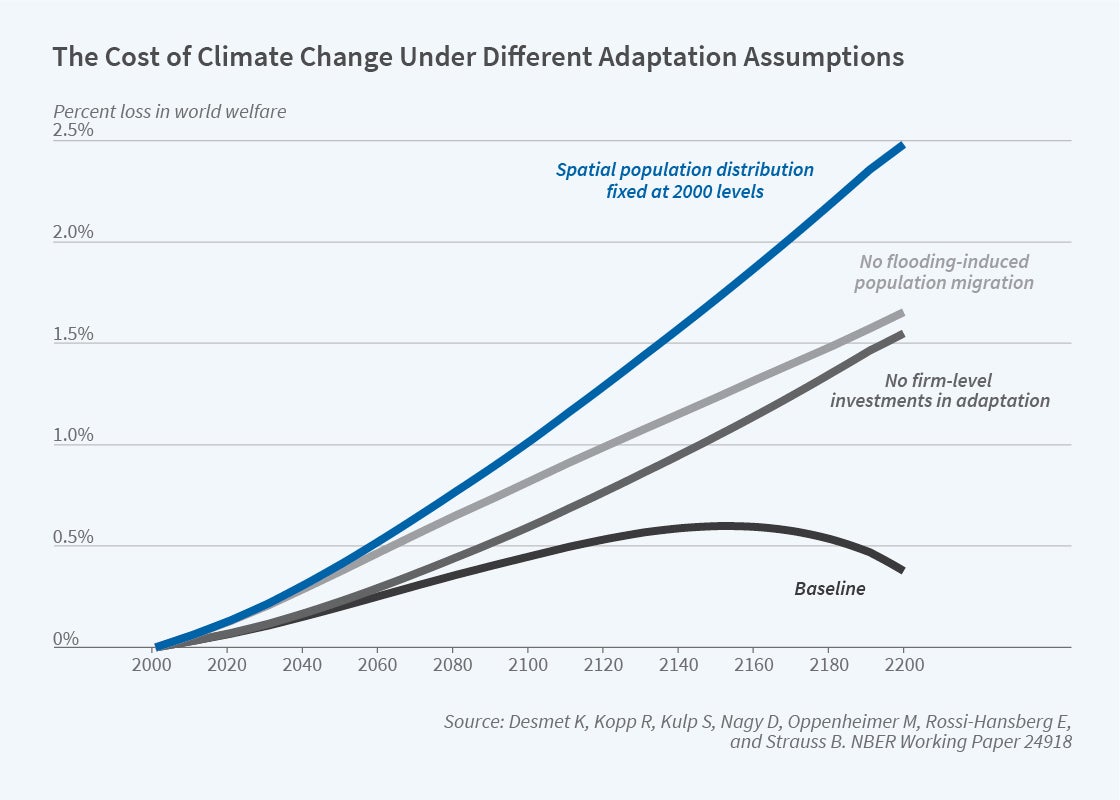
The Geography of Global Warming
In recent work, we have turned our attention from sea level rise to global warming, using a more comprehensive and sophisticated assessment model. We allow changes in local temperatures to influence three local characteristics. 5 First, changes in temperature affect local productivity, with the impact depending on the location’s initial temperature. Second, changes in temperature have an effect on the attractiveness of a location as a place to live — what is commonly referred to as a location’s amenities. Third, temperature can influence the difference between birth and death rates. Where someone is born matters because migration is costly.
In addition, we incorporate the decision of how much energy to use in production, the choice of the intensity of fossil fuels in generating energy, and the resulting CO 2 emissions of these local choices. Together with a standard carbon cycle model, this yields a framework in which the behavior of the economy affects climate scenarios and vice versa. Incorporating this two-way feedback between local economies and climate is essential if a model is going to be useful in evaluating climate policy.
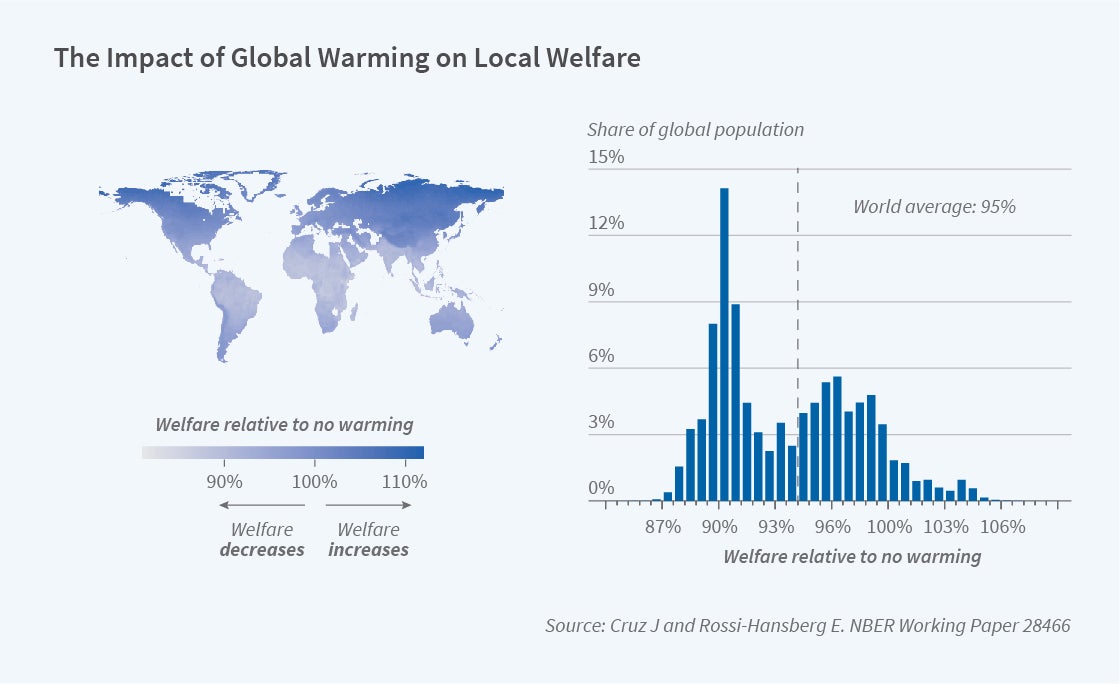
The spatial heterogeneity of the impact of global warming is stark. Figure 2 depicts the cost of global warming across the world’s geography and is expressed as welfare under global warming relative to welfare in a counterfactual scenario where temperatures do not rise. Grey and light blue areas in the map lose, while dark blue areas gain. On average, the world experiences welfare losses of 5 percent, but in the world’s poorest regions losses tend to be substantially larger, as much as 15 percent. The graph in the right panel of Figure 2 presents the population-weighted distribution of these gains and losses. The distribution is bimodal, with many areas of Central Africa, Latin America, and Southeast Asia losing about 10 percent, while many advanced economies lose only marginally and some of the northernmost regions gain. The big story is the spatial heterogeneity of the effects of climate change, and the corresponding augmenting inequality, with the world’s poorest regions being hardest hit.
A core part of the quantification of these welfare losses is the estimation of the damage functions that map changes in temperature to changes in productivity and amenities. Estimating damage functions requires using model-implied fundamental productivities and amenities, rather than final outcomes that already include the many adaptation margins that we are modeling. Using model-implied fundamentals for several periods, we can incorporate local fixed effects and regional trends when estimating the damage functions.
Our damage function estimates suggest that an increase of 1 ° C in local temperatures implies a decline in amenities of about 2.5 percent in the world’s hottest areas, and a commensurate increase in the world’s coldest areas. The effects of temperature on productivity are larger and asymmetric: a 1 ° C increase in local temperatures leads to a 15 percent decline in productivity in the warmest regions and a 10 percent increase in the coldest regions. The estimates of these semi-elasticities are statistically significant in the world’s warmest and coldest areas, but the damage functions are estimated with sizable error. This implies uncertainty in the evaluation of global warming. Future research should focus on reducing this error by getting a longer panel of data and by conditioning on not just the mean local temperature, but also on the variance and on the frequency of extreme temperatures.
Trade and Migration as Adaptation Mechanisms
In addition to migration, trade also has the potential to act as a powerful adaptation mechanism. There are, of course, situations where the scope for trade to mitigate the impact of climate change is limited. For example, if global warming affects the productivity of all local firms similarly and if changes in temperature are spatially correlated, trade may not be an effective adaptation mechanism. However, the effect of temperature on productivity likely varies by sector, so trade can help hard-hit locations switch to sectors that are less affected by climate change.
In recent research, we incorporate an agricultural and a nonagricultural sector and evaluate how changes in local specialization may operate as an adaptation mechanism. 6 Our analysis shows that the role of trade is complex. On the one hand, freer trade increases the scope of local specialization, leading to smaller losses from global warming. On the other hand, freer trade weakens the incentives for people to migrate away from today’s poorest regions, which are more affected by climate change. On balance, we find that freer trade increases losses from global warming in the near future but reduces losses in the far-off future.
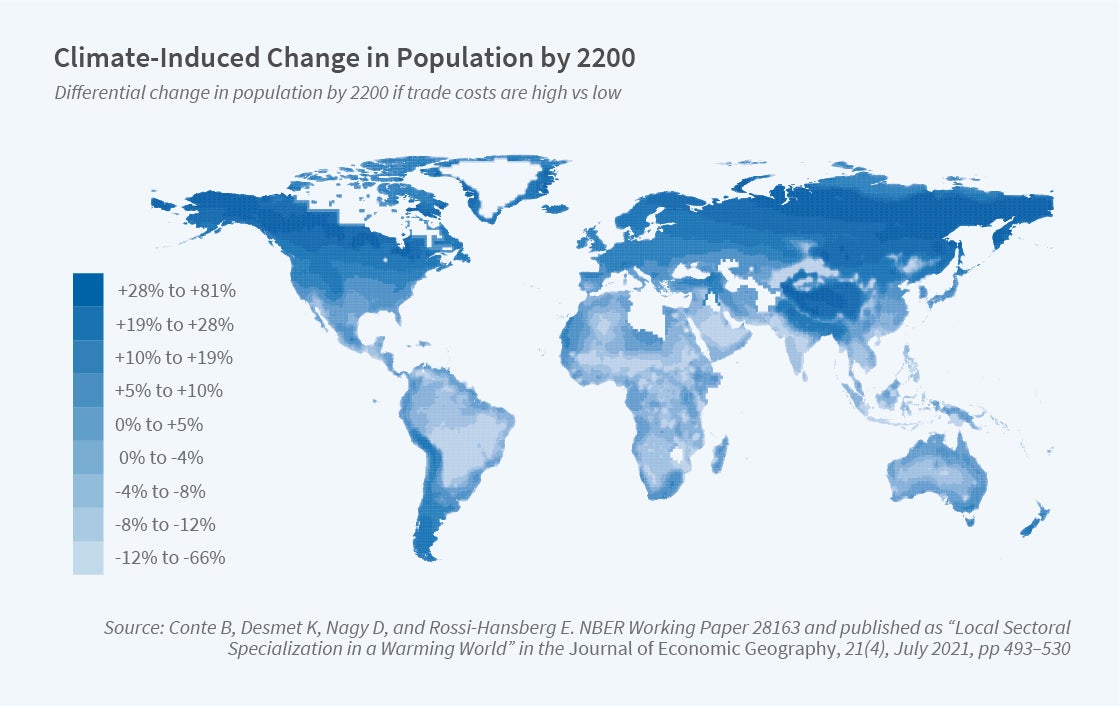
As adaptation mechanisms, trade and migration are substitutes. Figure 3 depicts the climate-induced change in population in 2200 when trade costs are high compared to when trade costs are low. Areas marked in dark blue gain more population due to rising temperatures when trade costs are high, and areas marked in light blue and grey lose more population. The map shows that more people move away from highly affected areas in equatorial regions when trade costs are higher. That is, when trade has less scope to act as an adaptation mechanism, migration plays a bigger role.
What’s Next?
We are continuing to improve our climate assessment model, estimating richer damage functions that incorporate episodic effects and their variance, incorporating anticipatory effects on investments, and adding a richer sectoral composition with input-output linkages. Our agenda includes a thorough evaluation of various environmental policies, including their spatial characteristics and implications.
Researchers
More from nber.
“ Spatial Development ,” Desmet K, Rossi-Hansberg E. NBER Working Paper 15349, revised December 2011, and American Economic Review 104(4), April 2014, pp. 1211–1243.
“ On the Spatial Economic Impact of Global Warming ,” Desmet K, Rossi-Hansberg E. NBER Working Paper 18546, November 2012, and Journal of Urban Economics 88, July 2015, pp. 16–37.
“ The Geography of Development: Evaluating Migration Restrictions and Coastal Flooding ,” Desmet K, Nagy D, Rossi-Hansberg E. NBER Working Paper 21087, April 2015, and Journal of Political Economy , 126(3), June 2018, pp. 903–983.
“ Evaluating the Economic Cost of Coastal Flooding ,” Desmet K, Kopp R, Kulp S, Nagy D, Oppenheimer M, Rossi-Hansberg E, Strauss B. NBER Working Paper 24918, August 2018, and American Economic Journal: Macroeconomics 13(2), April 2021, pp. 444–486.
“ The Economic Geography of Global Warming ,” Cruz J, Rossi-Hansberg E. NBER Working Paper 28466, February 2021.
“ Local Sectoral Specialization in a Warming World ,” Conte B, Desmet K, Nagy D, Rossi-Hansberg E. NBER Working Paper 28163, December 2020, and Journal of Economic Geography 21(4), July 2021, pp. 493–530.
NBER periodicals and newsletters may be reproduced freely with appropriate attribution.
In addition to working papers , the NBER disseminates affiliates’ latest findings through a range of free periodicals — the NBER Reporter , the NBER Digest , the Bulletin on Retirement and Disability , the Bulletin on Health , and the Bulletin on Entrepreneurship — as well as online conference reports , video lectures , and interviews .

© 2023 National Bureau of Economic Research. Periodical content may be reproduced freely with appropriate attribution.

An official website of the United States government
Here’s how you know
Official websites use .gov A .gov website belongs to an official government organization in the United States.
Secure .gov websites use HTTPS A lock ( Lock A locked padlock ) or https:// means you’ve safely connected to the .gov website. Share sensitive information only on official, secure websites.
JavaScript appears to be disabled on this computer. Please click here to see any active alerts .
Climate Change Impacts on Ecosystems

Ecosystems are communities of living things, including plants, animals, and microorganisms, that interact with each other and the physical world. 1 People depend on ecosystems for many benefits, such as food, water, clean air, building materials, and recreation. Ecosystems can be big, like the one that surrounds Yellowstone National Park, 2 or as small as a single fallen tree. They can also overlap with one another or be part of larger ecosystems. These connections between ecosystems also make them dependent on one another, and not simply dependent on the organisms within them.
Climate change affects ecosystems in many ways. Climate controls how plants grow, how animals behave, which organisms thrive, and how they all interact with the physical environment. 3 , 4 As habitats experience different temperatures, precipitation patterns, and other changes, the organisms that make up ecosystems feel the effects. All U.S. regions are experiencing the impacts of climate change but impacts vary by area and ecosystem. 5
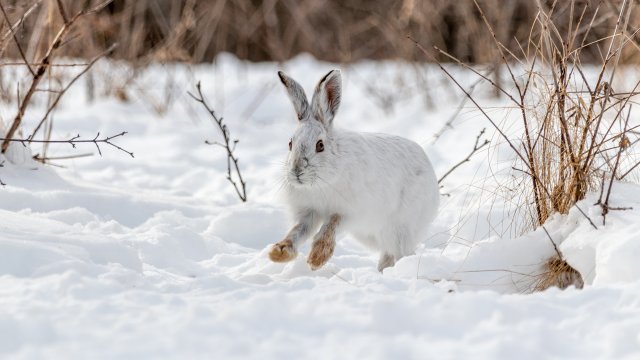
Impacts on populations' ability to survive. The white coat of the snowshoe hare makes it less visible to predators in the winter. But earlier snowmelts are making the hare stand out more against the brown forest floor, increasing its vulnerability.
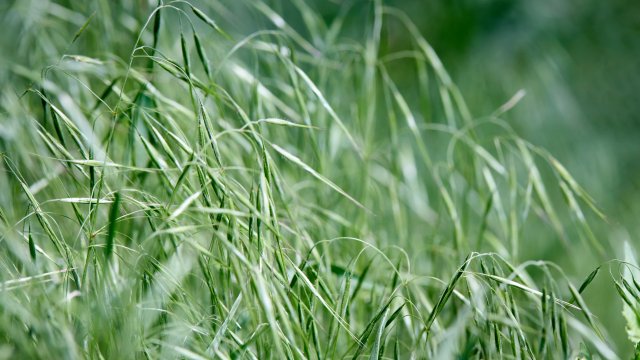
Increased spread of invasive species. Cheatgrass is an invasive species that threatens ranches in the western United States. It degrades soil nutrients and can lead to a loss of biodiversity.
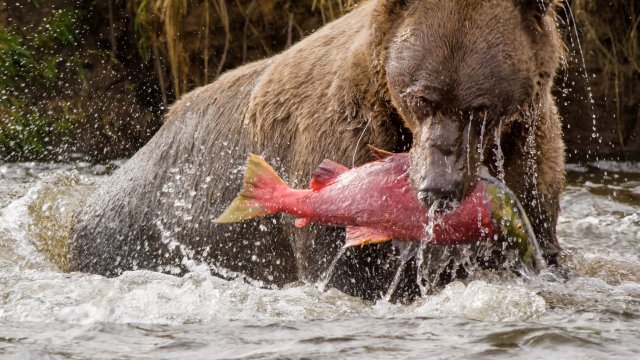
Changes in the timing of natural events. In Alaska, brown bears are switching their diet from salmon to elderberries as the berries ripen earlier due to a warming climate. 30 When bears eat less salmon, it also affects other animals in the food web, like birds that feed on the salmon carcasses bears leave behind. 31
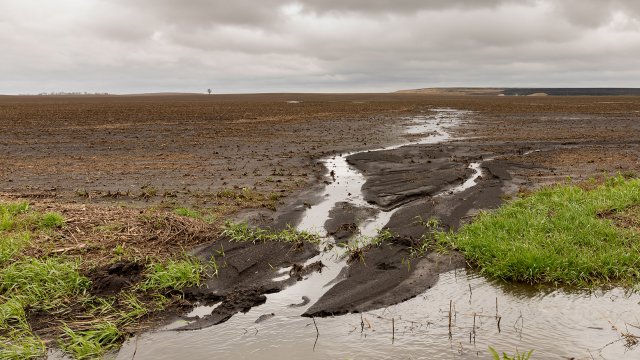
Reduced ecosystem services: erosion control. Salt marsh grasses help hold soil in place. In some areas, a change to the species balance, possibly due to changing temperatures, has allowed a grass-eating marsh crab to dominate, resulting in less grass to control erosion. 32
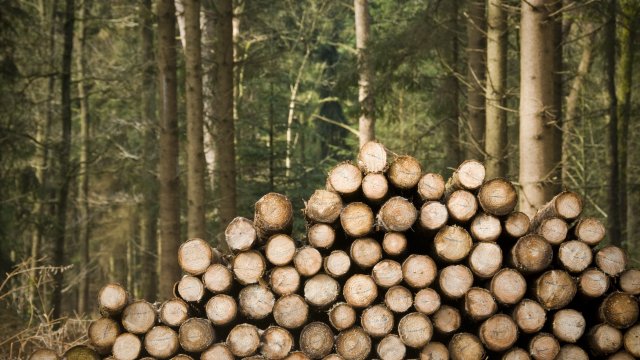
Reduced ecosystem services: lumber. Ecosystems provide Americans with needed materials such as wood. Changing precipitation patterns can influence the frequency and severity of wildfires, threatening this ecosystem service and important economic sector.
People are taking many actions to help ecosystems adapt to climate change impacts or minimize the effects. For example, federal agencies that manage the nation’s natural resources are now considering climate change in polices and planning. At the local level, many groups are preserving habitats and restoring ecosystems that have been damaged or disturbed in the past.
Explore the sections on this page to learn more about climate impacts on ecosystems:
Top Climate Impacts on Ecosystems
- Ecosystems and the Economy
Environmental Justice and Equity
What we can do, related resources, ecosystem services.
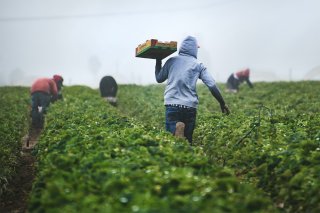
Ecosystems provide many benefits to people. These are called ecosystem services . Ecosystem services include goods from plants and animals, such as the food and wood provided by trees. They also include parts of the physical world that keep the planet safe and healthy. For example, clean lakes and streams are considered ecosystem services because we use them for drinking water and recreation.
Climate change affects ecosystems at multiple levels, from the populations that make up ecosystems to the services they provide to communities, economies, and people. Four key impacts are described in this section.
1. Changes in Species and Populations
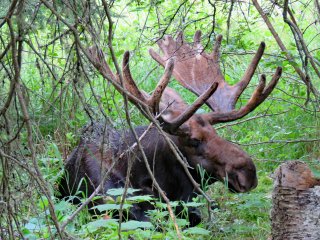
As the climate changes, some species will adapt by changing their behavior, physical characteristics, or how their bodies function. Others will not be able to adapt. As a result, climate change could lead to expansions, reductions, or extinctions of some populations. These changes, in turn, can affect the overall biodiversity of a region.
Plants and animals may also change the geographic range they inhabit in response to changing climatic conditions. Changing temperature and water conditions have already altered the ranges of many plants and animals. 6 As temperatures have warmed in the United States, some land animals have moved to the (typically cooler) north by an average of 3.8 miles per decade. 7 Some marine species have also shifted north by more than 17 miles per decade. 8
2. Changes in the Timing of Natural Events and Cycles
Many plants and animals rely on cues in nature, including temperature and water conditions, to trigger certain stages of their life cycles. As the climate changes, these cues can change at different rates, or potentially not all. As a result, species that depend on one another at certain times of the year may no longer be in sync.
For example, plankton are an important food source for young fish, but they tend to react more quickly to changes in temperature than the fish. This means the plankton might not be as available when growing fish need it most. Also, if a bird migrates at the same time each year, it could reach its destination to find that, due to shifting temperatures, its main food source grew too early and is no longer available. 10
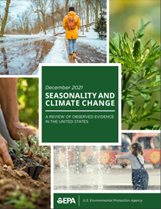
3. Changes in Ecosystem Interactions
Climate change is also changing the way species and populations interact with the environment and one another. These impacts can be felt throughout an entire ecosystem.
For example, climate change is increasing the spread of invasive species in some areas. 11 An invasive species is one that is not native to an area. Invasive species can outcompete native plants and animals, bring in new diseases, and cause other problems. These changes can create significant environmental and economic harm.
As ocean water warms, invasive fish species, such as the tropical lionfish , are expected to move north along the Atlantic coast, threatening native species. 12 This can also hurt humans, as lionfish are venomous and can sting people.
Climate change can also affect food webs. A food web is the whole set of feeding relationships among different organisms in an ecosystem. At the bottom of a food web are organisms like plants and plankton. Other animals, higher in the web, rely on them as food sources. Climate impacts on any part of a food web can affect the whole system, and even other ecosystems altogether. From the example above, if young fish cannot find enough food in the estuaries, their predators in the ocean could feel the effects as well.
4. Altered or Reduced Ecosystem Services

Climate change is affecting some of the critical services that ecosystems provide to society. 13 For example, ecosystems provide a bounty of food to people. Climate changes, like drought and heat, could affect the availability and quality of some foods , as well as farmers’ ability to grow certain crops. 14
Climate change can also affect ecosystem services such as carbon capture and storage. Forest ecosystems play a critical role in the carbon cycle, helping to absorb carbon dioxide from the atmosphere and store it in roots, soil, and the forest floor. 15 But climate-driven increases in wildfires, flooding, pests, and diseases can limit the ability of an ecosystem to provide this important service. 16
For more specific examples of climate change impacts in your region, please see the National Climate Assessment .
Ecosystems and the Economy
Ecosystems and their benefits—often referred to as ecosystem services—support key aspects of human existence. As a result, they are the foundation to large parts of the economy. Globally, ecosystem services are worth an estimated $125 to $145 trillion per year. 17

Climate change impacts affect the livelihoods of millions of Americans, including fishers, loggers, ranchers, and farmers. For example, the stress caused by rising water temperatures and ocean acidification could cost the shellfish industry hundreds of millions of dollars. 18 Shifting ranges for certain fish mean that fishers may need to travel farther to catch them or purchase new equipment to reach those areas. 19 These shifts are projected to result in losses of hundreds of millions of dollars each year by the year 2100. 20 U.S. agriculture will also experience economic impacts, though they could be both negative and positive. Climate change threatens to bring increased droughts, pests, and extreme weather events, which would take an economic toll. 21 However, earlier springs and milder winter weather can prolong growing seasons in many regions, increasing crop yields and revenues. 22
Climate change also affects the tourism and recreation industries. Harmful algal blooms already cost the country nearly $1 billion each year from the loss of recreational fishing and boating revenue. 24 Damage to coral reefs due to climate change is projected to result in $140 billion in total lost revenues to the U.S. recreation industry by 2100. 25 Communities that depend on tourism will feel these economic impacts the most.

Some communities depend on ecosystems and their services more than others, including some Indigenous and rural communities. As ecosystems change, some groups also may be able to adapt better than others due to geographic, social, or economic factors.
Indigenous communities have a unique relationship with the environment. Climate change impacts on ecosystems can harm Indigenous peoples’ ability to preserve and sustain their cultural heritage. 26 , 27 Shifting animal ranges can disrupt Indigenous peoples’ ability to hunt and fish as the animals move beyond their tribal lands. 28
Many rural communities depend on ecosystem-related livelihoods, including farming, fishing, and raising livestock. People in these areas are more likely to see economic impacts when faced with ecosystem challenges, such as invasive species and decreased soil quality. 29
We can limit climate change’s impacts on ecosystems in several ways, including the following:
- Prevent the spread of aquatic invasive species. Inspect and wash your boat before moving it to a new body of water to remove “hitchhiking” plants and animals , like zebra and quagga mussels.
- Share information. Engage in citizen science efforts to provide accurate, up-to-date information about climate change in the United States.
- Report invasive species. Reporting invasive species to the proper authorities can help them manage plants and animals that threaten native populations.
- Treat ecosystems responsibly. Practice management techniques that improve ecosystems’ health and help them be more resilient to a changing climate. For example, plant native vegetation and conserve water. In arid places planting native or drought resistant species conserves water.
- Conserve lands and grow prudently. Development can break up lands into smaller segments that can isolate species, making it harder for them to migrate or adapt to climate change. Smart conservation planning can help preserve lands and help populations thrive.
Related Climate Indicators
Learn more about some of the key indicators of climate change related to this sector from EPA’s Climate Change Indicators in the United States :
- Ecosystems Summary
- U.S. and Global Temperature
- Leaf and Bloom Dates
- Length of Growing Season
- Weather and Climate Summary
- Fifth National Climate Assessment, Chapter 8: “Ecosystems, Ecosystem Services, and Biodiversity.”
- U.S. Climate Resilience Toolkit: Ecosystems . Provides information on how ecosystems affect air and water.
- Ecosystem Services . Provides information and decision support tools around how to manage ecosystem services.
- U.S. Department of Agriculture: Climate Change Effects on Forests and Grasslands . Provides an interactive learning module explaining the main effects of climate changes on two important ecosystems.
- U.S. Geological Survey (USGS): Ecosystems . Presents the latest USGS-generated science on ways to sustainably manage ecosystems.
- U.S. Fish and Wildlife Service: Climate Change . Summarizes climate change impacts, adaptation strategies, and mitigation strategies with a focus on ecosystems.
- EPA’s Report on Seasonality and Climate Change . Summarizes the state of the science on observed changes relating to seasonality in the United States.
1 Lipton, D., et al. (2018). Ch. 7: Ecosystems, ecosystem services, and biodiversity . In: Impacts, risks, and adaptation in the United States: Fourth national climate assessment, volume II . U.S. Global Change Research Program, Washington, DC, p. 270.
2 U.S. Department of the Interior, National Park Service. (2022). Greater Yellowstone ecosystem. Retrieved 01/29/2022.
3 Lipton, D., et al. (2018). Ch. 7: Ecosystems, ecosystem services, and biodiversity . In: Impacts, risks, and adaptation in the United States: Fourth national climate assessment, volume II . U.S. Global Change Research Program, Washington, DC, p. 276.
4 Lipton, D., et al. (2018). Ch. 7: Ecosystems, ecosystem services, and biodiversity . In: Impacts, risks, and adaptation in the United States: Fourth national climate assessment, volume II . U.S. Global Change Research Program, Washington, DC, p. 273.
5 Lipton, D., et al. (2018). Ch. 7: Ecosystems, ecosystem services, and biodiversity . In: Impacts, risks, and adaptation in the United States: Fourth national climate assessment, volume II . U.S. Global Change Research Program, Washington, DC, p. 279.
6 Lipton, D., et al. (2018). Ch. 7: Ecosystems, ecosystem services, and biodiversity . In: Impacts, risks, and adaptation in the United States: Fourth national climate assessment, volume II . U.S. Global Change Research Program, Washington, DC, p. 291.
7 Lipton, D., et al. (2018). Ch. 7: Ecosystems, ecosystem services, and biodiversity . In: Impacts, risks, and adaptation in the United States: Fourth national climate assessment, volume II . U.S. Global Change Research Program, Washington, DC, p. 281.
8 Lipton, D., et al. (2018). Ch. 7: Ecosystems, ecosystem services, and biodiversity . In: Impacts, risks, and adaptation in the United States: Fourth national climate assessment, volume II . U.S. Global Change Research Program, Washington, DC, p. 281.
9 Lipton, D., et al. (2018). Ch. 7: Ecosystems, ecosystem services, and biodiversity . In: Impacts, risks, and adaptation in the United States: Fourth national climate assessment, volume II . U.S. Global Change Research Program, Washington, DC, p. 291.
10 Lipton, D., et al. (2018). Ch. 7: Ecosystems, ecosystem services, and biodiversity . In: Impacts, risks, and adaptation in the United States: Fourth national climate assessment, volume II . U.S. Global Change Research Program, Washington, DC, p. 283.
11 Lipton, D., et al. (2018). Ch. 7: Ecosystems, ecosystem services, and biodiversity . In: Impacts, risks, and adaptation in the United States: Fourth national climate assessment, volume II . U.S. Global Change Research Program, Washington, DC, p. 282.
12 Lipton, D., et al. (2018). Ch. 7: Ecosystems, ecosystem services, and biodiversity . In: Impacts, risks, and adaptation in the United States: Fourth national climate assessment, volume II . U.S. Global Change Research Program, Washington, DC, p. 278.
13 Lipton, D., et al. (2018). Ch. 7: Ecosystems, ecosystem services, and biodiversity . In: Impacts, risks, and adaptation in the United States: Fourth national climate assessment, volume II . U.S. Global Change Research Program, Washington, DC, p. 284.
14 Lipton, D., et al. (2018). Ch. 7: Ecosystems, ecosystem services, and biodiversity . In: Impacts, risks, and adaptation in the United States: Fourth national climate assessment, volume II . U.S. Global Change Research Program, Washington, DC, p. 284.
15 Vose, J.M., et al. (2018). Ch. 6: Forests . In: Impacts, risks, and adaptation in the United States: Fourth national climate assessment, volume II . U.S. Global Change Research Program, Washington, DC, p. 244.
16 Vose, J.M., et al. (2018). Ch. 6: Forests . In: Impacts, risks, and adaptation in the United States: Fourth national climate assessment, volume II . U.S. Global Change Research Program, Washington, DC, p. 244.
17 U.S. Climate Resilience Toolkit. (2021). Ecosystems . Retrieved 03/18/2022.
18 Lipton, D., et al. (2018). Ch. 7: Ecosystems, ecosystem services, and biodiversity . In: Impacts, risks, and adaptation in the United States: Fourth national climate assessment, volume II . U.S. Global Change Research Program, Washington, DC, p. 284.
19 Lipton, D., et al. (2018). Ch. 7: Ecosystems, ecosystem services, and biodiversity . In: Impacts, risks, and adaptation in the United States: Fourth national climate assessment, volume II . U.S. Global Change Research Program, Washington, DC, p. 278.
20 Moore, C., et al. (2021). Estimating the economic impacts of climate change on 16 major U.S. fisheries . Climate Change Economics , 12(1).
21 Vose, J.M., et al. (2018). Ch. 6: Forests . In: Impacts, risks, and adaptation in the United States: Fourth national climate assessment, volume II . U.S. Global Change Research Program, Washington, DC, p. 234.
22 U.S. Environmental Protection Agency (EPA). (2016). Climate change indicators in the United States . Washington, DC, p. 10.
23 Lipton, D., et al. (2018). Ch. 7: Ecosystems, ecosystem services, and biodiversity . In: Impacts, risks, and adaptation in the United States: Fourth national climate assessment, volume II . U.S. Global Change Research Program, Washington, DC, p. 270.
24 EPA. The effects: Economy . Retrieved 03/18/2022.
25 EPA. (2017). Ch. 23: Coral reefs . In: Multi-model framework for quantitative sectoral impacts analysis: A technical report for the fourth national climate assessment . Washington, DC, p. 173.
26 Jantarasami, L.C., et al. (2018). Ch. 15: Tribes and Indigenous peoples . In: Impacts, risks, and adaptation in the United States: Fourth national climate assessment, volume II . U.S. Global Change Research Program, Washington, DC, p. 582.
27 Jantarasami, L.C., et al. (2018). Ch. 15: Tribes and Indigenous peoples . In: Impacts, risks, and adaptation in the United States: Fourth national climate assessment, volume II . U.S. Global Change Research Program, Washington, DC, p. 583.
28 Jantarasami, L.C., et al. (2018). Ch. 15: Tribes and Indigenous peoples . In: Impacts, risks, and adaptation in the United States: Fourth national climate assessment, volume II . U.S. Global Change Research Program, Washington, DC, p. 584.
29 Lipton, D., et al. (2018). Ch. 7: Ecosystems, ecosystem services, and biodiversity . In: Impacts, risks, and adaptation in the United States: Fourth national climate assessment, volume II . U.S. Global Change Research Program, Washington, DC, p. 278.
30 Lipton, D., et al. (2018). Ch. 7: Ecosystems, ecosystem services, and biodiversity . In: Impacts, risks, and adaptation in the United States: Fourth national climate assessment, volume II . U.S. Global Change Research Program, Washington, DC, p. 277.
31 Carlson, S.M. (2017). Synchronous timing of food sources triggers bears to switch from salmon to berries . Proceedings of the National Academy of Sciences of the United States of America, 114 (39): 10309–10311.
32 Lipton, D., et al. (2018). Ch. 7: Ecosystems, ecosystem services, and biodiversity . In: Impacts, risks, and adaptation in the United States: Fourth national climate assessment, volume II . U.S. Global Change Research Program, Washington, DC, p. 284.
- Climate Change Impacts Home
- Agriculture and Food Supply
- Air Quality
- Built Environment
- Freshwater Resources
- Ocean and Marine Resources
- Transportation
- Human Health
- State and Regional Impacts
- Climate Equity

Search the United Nations
- What Is Climate Change
- Myth Busters
- Renewable Energy
- Finance & Justice
- Initiatives
- Sustainable Development Goals
- Paris Agreement
- Climate Ambition Summit 2023
- Climate Conferences
- Press Material
- Communications Tips
What Is Climate Change?
Climate change refers to long-term shifts in temperatures and weather patterns. Such shifts can be natural, due to changes in the sun’s activity or large volcanic eruptions. But since the 1800s, human activities have been the main driver of climate change , primarily due to the burning of fossil fuels like coal, oil and gas.
Burning fossil fuels generates greenhouse gas emissions that act like a blanket wrapped around the Earth, trapping the sun’s heat and raising temperatures.
The main greenhouse gases that are causing climate change include carbon dioxide and methane. These come from using gasoline for driving a car or coal for heating a building, for example. Clearing land and cutting down forests can also release carbon dioxide. Agriculture, oil and gas operations are major sources of methane emissions. Energy, industry, transport, buildings, agriculture and land use are among the main sectors causing greenhouse gases.

Humans are responsible for global warming
Climate scientists have showed that humans are responsible for virtually all global heating over the last 200 years. Human activities like the ones mentioned above are causing greenhouse gases that are warming the world faster than at any time in at least the last two thousand years.
The average temperature of the Earth’s surface is now about 1.1°C warmer than it was in the late 1800s (before the industrial revolution) and warmer than at any time in the last 100,000 years. The last decade (2011-2020) was the warmest on record , and each of the last four decades has been warmer than any previous decade since 1850.
Many people think climate change mainly means warmer temperatures. But temperature rise is only the beginning of the story. Because the Earth is a system, where everything is connected, changes in one area can influence changes in all others.
The consequences of climate change now include, among others, intense droughts, water scarcity, severe fires, rising sea levels, flooding, melting polar ice, catastrophic storms and declining biodiversity.

People are experiencing climate change in diverse ways
Climate change can affect our health , ability to grow food, housing, safety and work. Some of us are already more vulnerable to climate impacts, such as people living in small island nations and other developing countries. Conditions like sea-level rise and saltwater intrusion have advanced to the point where whole communities have had to relocate, and protracted droughts are putting people at risk of famine. In the future, the number of people displaced by weather-related events is expected to rise.
Every increase in global warming matters
In a series of UN reports , thousands of scientists and government reviewers agreed that limiting global temperature rise to no more than 1.5°C would help us avoid the worst climate impacts and maintain a livable climate. Yet policies currently in place point to a 3°C temperature rise by the end of the century.
The emissions that cause climate change come from every part of the world and affect everyone, but some countries produce much more than others .The seven biggest emitters alone (China, the United States of America, India, the European Union, Indonesia, the Russian Federation, and Brazil) accounted for about half of all global greenhouse gas emissions in 2020.
Everyone must take climate action, but people and countries creating more of the problem have a greater responsibility to act first.

We face a huge challenge but already know many solutions
Many climate change solutions can deliver economic benefits while improving our lives and protecting the environment. We also have global frameworks and agreements to guide progress, such as the Sustainable Development Goals , the UN Framework Convention on Climate Change and the Paris Agreement . Three broad categories of action are: cutting emissions, adapting to climate impacts and financing required adjustments.
Switching energy systems from fossil fuels to renewables like solar or wind will reduce the emissions driving climate change. But we have to act now. While a growing number of countries is committing to net zero emissions by 2050, emissions must be cut in half by 2030 to keep warming below 1.5°C. Achieving this means huge declines in the use of coal, oil and gas: over two-thirds of today’s proven reserves of fossil fuels need to be kept in the ground by 2050 in order to prevent catastrophic levels of climate change.

Adapting to climate consequences protects people, homes, businesses, livelihoods, infrastructure and natural ecosystems. It covers current impacts and those likely in the future. Adaptation will be required everywhere, but must be prioritized now for the most vulnerable people with the fewest resources to cope with climate hazards. The rate of return can be high. Early warning systems for disasters, for instance, save lives and property, and can deliver benefits up to 10 times the initial cost.
We can pay the bill now, or pay dearly in the future
Climate action requires significant financial investments by governments and businesses. But climate inaction is vastly more expensive. One critical step is for industrialized countries to fulfil their commitment to provide $100 billion a year to developing countries so they can adapt and move towards greener economies.

To get familiar with some of the more technical terms used in connection with climate change, consult the Climate Dictionary .
Learn more about…

The facts on climate and energy
Climate change is a hot topic – with myths and falsehoods circulating widely. Find some essential facts here .

The science
See the latest climate reports from the United Nations as well as climate action facts .

Causes and Effects
Fossil fuels are by far the largest contributor to the greenhouse gas emissions that cause climate change, which poses many risks to all forms of life on Earth. Learn more .

From the Secretary-General
Read the UN Chief’s latest statements on climate action.

What is net zero? Why is it important? Our net-zero page explains why we need steep emissions cuts now and what efforts are underway.

Renewable energy – powering a safer future
What is renewable energy and why does it matter? Learn more about why the shift to renewables is our only hope for a brighter and safer world.

How will the world foot the bill? We explain the issues and the value of financing climate action.

What is climate adaptation? Why is it so important for every country? Find out how we can protect lives and livelihoods as the climate changes.

Climate Issues
Learn more about how climate change impacts are felt across different sectors and ecosystems.

Why women are key to climate action
Women and girls are on the frontlines of the climate crisis and uniquely situated to drive action. Find out why it’s time to invest in women.
Facts and figures
- What is climate change?
- Causes and effects
- Myth busters
Cutting emissions
- Explaining net zero
- High-level expert group on net zero
- Checklists for credibility of net-zero pledges
- Greenwashing
- What you can do
Clean energy
- Renewable energy – key to a safer future
- What is renewable energy
- Five ways to speed up the energy transition
- Why invest in renewable energy
- Clean energy stories
- A just transition
Adapting to climate change
- Climate adaptation
- Early warnings for all
- Youth voices
Financing climate action
- Finance and justice
- Loss and damage
- $100 billion commitment
- Why finance climate action
- Biodiversity
- Human Security
International cooperation
- What are Nationally Determined Contributions
- Acceleration Agenda
- Climate Ambition Summit
- Climate conferences (COPs)
- Youth Advisory Group
- Action initiatives
- Secretary-General’s speeches
- Press material
- Fact sheets
- Communications tips
- Climate modelling
- Extreme weather
- Health and Security
- Temperature
- China energy
- Oil and gas
- Other technologies
- China Policy
- International policy
- Other national policy
- Rest of world policy
- UN climate talks
- Country profiles
- Guest posts
- Infographics
- Media analysis
- State of the climate
- Translations
- Daily Brief
- China Briefing
- Comments Policy
- Cookies Policy
- Global emissions
- Rest of world emissions
- UK emissions
- EU emissions
- Global South Climate Database
- Newsletters
- COP21 Paris
- COP22 Marrakech
- COP24 Katowice
- COP25 Madrid
- COP26 Glasgow
- COP27 Sharm el-Sheikh
- COP28 Dubai
- Privacy Policy
- Attribution
- Geoengineering
- Food and farming
- Plants and forests
- Marine life
- Ocean acidification
- Ocean warming
- Sea level rise
- Human security
- Public health
- Public opinion
- Risk and adaptation
- Science communication
- Carbon budgets
- Climate sensitivity
- GHGs and aerosols
- Global temperature
- Negative emissions
- Rest of world temperature
- Tipping points
- UK temperature
- Thank you for subscribing
Social Channels
Search archive.

Receive a Daily or Weekly summary of the most important articles direct to your inbox, just enter your email below. By entering your email address you agree for your data to be handled in accordance with our Privacy Policy .

Roz Pidcock
Which of the many thousands of papers on climate change published each year in scientific journals are the most successful? Which ones have done the most to advance scientists’ understanding, alter the course of climate change research, or inspire future generations?
On Wednesday, Carbon Brief will reveal the results of our analysis into which scientific papers on the topic of climate change are the most “cited”. That means, how many times other scientists have mentioned them in their own published research. It’s a pretty good measure of how much impact a paper has had in the science world.
But there are other ways to measure influence. Before we reveal the figures on the most-cited research, Carbon Brief has asked climate experts what they think are the most influential papers.
We asked all the coordinating lead authors, lead authors and review editors on the last Intergovernmental Panel on Climate Change (IPCC) report to nominate three papers from any time in history. This is the exact question we posed:
What do you consider to be the three most influential papers in the field of climate change?
As you might expect from a broad mix of physical scientists, economists, social scientists and policy experts, the nominations spanned a range of topics and historical periods, capturing some of the great climate pioneers and the very latest climate economics research.
Here’s a link to our summary of who said what . But one paper clearly takes the top spot.
Winner: Manabe & Wetherald ( 1967 )
With eight nominations, a seminal paper by Syukuro Manabe and Richard. T. Wetherald published in the Journal of the Atmospheric Sciences in 1967 tops the Carbon Brief poll as the IPCC scientists’ top choice for the most influential climate change paper of all time.
Entitled, “Thermal Equilibrium of the Atmosphere with a Given Distribution of Relative Humidity”, the work was the first to represent the fundamental elements of the Earth’s climate in a computer model, and to explore what doubling carbon dioxide (CO2) would do to global temperature.
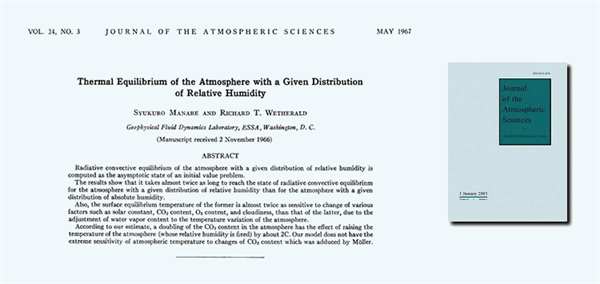
Manabe & Wetherald (1967), Journal of the Atmospheric Sciences
The Manabe & Wetherald paper is considered by many as a pioneering effort in the field of climate modelling, one that effectively opened the door to projecting future climate change. And the value of climate sensitivity is something climate scientists are still grappling with today .
Prof Piers Forster , a physical climate scientist at Leeds University and lead author of the chapter on clouds and aerosols in working group one of the last IPCC report, tells Carbon Brief:
This was really the first physically sound climate model allowing accurate predictions of climate change.
The paper’s findings have stood the test of time amazingly well, Forster says.
Its results are still valid today. Often when I’ve think I’ve done a new bit of work, I found that it had already been included in this paper.
Prof Steve Sherwood , expert in atmospheric climate dynamics at the University of New South Wales and another lead author on the clouds and aerosols chapter, says it’s a tough choice, but Manabe & Wetherald (1967) gets his vote, too. Sherwood tells Carbon Brief:
[The paper was] the first proper computation of global warming and stratospheric cooling from enhanced greenhouse gas concentrations, including atmospheric emission and water-vapour feedback.
Prof Danny Harvey , professor of climate modelling at the University of Toronto and lead author on the buildings chapter in the IPCC’s working group three report on mitigation, emphasises the Manabe & Wetherald paper’s impact on future generations of scientists. He says:
[The paper was] the first to assess the magnitude of the water vapour feedback, and was frequently cited for a good 20 years after it was published.
Tomorrow, Carbon Brief will be publishing an interview with Syukuro Manabe, alongside a special summary by Prof John Mitchell , the Met Office Hadley Centre’s chief scientist from 2002 to 2008 and director of climate science from 2008 to 2010, on why the paper still holds such significance today.
Joint second: Keeling, C.D et al. ( 1976 )
Jumping forward a decade, a classic paper by Charles Keeling and colleagues in 1976 came in joint second place in the Carbon Brief survey.
Published in the journal Tellus under the title, “Atmospheric carbon dioxide variations at Mauna Loa observatory,” the paper documented for the first time the stark rise of carbon dioxide in the atmosphere at the Mauna Loa observatory in Hawaii.
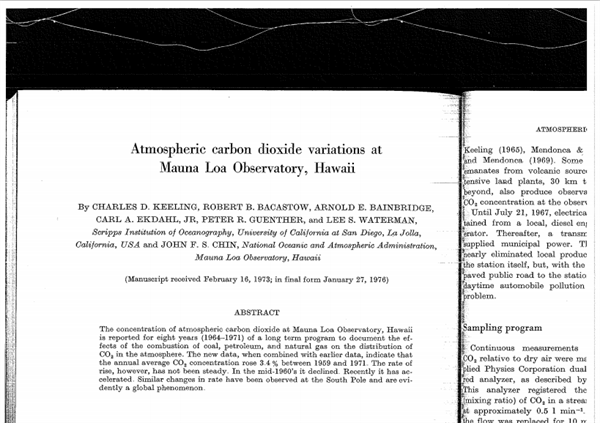
A photocopy of Keeling et al., (1976) Source: University of California, Santa Cruz
Dr Jorge Carrasco , Antarctic climate change researcher at the University of Magallanes in Chile and lead author on the cryosphere chapter in the last IPCC report, tells Carbon Brief why the research underpinning the “Keeling Curve’ was so important.
This paper revealed for the first time the observing increased of the atmospheric CO2 as the result of the combustion of carbon, petroleum and natural gas.
Prof David Stern , energy and environmental economist at the Australian National University and lead author on the Drivers, Trends and Mitigation chapter of the IPCC’s working group three report, also chooses the 1976 Keeling paper, though he notes:
This is a really tough question as there are so many dimensions to the climate problem – natural science, social science, policy etc.
With the Mauna Loa measurements continuing today , the so-called “Keeling curve” is the longest continuous record of carbon dioxide concentration in the world. Its historical significance and striking simplicity has made it one of the most iconic visualisations of climate change.
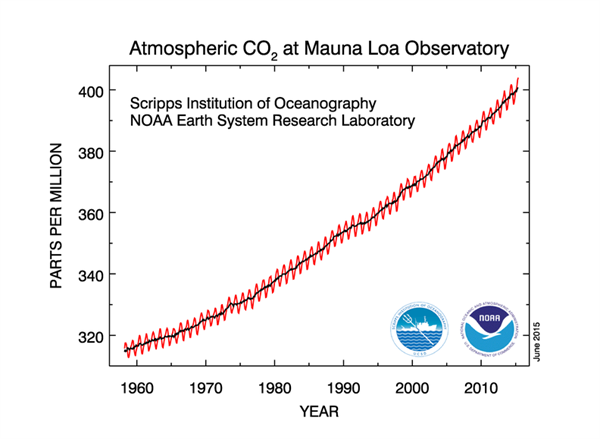
Source: US National Oceanic and Atmospheric Administration (NOAA)
Also in joint second place: Held, I.M. & Soden, B.J. ( 2006 )
Fast forwarding a few decades, in joint second place comes a paper by Isaac Held and Brian Soden published in the journal Science in 2006.
The paper, “Robust Responses of the Hydrological Cycle to Global Warming”, identified how rainfall from one place to another would be affected by climate change. Prof Sherwood, who nominated this paper as well as the winning one from Manabe and Wetherald, tells Carbon Brief why it represented an important step forward. He says:
[This paper] advanced what is known as the “wet-get-wetter, dry-get-drier” paradigm for precipitation in global warming. This mantra has been widely misunderstood and misapplied, but was the first and perhaps still the only systematic conclusion about regional precipitation and global warming based on robust physical understanding of the atmosphere.

Held & Soden (2006), Journal of Climate
Honourable mentions
Rather than choosing a single paper, quite a few academics in our survey nominated one or more of the Working Group contributions to the last IPCC report. A couple even suggested the Fifth Assessment Report in its entirety, running to several thousands of pages. The original IPCC report , published in 1990, also got mentioned.
It was clear from the results that scientists tended to pick papers related to their own field. For example, Prof Ottmar Edenhofer , chief economist at the Potsdam Institute for Climate Impact Research and co-chair of the IPCC’s Working Group Three report on mitigation, selected four papers from the last 20 years on the economics of climate change costs versus risks, recent emissions trends, the technological feasibility of strong emissions reductions and the nature of international climate cooperation.
Taking a historical perspective, a few more of the early pioneers of climate science featured in our results, too. For example, Svante Arrhenius’ famous 1896 paper on the Greenhouse Effect, entitled “On the influence of carbonic acid in the air upon the temperature of the ground”, received a couple of votes.
Prof Jonathan Wiener , environmental policy expert at Duke University in the US and lead author on the International Cooperation chapter in the IPCC’s working group three report, explains why this paper should be remembered as one of the most influential in climate policy. He says:
[This is the] classic paper showing that rising greenhouse gas concentrations lead to increasing global average surface temperature.

Svante Arrhenius (1896), Philosophical Magazine
A few decades later, a paper by Guy Callendar in 1938 linked the increase in carbon dioxide concentration over the previous 50 years to rising temperatures. Entitled, “The artificial production of carbon dioxide and its influence on temperature,” the paper marked an important step forward in climate change research, says Andrew Solow , director of the Woods Hole Marine Policy centre and lead author on the detection and attribution of climate impacts chapter in the IPCC’s working group two report. He says:
There is earlier work on the greenhouse effect, but not (to my knowledge) on the connection between increasing levels of CO2 and temperature.
Though it may feature in the climate change literature hall of fame, this paper raises a question about how to define a paper’s influence, says Forster. Rather than being celebrated among his contemporaries, Callendar’s work achieved recognition a long time after it was published. Forster says:
I would loved to have chosen Callendar (1938) as the first attribution paper that changed the world. Unfortunately, the 1938 effort of Callendar was only really recognised afterwards as being a founding publication of the field … The same comment applies to earlier Arrhenius and Tyndall efforts. They were only influential in hindsight.
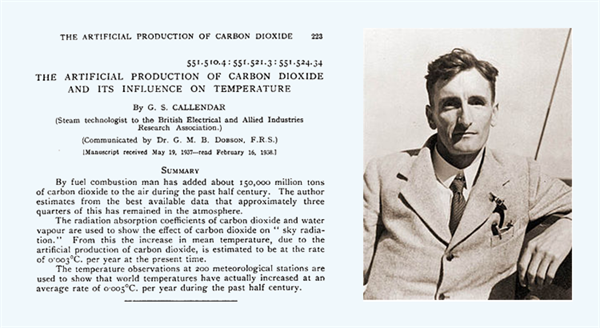
Guy Callendar and his 1938 paper in Quarterly Journal of the Royal Meteorological Society
Other honourable mentions in the Carbon Brief survey of most influential climate papers go to Norman Phillips, whose 1956 paper described the first general circulation model, William Nordhaus’s 1991 paper on the economics of the greenhouse effect, and a paper by Camile Parmesan and Gary Yohe in 2003 , considered by many to provide the first formal attribution of climate change impacts on animal and plant species.
Finally, James Hansen’s 2012 paper , “Public perception of climate change and the new climate dice”, was important in highlighting the real-world impacts of climate change, says Prof Andy Challinor , expert in climate change impacts at the University of Leeds and lead author on the food security chapter in the working group two report. He says:
[It] helped with demonstrating the strong links between extreme events this century and climate change. Result: more clarity and less hedging.
Marc Levi , a political scientist at Columbia University and lead author on the IPCC’s human security chapter, makes a wider point, telling Carbon Brief:
The importance is in showing that climate change is observable in the present.
Indeed, attribution of extreme weather continues to be at the forefront of climate science, pushing scientists’ understanding of the climate system and modern technology to their limits.
Look out for more on the latest in attribution research as Carbon Brief reports on the Our Common Futures Under Climate Change conference taking place in Paris this week.
Pinning down which climate science papers most changed the world is difficult, and we suspect climate scientists could argue about this all day. But while the question elicits a range of very personal preferences, stories and characters, one paper has clearly stood the test of time and emerged as the popular choice among today’s climate experts – Manabe and Wetherald, 1967.
Main image: Satellite image of Hurricane Katrina.
- What are the most influential climate change papers of all time?
Expert analysis direct to your inbox.
Get a round-up of all the important articles and papers selected by Carbon Brief by email. Find out more about our newsletters here .
Advertisement
Environment
Wildfire smoke may be deadliest effect of climate change in us.
Smoke from wildfires made worse by climate change is set to cause thousands of additional deaths each year in the US
By James Dinneen
25 March 2024

Increased exposure to wildfire smoke is one of the most damaging effects of climate change
Nasa's Earth Observatory
Exposure to rising levels of wildfire smoke could lead to more than 10,000 additional deaths each year in the US by 2050. This could make deaths due to wildfire smoke the costliest consequence of climate change for the country, accounting for nearly as much economic damage as all other climate-related impacts combined.
“It completely reshapes how we think about the climate impact in the US,” says Minghao Qiu at Stanford University in California. Exposure…
Sign up to our weekly newsletter
Receive a weekly dose of discovery in your inbox! We'll also keep you up to date with New Scientist events and special offers.
To continue reading, subscribe today with our introductory offers
No commitment, cancel anytime*
Offer ends 2nd of July 2024.
*Cancel anytime within 14 days of payment to receive a refund on unserved issues.
Inclusive of applicable taxes (VAT)
Existing subscribers
More from New Scientist
Explore the latest news, articles and features
Dust clouds from the Sahara are reaching Europe more frequently
Subscriber-only
The war in Gaza is creating a health crisis that will span decades
Eerie green sunsets after 1883 krakatoa eruption finally explained, 1 in 8 people worldwide has obesity, popular articles.
Trending New Scientist articles
The Economic Consequences of Climate Change: An Interview with Nobel Laureate William Nordhaus

William Nordhaus and Lint Barrage (PhD ’13)
What are the economic consequences and opportunities of climate change? How do you integrate economic analysis with the science of climate change?
These questions are at the heart of Nobel laureate William Nordhaus ’s career, and in research released this week in the Proceedings of the National Academy of Sciences (PNAS), he and coauthor Lint Barrage (PhD ’13) present new findings from the updated DICE-2023 model, with major implications for global climate policy.
The DICE model (the Dynamic Integrated model for Climate and the Economy) is one of the first integrated assessment models or IAMs . This approach provides policy-relevant insights into global environmental issues through quantitative descriptions of key processes in human and earth systems. IAMs model the climate problem from end to end, from economy to emissions to atmospheric chemistry to climate dynamics, then on to impacts such as sea-level rise, wildfire, and health impacts, and finally closing the loop by including policies to bend the curve of CO2 emissions. The outputs of these models play a key role in understanding key relationships and formulating efficient policies to slow or reverse the trends.
One important finding is that international climate policy has set ambitious goals but has failed to establish an architecture for implementation…Additionally, we estimate that current policies will lead the global mean temperature increase (above pre-industrial levels) to pass the 1.5 °C target later in this decade, while without major policy changes, the globe will surpass the 2 °C goal of the Paris Accord by mid-century.” - William Nordhaus
The original DICE model was developed and published at Yale in 1992 and is the most widely used climate-change integrated assessment model. The US and other governments employ it to calculate the social cost of carbon, as well as create consistent scenarios and evaluate policies and uncertainties. The new study updates the 2016 DICE model with revised treatments of the carbon cycle, damages, discounting, and also includes results on the Paris Accord and temperature-limited scenarios.

Among the key findings from the new study, the authors note that both current policies and the extended Paris Accord fall far short of limiting global warming to 2 °C. They also highlight the substantial economic stakes at play in global climate policy: in the efficient scenario, where climate change policies maximize economic welfare according to the principles of cost–benefit analysis—they estimate a net present value of economic benefits of around $120 trillion.
Journal Publication

In the Q&A below, author and Nobel laureate William Nordhaus discusses the key findings and implications of this new research.
What are the major new findings today? What are the major surprises?

One important finding is that international climate policy has set ambitious goals but has failed to establish a realistic architecture for implementation. This is seen in the “price of carbon” (or the cost to polluters of emitting CO2 into the atmosphere) that is far below the level necessary to reach international goals. We estimate that a global carbon price of $80 per ton of CO2 would be necessary to reach the goals of the 2015 Paris Accord. Yet, the World Bank estimates that the current global price is only a tiny $3 per ton.
Additionally, we estimate that current policies will lead the global mean temperature increase (above pre-industrial levels) to pass the 1.5 °C target later in this decade, while the globe will surpass the 2 °C goal of the Paris Accord by mid-century without major policy changes. All this might not be a big surprise – perhaps alarm is a better word. Professor Barrage and I emphasize that it is critically important to recognize how countries’ climate policies fall so far short of their rhetoric and goals, and this is borne out by the recent release of DICE 2023.
What does this new study say about the “social cost of carbon”?
This critical measure (“SCC” for short) is the most important single economic concept in the economics of climate change. It designates the current and future damages caused by an additional ton of carbon dioxide emissions or its equivalent. The SCC has become a central tool used in climate change policy, particularly in the determination of regulatory policies that involve greenhouse gas emissions. The SCC has been used by the US government in rules that provide more than $1 trillion in benefits. Integrated models like DICE are essential to the calculation of the SCC and have been used by many governments in their formulation of climate policies.
We estimate that the SCC is around $80 per ton of CO2 in today’s dollars. With about 5 billion tons annually of emissions, this represents a debit of about $400 billion for the US economy (out of a total output of $28 trillion). This is a useful finding because it shows again how inadequate climate policy is because current carbon prices are so far below our estimates of SCC. The figure below shows alternative estimates of the SCC from the publication.
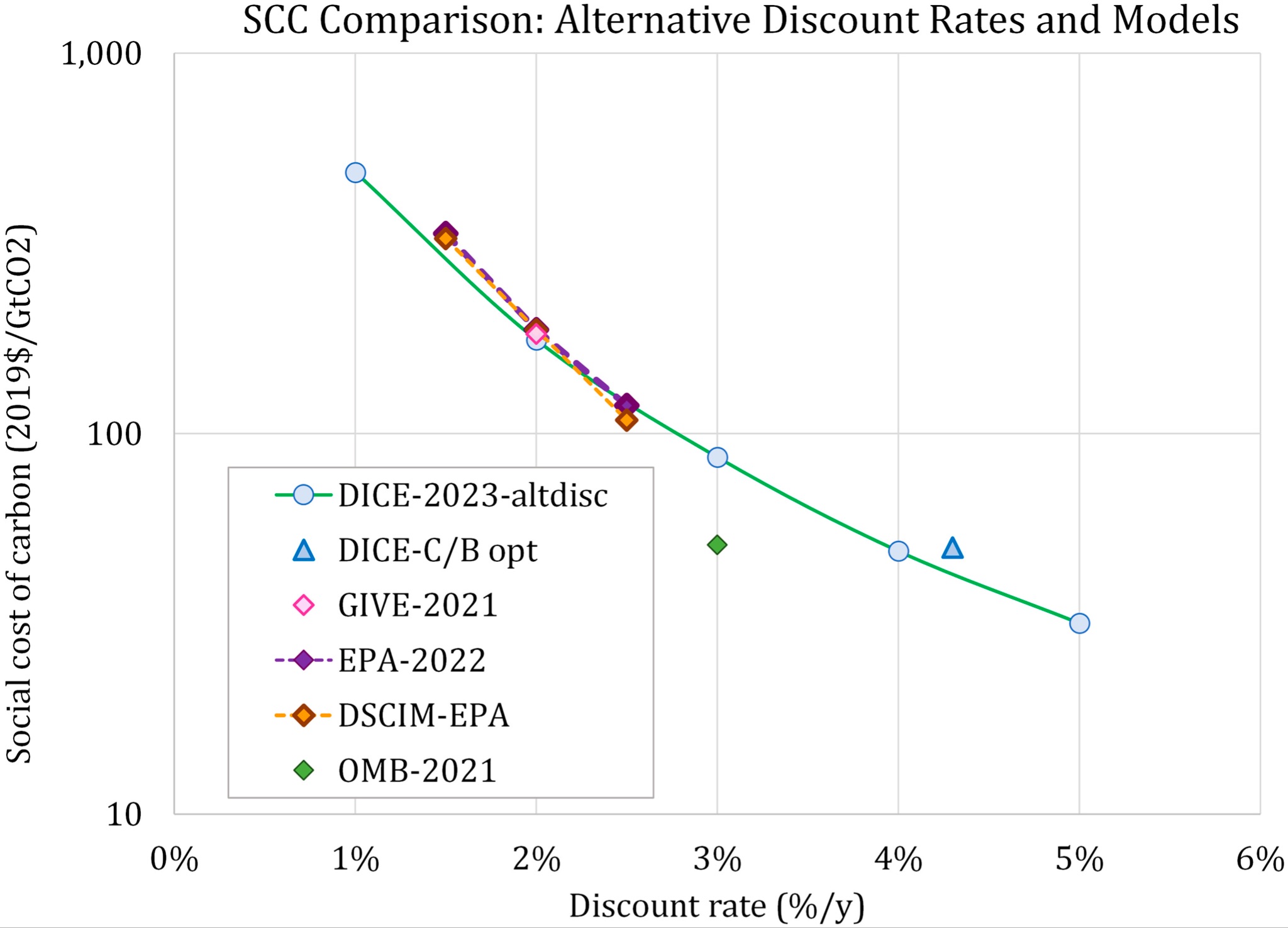
Figure 4 from the article shows the relationship between the social cost of carbon and the discount rate for different scenarios of the DICE-2023 and several other models.
What suggestions for climate policy emerge from your work?
Looking at the landscape of climate policy, we see three necessary aspects of an effective policy.
The first , mentioned above, is that countries need to raise carbon prices sharply to provide appropriate incentives for the private and public sectors to reduce emissions. This cannot be done overnight, obviously, but we need to move forward with this critical step as soon as possible. Here in the United States, there is an unusual opportunity because major tax provisions expire next year, and we face the need to either raise income taxes substantially or find other revenue sources. This would be a good time to replace the scheduled increases in income taxes with taxes on carbon emissions.
The second step is to replace the flawed international architecture on climate policy with a structure with carrots and sticks for incentivizing countries to participate in strong policies. I have called this the “climate club” to suggest a structure of pricing policies along with penalties for countries who do not participate. The flawed structure of current international agreements is a major reason why so little progress has been made to curtail carbon emissions to date.
The final step is to recognize that a policy of decarbonizing our economies will require major new technologies – ones that are only in the laboratories or at small scale – and that these need strong government fiscal support. Examples of such technologies are advanced renewables, negative-emissions technologies, and futuristic technologies such as fusion, advanced nuclear, and superconducting networks.
The most important support would be government subsidies for fundamental and applied research on green energy technologies. It is striking how little governments have recognized the importance of this aspect of climate policy. Major countries today provide only $40 billion of support for green energy R&D. This is less than half of the money that companies in the United States devote to research and development in pharmaceuticals. We do not have a prayer of reaching our climate goals without strong government research support.
These three steps are hardly revolutionary in concept, but they are awesomely challenging politically. They are the best chance for the community of nations to prevent the growing threats to humans and the global environment of rapid climate change.
The modeling behind DICE-2023 sounds like a major enterprise. Are these models complex to code and calculate?
The models themselves are relatively small compared to many scientific studies (you can see some representative code below). But they have a particularly complex structure because they are “optimization models,” which means that they solve for the least-cost or highest-value path of the variables.
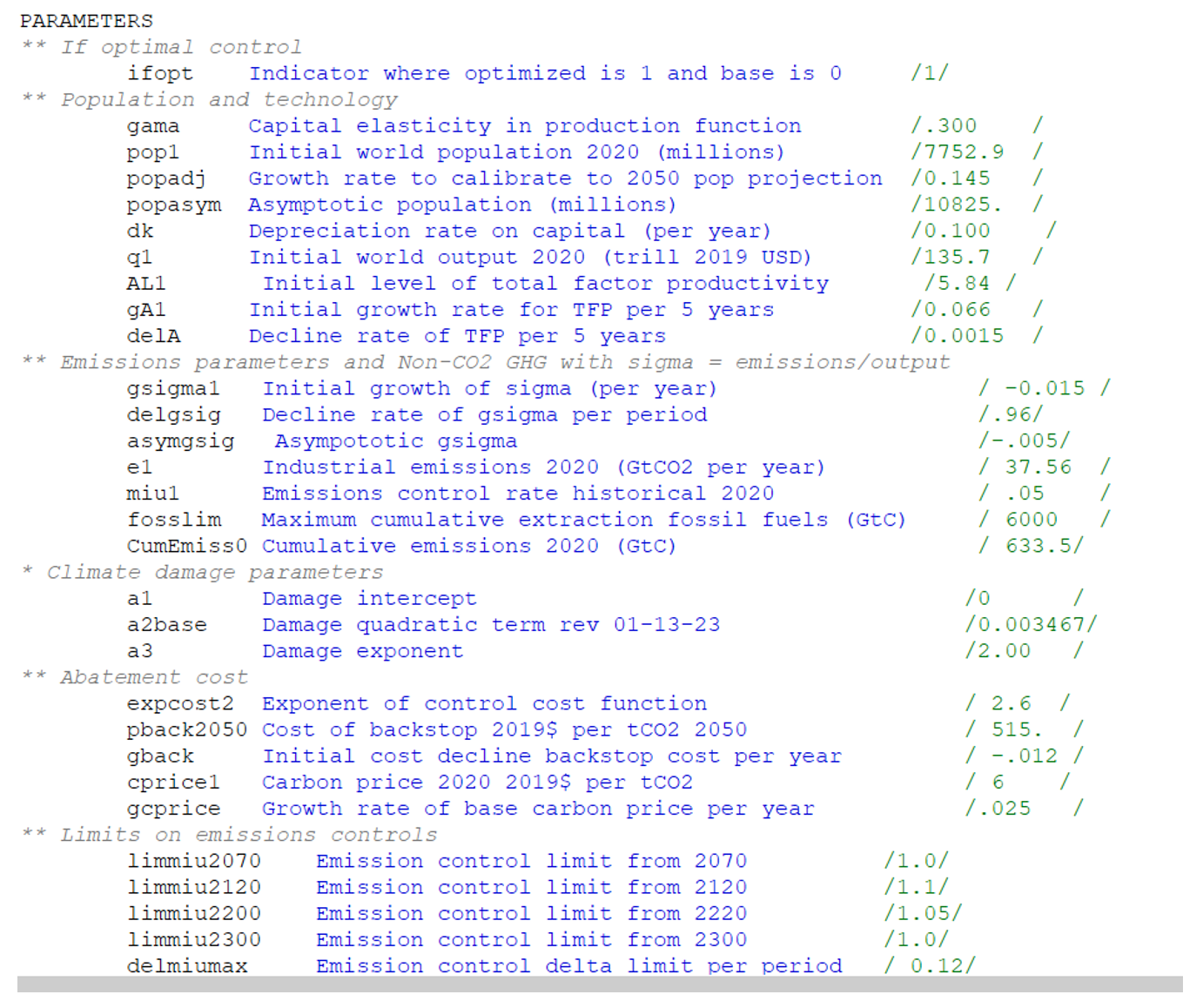
If you excuse a little excursion into geekiness, I will explain a bit more. The simplest version of DICE has 1475 variables and 1381 linear and nonlinear constraints.
Solving this problem would not have been remotely possible without modern mathematics, software, and hardware, but today’s PCs can solve it in only 1.3 seconds. One interesting feature is that the solution is so fast and robust because of the development of an algorithm known as “linear programming,” by Yale economist Tjalling Koopmans, for which he won the 1974 Nobel Prize in Economics.
What has been Yale's role in the development of integrated models like DICE?
Yale has been in the forefront of integrated climate-economic modeling for decades. Contributors to earlier DICE-related studies over the years have been Yale scholars such as Robert Mendelsohn and Ken Gillingham at the Environment School and Economics Department faculty such as Tony Smith (Chair of Economics) and Sam Kortum . Yale-derived work has pioneered DICE spinoffs, such as multi-region versions, ones introducing uncertainty, approaches with research and development, and learning by doing.
I would emphasize, however, that each new study and every passing year reveal new complexities and challenges. A world aflame with wildfires, and New Yorkers sheltering from record-setting pollution from Canadian fires, are the surprises that await us in the years ahead if unchecked warming continues.
- Support Our Work
- Carr Center Advisory Board
- Technology & Human Rights
- Racial Justice
- Transitional Justice
- Reimagining Rights & Responsibilities
- Human Rights Defenders
- In Conversation
- Justice Matters Podcast
- News and Announcements
- Student Opportunities
- Fellowship Opportunities
Making a Movement: Henry Lee on Who Shoulders the Costs of Climate Change
In this section, hks affiliated authors.

In his essay for the Carr Center's latest publication, Making a Movement: The History and Future of Human Rights , Henry Lee discusses the impacts of climate change on our human rights—and how we must ensure equity in our global contributions to climate adaptation.
Henry Lee, Director, Environmental and Natural Resource Program, Belfer Center for Science and International Affairs; Senior Lecturer in Public Policy, Harvard Kennedy School
"The United Nations has repeatedly stated that climate change has clear and immediate implications for human rights. Certainly, its impacts affect the lives and well-being of people around the world.
"Sudden onset events, such as more intense storms, floods, and wildfires, directly threaten personal security, while slower forms of climate degradation affect access to food, potable water, sanitation, and livelihoods. Internationally, there is relatively broad—though not unanimous— belief that these damages threaten basic human rights. However, there is far less consensus on who is responsible for protecting and fulfilling these rights.
"While governments in richer countries have the financial ability to move funds and protect the more vulnerable segments of their population, such is not the case in Bangladesh, Somalia, or Vanuatu. If we accept that all people deserve to be protected from climate-induced disasters, do the developed countries that historically contributed the most to the greenhouse gas concentrations have a moral obligation to protect the lives and well-being of populations vulnerable to the damages of climate change in the poorer regions of the world?
"There is broad agreement that it is not reasonable to expect Pakistan, or other poor countries, to shoulder the costs of climate adaptation and damage by themselves."
"Consider the floods that devastated Pakistan in 2022. That summer, Pakistan received 190 percent of its average rainfall in July and August, resulting in floods that submerged one-third of the entire country. A World Weather Attribution study found that climate change likely contributed to the extreme monsoonal rainfall. The deluge killed 1,700 people, displaced 8 million people from their homes, and destroyed huge swathes of agricultural land and infrastructure. Reconstruction will take years and cost over $16.3 billion, according to a Post-Disaster Needs Assessment conducted by the Government of Pakistan with support from the Asian Development Bank, the EU, the UN Development Programme, and the World Bank.
"There is broad agreement that it is not reasonable to expect Pakistan, or other poor countries, to shoulder the costs of climate adaptation and damage by themselves. What should be the obligation of the developed countries? In past international forums, they have committed billions of dollars to this cause, but these commitments have not always been honored. Further, the costs ten years hence will be much higher. The domestic politics within these wealthier nations makes it all but impossible for them to accept that their taxpayers have any liability for climate induced damages in Pakistan or any other developing country.
"These questions are fraught with moral hazard implications, and disagreement over how to answer them seems to have stalemated the implementation of the Loss and Damage Fund established at COP27 in 2022. But as the damages from climate impacts mount, and the threat to a portfolio of human rights grows more acute, it is critical that the international community reach some sort of compromise."
Read the full publication.
Related Publications
Making a movement: gaurab basu on how climate change threatens our human rights, how to save the amazon:, from unalienable rights to membership rights in the world society.

Scientific Consensus
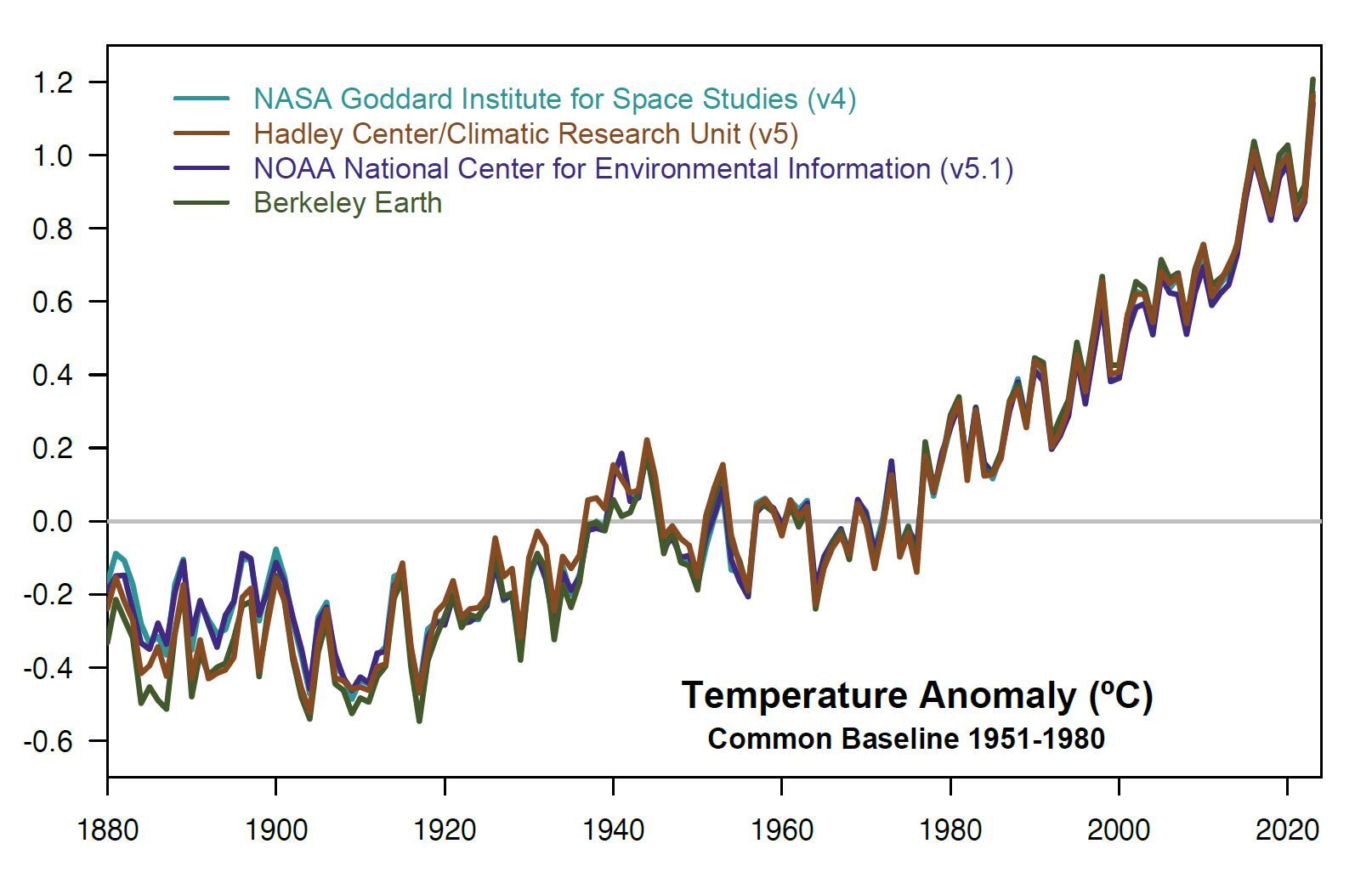
It’s important to remember that scientists always focus on the evidence, not on opinions. Scientific evidence continues to show that human activities ( primarily the human burning of fossil fuels ) have warmed Earth’s surface and its ocean basins, which in turn have continued to impact Earth’s climate . This is based on over a century of scientific evidence forming the structural backbone of today's civilization.
NASA Global Climate Change presents the state of scientific knowledge about climate change while highlighting the role NASA plays in better understanding our home planet. This effort includes citing multiple peer-reviewed studies from research groups across the world, 1 illustrating the accuracy and consensus of research results (in this case, the scientific consensus on climate change) consistent with NASA’s scientific research portfolio.
With that said, multiple studies published in peer-reviewed scientific journals 1 show that climate-warming trends over the past century are extremely likely due to human activities. In addition, most of the leading scientific organizations worldwide have issued public statements endorsing this position. The following is a partial list of these organizations, along with links to their published statements and a selection of related resources.
American Scientific Societies
Statement on climate change from 18 scientific associations.
"Observations throughout the world make it clear that climate change is occurring, and rigorous scientific research demonstrates that the greenhouse gases emitted by human activities are the primary driver." (2009) 2
American Association for the Advancement of Science
"Based on well-established evidence, about 97% of climate scientists have concluded that human-caused climate change is happening." (2014) 3

American Chemical Society
"The Earth’s climate is changing in response to increasing concentrations of greenhouse gases (GHGs) and particulate matter in the atmosphere, largely as the result of human activities." (2016-2019) 4

American Geophysical Union
"Based on extensive scientific evidence, it is extremely likely that human activities, especially emissions of greenhouse gases, are the dominant cause of the observed warming since the mid-20th century. There is no alterative explanation supported by convincing evidence." (2019) 5
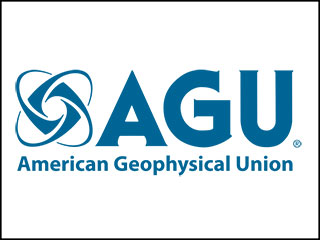
American Medical Association
"Our AMA ... supports the findings of the Intergovernmental Panel on Climate Change’s fourth assessment report and concurs with the scientific consensus that the Earth is undergoing adverse global climate change and that anthropogenic contributions are significant." (2019) 6

American Meteorological Society
"Research has found a human influence on the climate of the past several decades ... The IPCC (2013), USGCRP (2017), and USGCRP (2018) indicate that it is extremely likely that human influence has been the dominant cause of the observed warming since the mid-twentieth century." (2019) 7
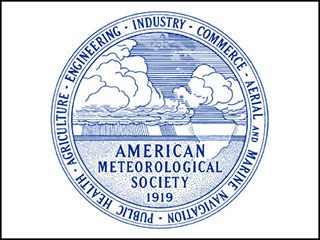
American Physical Society
"Earth's changing climate is a critical issue and poses the risk of significant environmental, social and economic disruptions around the globe. While natural sources of climate variability are significant, multiple lines of evidence indicate that human influences have had an increasingly dominant effect on global climate warming observed since the mid-twentieth century." (2015) 8

The Geological Society of America
"The Geological Society of America (GSA) concurs with assessments by the National Academies of Science (2005), the National Research Council (2011), the Intergovernmental Panel on Climate Change (IPCC, 2013) and the U.S. Global Change Research Program (Melillo et al., 2014) that global climate has warmed in response to increasing concentrations of carbon dioxide (CO2) and other greenhouse gases ... Human activities (mainly greenhouse-gas emissions) are the dominant cause of the rapid warming since the middle 1900s (IPCC, 2013)." (2015) 9
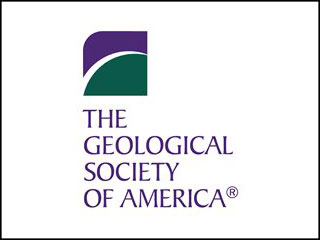
Science Academies
International academies: joint statement.
"Climate change is real. There will always be uncertainty in understanding a system as complex as the world’s climate. However there is now strong evidence that significant global warming is occurring. The evidence comes from direct measurements of rising surface air temperatures and subsurface ocean temperatures and from phenomena such as increases in average global sea levels, retreating glaciers, and changes to many physical and biological systems. It is likely that most of the warming in recent decades can be attributed to human activities (IPCC 2001)." (2005, 11 international science academies) 1 0
U.S. National Academy of Sciences
"Scientists have known for some time, from multiple lines of evidence, that humans are changing Earth’s climate, primarily through greenhouse gas emissions." 1 1

U.S. Government Agencies
U.s. global change research program.
"Earth’s climate is now changing faster than at any point in the history of modern civilization, primarily as a result of human activities." (2018, 13 U.S. government departments and agencies) 12

Intergovernmental Bodies
Intergovernmental panel on climate change.
“It is unequivocal that the increase of CO 2 , methane, and nitrous oxide in the atmosphere over the industrial era is the result of human activities and that human influence is the principal driver of many changes observed across the atmosphere, ocean, cryosphere, and biosphere. “Since systematic scientific assessments began in the 1970s, the influence of human activity on the warming of the climate system has evolved from theory to established fact.” 1 3-17
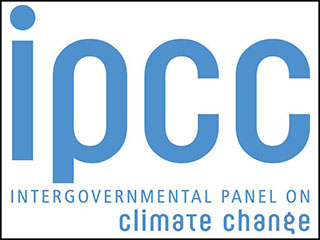
Other Resources
List of worldwide scientific organizations.
The following page lists the nearly 200 worldwide scientific organizations that hold the position that climate change has been caused by human action. http://www.opr.ca.gov/facts/list-of-scientific-organizations.html
U.S. Agencies
The following page contains information on what federal agencies are doing to adapt to climate change. https://www.c2es.org/site/assets/uploads/2012/02/climate-change-adaptation-what-federal-agencies-are-doing.pdf
Technically, a “consensus” is a general agreement of opinion, but the scientific method steers us away from this to an objective framework. In science, facts or observations are explained by a hypothesis (a statement of a possible explanation for some natural phenomenon), which can then be tested and retested until it is refuted (or disproved).
As scientists gather more observations, they will build off one explanation and add details to complete the picture. Eventually, a group of hypotheses might be integrated and generalized into a scientific theory, a scientifically acceptable general principle or body of principles offered to explain phenomena.
1. K. Myers, et al, "Consensus revisited: quantifying scientific agreement on climate change and climate expertise among Earth scientists 10 years later", Environmental Research Letters Vol.16 No. 10, 104030 (20 October 2021); DOI:10.1088/1748-9326/ac2774 M. Lynas, et al, "Greater than 99% consensus on human caused climate change in the peer-reviewed scientific literature", Environmental Research Letters Vol.16 No. 11, 114005 (19 October 2021); DOI:10.1088/1748-9326/ac2966 J. Cook et al., "Consensus on consensus: a synthesis of consensus estimates on human-caused global warming", Environmental Research Letters Vol. 11 No. 4, (13 April 2016); DOI:10.1088/1748-9326/11/4/048002 J. Cook et al., "Quantifying the consensus on anthropogenic global warming in the scientific literature", Environmental Research Letters Vol. 8 No. 2, (15 May 2013); DOI:10.1088/1748-9326/8/2/024024 W. R. L. Anderegg, “Expert Credibility in Climate Change”, Proceedings of the National Academy of Sciences Vol. 107 No. 27, 12107-12109 (21 June 2010); DOI: 10.1073/pnas.1003187107 P. T. Doran & M. K. Zimmerman, "Examining the Scientific Consensus on Climate Change", Eos Transactions American Geophysical Union Vol. 90 Issue 3 (2009), 22; DOI: 10.1029/2009EO030002 N. Oreskes, “Beyond the Ivory Tower: The Scientific Consensus on Climate Change”, Science Vol. 306 no. 5702, p. 1686 (3 December 2004); DOI: 10.1126/science.1103618
2. Statement on climate change from 18 scientific associations (2009)
3. AAAS Board Statement on Climate Change (2014)
4. ACS Public Policy Statement: Climate Change (2016-2019)
5. Society Must Address the Growing Climate Crisis Now (2019)
6. Global Climate Change and Human Health (2019)
7. Climate Change: An Information Statement of the American Meteorological Society (2019)
8. American Physical Society (2021)
9. GSA Position Statement on Climate Change (2015)
10. Joint science academies' statement: Global response to climate change (2005)
11. Climate at the National Academies
12. Fourth National Climate Assessment: Volume II (2018)
13. IPCC Fifth Assessment Report, Summary for Policymakers, SPM 1.1 (2014)
14. IPCC Fifth Assessment Report, Summary for Policymakers, SPM 1 (2014)
15. IPCC Sixth Assessment Report, Working Group 1 (2021)
16. IPCC Sixth Assessment Report, Working Group 2 (2022)
17. IPCC Sixth Assessment Report, Working Group 3 (2022)
Discover More Topics From NASA
Explore Earth Science

Earth Science in Action

Earth Science Data

Facts About Earth

- Study Guides
- Homework Questions
Research Essay Outline
- Health Science

Climate Change: Evidence and Causes: Update 2020 (2020)
Chapter: conclusion, c onclusion.
This document explains that there are well-understood physical mechanisms by which changes in the amounts of greenhouse gases cause climate changes. It discusses the evidence that the concentrations of these gases in the atmosphere have increased and are still increasing rapidly, that climate change is occurring, and that most of the recent change is almost certainly due to emissions of greenhouse gases caused by human activities. Further climate change is inevitable; if emissions of greenhouse gases continue unabated, future changes will substantially exceed those that have occurred so far. There remains a range of estimates of the magnitude and regional expression of future change, but increases in the extremes of climate that can adversely affect natural ecosystems and human activities and infrastructure are expected.
Citizens and governments can choose among several options (or a mixture of those options) in response to this information: they can change their pattern of energy production and usage in order to limit emissions of greenhouse gases and hence the magnitude of climate changes; they can wait for changes to occur and accept the losses, damage, and suffering that arise; they can adapt to actual and expected changes as much as possible; or they can seek as yet unproven “geoengineering” solutions to counteract some of the climate changes that would otherwise occur. Each of these options has risks, attractions and costs, and what is actually done may be a mixture of these different options. Different nations and communities will vary in their vulnerability and their capacity to adapt. There is an important debate to be had about choices among these options, to decide what is best for each group or nation, and most importantly for the global population as a whole. The options have to be discussed at a global scale because in many cases those communities that are most vulnerable control few of the emissions, either past or future. Our description of the science of climate change, with both its facts and its uncertainties, is offered as a basis to inform that policy debate.
A CKNOWLEDGEMENTS
The following individuals served as the primary writing team for the 2014 and 2020 editions of this document:
- Eric Wolff FRS, (UK lead), University of Cambridge
- Inez Fung (NAS, US lead), University of California, Berkeley
- Brian Hoskins FRS, Grantham Institute for Climate Change
- John F.B. Mitchell FRS, UK Met Office
- Tim Palmer FRS, University of Oxford
- Benjamin Santer (NAS), Lawrence Livermore National Laboratory
- John Shepherd FRS, University of Southampton
- Keith Shine FRS, University of Reading.
- Susan Solomon (NAS), Massachusetts Institute of Technology
- Kevin Trenberth, National Center for Atmospheric Research
- John Walsh, University of Alaska, Fairbanks
- Don Wuebbles, University of Illinois
Staff support for the 2020 revision was provided by Richard Walker, Amanda Purcell, Nancy Huddleston, and Michael Hudson. We offer special thanks to Rebecca Lindsey and NOAA Climate.gov for providing data and figure updates.
The following individuals served as reviewers of the 2014 document in accordance with procedures approved by the Royal Society and the National Academy of Sciences:
- Richard Alley (NAS), Department of Geosciences, Pennsylvania State University
- Alec Broers FRS, Former President of the Royal Academy of Engineering
- Harry Elderfield FRS, Department of Earth Sciences, University of Cambridge
- Joanna Haigh FRS, Professor of Atmospheric Physics, Imperial College London
- Isaac Held (NAS), NOAA Geophysical Fluid Dynamics Laboratory
- John Kutzbach (NAS), Center for Climatic Research, University of Wisconsin
- Jerry Meehl, Senior Scientist, National Center for Atmospheric Research
- John Pendry FRS, Imperial College London
- John Pyle FRS, Department of Chemistry, University of Cambridge
- Gavin Schmidt, NASA Goddard Space Flight Center
- Emily Shuckburgh, British Antarctic Survey
- Gabrielle Walker, Journalist
- Andrew Watson FRS, University of East Anglia
The Support for the 2014 Edition was provided by NAS Endowment Funds. We offer sincere thanks to the Ralph J. and Carol M. Cicerone Endowment for NAS Missions for supporting the production of this 2020 Edition.
F OR FURTHER READING
For more detailed discussion of the topics addressed in this document (including references to the underlying original research), see:
- Intergovernmental Panel on Climate Change (IPCC), 2019: Special Report on the Ocean and Cryosphere in a Changing Climate [ https://www.ipcc.ch/srocc ]
- National Academies of Sciences, Engineering, and Medicine (NASEM), 2019: Negative Emissions Technologies and Reliable Sequestration: A Research Agenda [ https://www.nap.edu/catalog/25259 ]
- Royal Society, 2018: Greenhouse gas removal [ https://raeng.org.uk/greenhousegasremoval ]
- U.S. Global Change Research Program (USGCRP), 2018: Fourth National Climate Assessment Volume II: Impacts, Risks, and Adaptation in the United States [ https://nca2018.globalchange.gov ]
- IPCC, 2018: Global Warming of 1.5°C [ https://www.ipcc.ch/sr15 ]
- USGCRP, 2017: Fourth National Climate Assessment Volume I: Climate Science Special Reports [ https://science2017.globalchange.gov ]
- NASEM, 2016: Attribution of Extreme Weather Events in the Context of Climate Change [ https://www.nap.edu/catalog/21852 ]
- IPCC, 2013: Fifth Assessment Report (AR5) Working Group 1. Climate Change 2013: The Physical Science Basis [ https://www.ipcc.ch/report/ar5/wg1 ]
- NRC, 2013: Abrupt Impacts of Climate Change: Anticipating Surprises [ https://www.nap.edu/catalog/18373 ]
- NRC, 2011: Climate Stabilization Targets: Emissions, Concentrations, and Impacts Over Decades to Millennia [ https://www.nap.edu/catalog/12877 ]
- Royal Society 2010: Climate Change: A Summary of the Science [ https://royalsociety.org/topics-policy/publications/2010/climate-change-summary-science ]
- NRC, 2010: America’s Climate Choices: Advancing the Science of Climate Change [ https://www.nap.edu/catalog/12782 ]
Much of the original data underlying the scientific findings discussed here are available at:
- https://data.ucar.edu/
- https://climatedataguide.ucar.edu
- https://iridl.ldeo.columbia.edu
- https://ess-dive.lbl.gov/
- https://www.ncdc.noaa.gov/
- https://www.esrl.noaa.gov/gmd/ccgg/trends/
- http://scrippsco2.ucsd.edu
- http://hahana.soest.hawaii.edu/hot/

Climate change is one of the defining issues of our time. It is now more certain than ever, based on many lines of evidence, that humans are changing Earth's climate. The Royal Society and the US National Academy of Sciences, with their similar missions to promote the use of science to benefit society and to inform critical policy debates, produced the original Climate Change: Evidence and Causes in 2014. It was written and reviewed by a UK-US team of leading climate scientists. This new edition, prepared by the same author team, has been updated with the most recent climate data and scientific analyses, all of which reinforce our understanding of human-caused climate change.
Scientific information is a vital component for society to make informed decisions about how to reduce the magnitude of climate change and how to adapt to its impacts. This booklet serves as a key reference document for decision makers, policy makers, educators, and others seeking authoritative answers about the current state of climate-change science.
Welcome to OpenBook!
You're looking at OpenBook, NAP.edu's online reading room since 1999. Based on feedback from you, our users, we've made some improvements that make it easier than ever to read thousands of publications on our website.
Do you want to take a quick tour of the OpenBook's features?
Show this book's table of contents , where you can jump to any chapter by name.
...or use these buttons to go back to the previous chapter or skip to the next one.
Jump up to the previous page or down to the next one. Also, you can type in a page number and press Enter to go directly to that page in the book.
Switch between the Original Pages , where you can read the report as it appeared in print, and Text Pages for the web version, where you can highlight and search the text.
To search the entire text of this book, type in your search term here and press Enter .
Share a link to this book page on your preferred social network or via email.
View our suggested citation for this chapter.
Ready to take your reading offline? Click here to buy this book in print or download it as a free PDF, if available.
Get Email Updates
Do you enjoy reading reports from the Academies online for free ? Sign up for email notifications and we'll let you know about new publications in your areas of interest when they're released.

IMAGES
VIDEO
COMMENTS
For example, Pittock noted that climate change has been a major cause of water shortages in most parts of the world (Pittock 2009, p. 108). He however attributed this to a number of factors, including precipitation decrease in some regions, high rates of evaporation in the world and general loss of glaciers.
The effects of climate change are most apparent in the world's coldest regions—the poles. The Arctic is heating up twice as fast as anywhere else on earth, leading to the rapid melting of ...
200 Words Essay on Climate Change. The climate of the Earth has changed significantly over time. While some of these changes were brought on by natural events like volcanic eruptions, floods, forest fires, etc., many of the changes were brought on by human activity. The burning of fossil fuels, domesticating livestock, and other human ...
Climate change refers to the change in the environmental conditions of the earth. This happens due to many internal and external factors. The climatic change has become a global concern over the last few decades. Besides, these climatic changes affect life on the earth in various ways. These climatic changes are having various impacts on the ...
The emission of. greenhouse gases has increased dramatically from the industrial revolution, mostly from the. burning of fossil fuels for energy, agriculture, industrial process, and transportation (Ecological. Impacts of Climate Change). The graph on the next page shows how much CO2 and methane.
Essay Writing Service. There are two main causes of climate changes - natural causes and human activities. Natural causes have influenced the earth's climates such as volcanic eruptions, ocean current, the earth's orbital changes and solar variations. The eruptions of volcanoes cause a cooling effect on the earth.
Global climate change is not a future problem. Changes to Earth's climate driven by increased human emissions of heat-trapping greenhouse gases are already having widespread effects on the environment: glaciers and ice sheets are shrinking, river and lake ice is breaking up earlier, plant and animal geographic ranges are shifting, and plants and trees are blooming sooner.
The papers in this section advance our thinking about the effects of climate change on ecosystem properties (biological diversity, trophic webs or energy flux, nutrient cycling or material flux) in different ecological communities (terrestrial plants, invertebrates in marine sediments, terrestrial soil microbes). ...
Climate change is defined as "a pattern of change affecting global or regional climate," based on "average temperature and rainfall measurements" as well as the frequency of extreme weather events. 1 These varied temperature and weather events link back to both natural incidents and human activity. 2 Likewise, the term global warming ...
Climate change is a long-term shift in global or regional climate patterns. Often climate change refers specifically to the rise in global temperatures from the mid-20th century to present. ... The warming of the planet impacts local and regional climates. Throughout Earth's history, climate has continually changed. When occuring naturally ...
Climate change is a long-term change in the average weather patterns that have come to define Earth's local, regional and global climates. These changes have a broad range of observed effects that are synonymous with the term. Changes observed in Earth's climate since the mid-20th century are driven by human activities, particularly fossil fuel burning, […]
Causes and Effects of Climate Change. Fossil fuels - coal, oil and gas - are by far the largest contributor to global climate change, accounting for over 75 per cent of global greenhouse gas ...
This climate change essay competition saw many students submitting well thought out pieces of writing. These essays were marked on their format, creativity, organisation, clarity, unity/development of thought, and grammar/mechanics. ... All in all, the human race's negative impact on climate and the environment is getting out control; the ...
In conclusion, climate change is the most significant problem facing the world. Global warming is increasing day by day. If we cannot prevent it as soon as possible, our world will face undesirable consequences. Artificial intelligence and machine learning, which have been quite advanced recently, is our immense weapon in the fight against ...
Abstract. Climate change is a long-lasting change in the weather arrays across tropics to polls. It is a global threat that has embarked on to put stress on various sectors. This study is aimed to conceptually engineer how climate variability is deteriorating the sustainability of diverse sectors worldwide.
Climate change can also impact human health by worsening air and water quality, increasing the spread of certain diseases, and altering the frequency or intensity of extreme weather events. 3. Rising sea level threatens coastal communities and ecosystems. 4. Changes in the patterns and amount of rainfall, as well as changes in the timing and ...
Increase in atmospheric temperature has serious consequences on biodiversity and ecosystems, and human wellbeing. The most important evidences of climate change is the long term data available on the CO levels, global temperature and weather patterns. The impacts of climate change in the coming decades are based on published models on the basis ...
Climate change is an unintended consequence of the industrialization of the world economy. The evidence that human activity has released large amounts of CO 2 into the atmosphere, leading to rising global temperatures, is by now uncontroversial. However, so far, the scientific and political recognition of this reality has not translated into a commitment to emissions reductions sufficient to ...
Climate change impacts health both directly and indirectly, and is strongly mediated by environmental, social and public health determinants. Although it is unequivocal that climate change affects human health, it remains challenging to accurately estimate the scale and impact of many climate-sensitive health risks. However, scientific advances ...
Climate change is also changing the way species and populations interact with the environment and one another. These impacts can be felt throughout an entire ecosystem. For example, climate change is increasing the spread of invasive species in some areas. 11 An invasive species is one that is not native to an area.
Climate change refers to long-term shifts in temperatures and weather patterns. Such shifts can be natural, due to changes in the sun's activity or large volcanic eruptions. But since the 1800s ...
Finally, James Hansen's 2012 paper, "Public perception of climate change and the new climate dice", was important in highlighting the real-world impacts of climate change, says Prof Andy Challinor, expert in climate change impacts at the University of Leeds and lead author on the food security chapter in the working group two report. He says:
This could make deaths due to wildfire smoke the costliest consequence of climate change for the country, accounting for nearly as much economic damage as all other climate-related impacts combined.
We do not have a prayer of reaching our climate goals without strong government research support. These three steps are hardly revolutionary in concept, but they are awesomely challenging politically. They are the best chance for the community of nations to prevent the growing threats to humans and the global environment of rapid climate change.
In his essay for the Carr Center's latest publication, Making a Movement: The History and Future of Human Rights, Henry Lee discusses the impacts of climate change on our human rights—and how we must ensure equity in our global contributions to climate adaptation. Henry Lee, Director, Environmental and Natural Resource Program, Belfer Center for Science and International Affairs; Senior ...
"The Geological Society of America (GSA) concurs with assessments by the National Academies of Science (2005), the National Research Council (2011), the Intergovernmental Panel on Climate Change (IPCC, 2013) and the U.S. Global Change Research Program (Melillo et al., 2014) that global climate has warmed in response to increasing concentrations of carbon dioxide (CO2) and other greenhouse ...
General impacts. When the IPCC Fourth Assessment Report was published in 2007, expert assessments concluded that over the last three decades, human-induced warming had likely had a discernible influence on many physical and biological systems, and that regional temperature trends had already affected species and ecosystems around the world. By the time of the Sixth Assessment Report, it was ...
HUMANS CAUSING CLIMATE CHANGE-TITLE I. Introduction - Climate change is a result of human activities. - The impact of climate change on the environment and animals. -This paper argues that climate change negatively impacts the environment due to human negligence in waste management.II. Body Paragraph 1 - Main idea: Burning of fossil fuels is a significant contributor to climate change ...
Climate change has myriad impacts on ecosystems, but the mechanisms by which it affects individual species can be difficult to pinpoint. One strategy to discover such mechanisms is to identify a specific ecological factor related to survival or reproduction and determine how that factor is affected by climate.
C ONCLUSION. This document explains that there are well-understood physical mechanisms by which changes in the amounts of greenhouse gases cause climate changes. It discusses the evidence that the concentrations of these gases in the atmosphere have increased and are still increasing rapidly, that climate change is occurring, and that most of ...